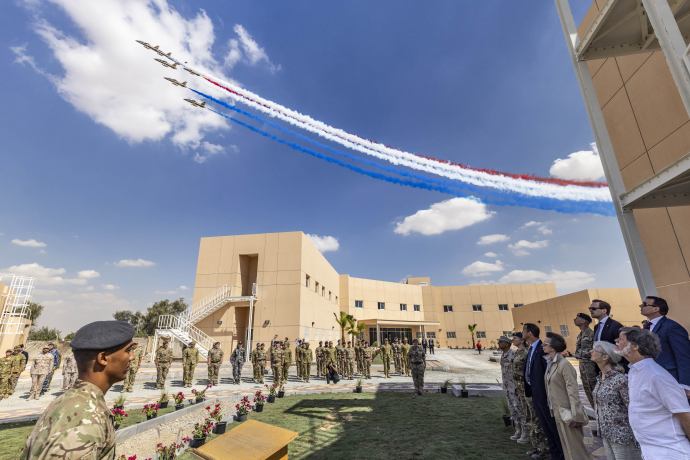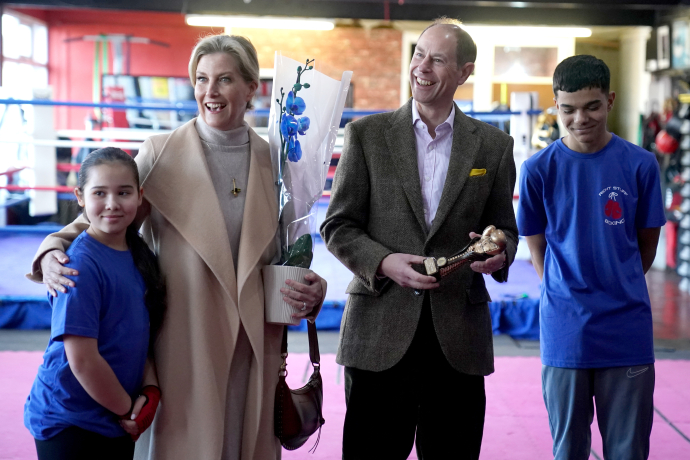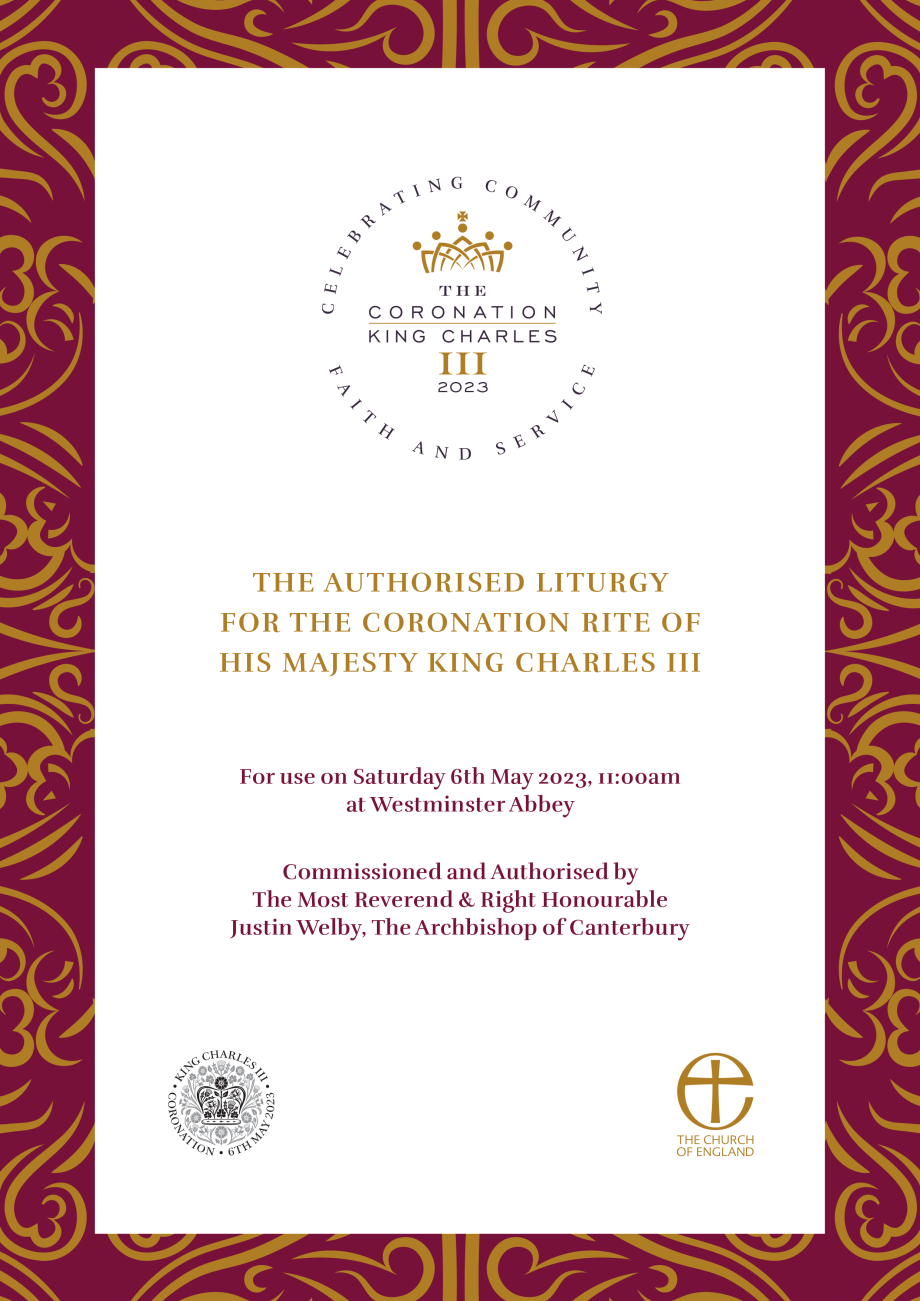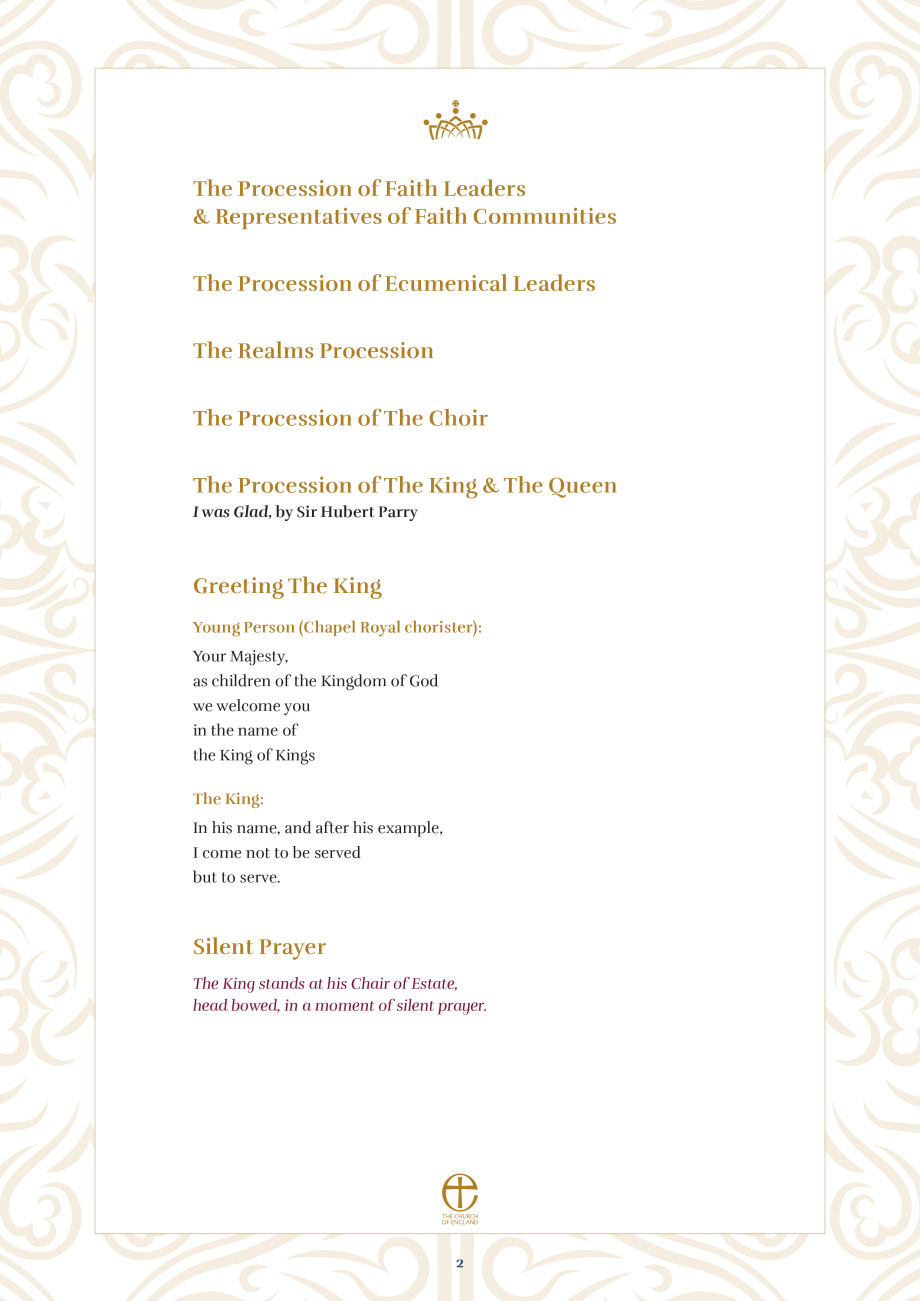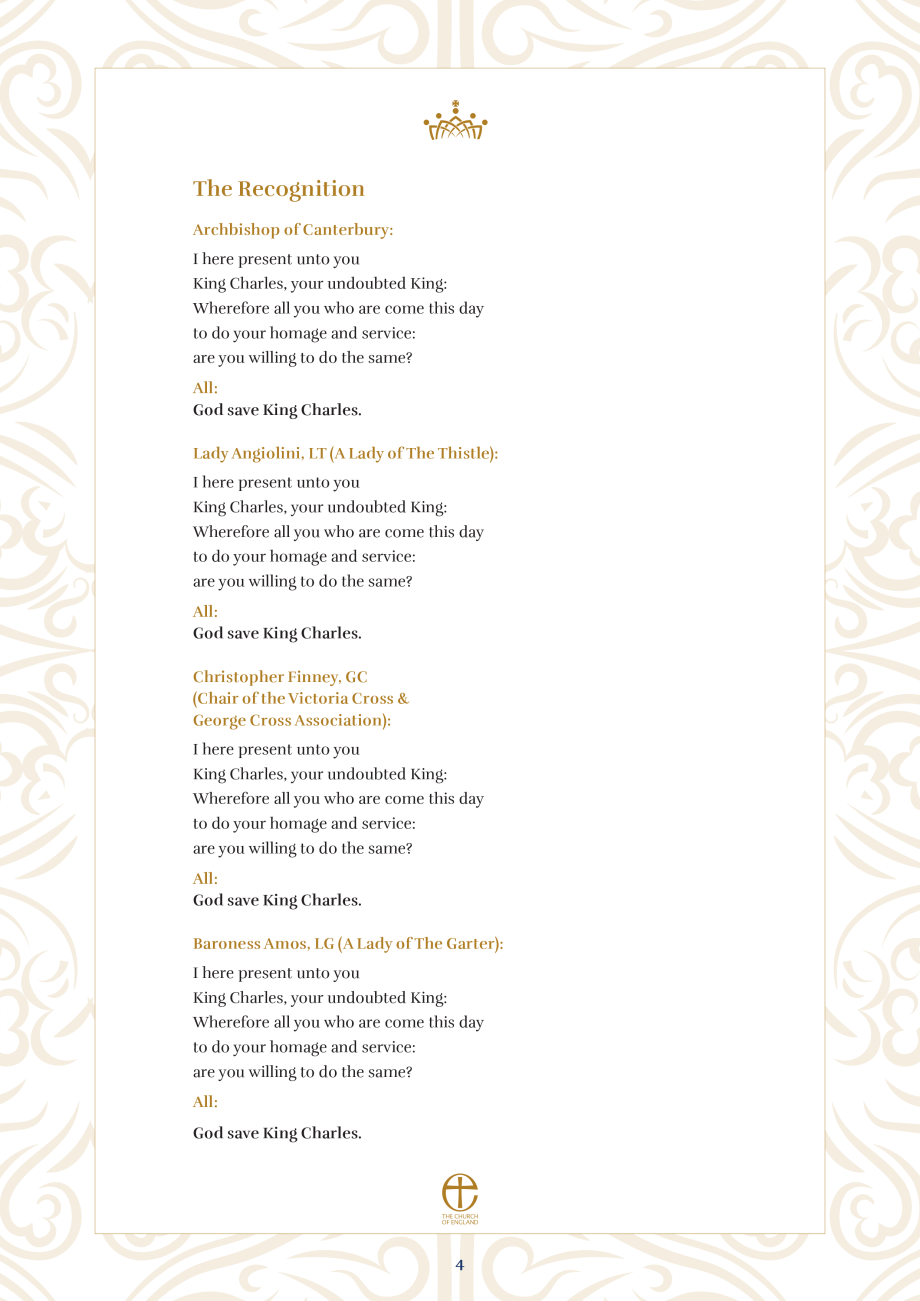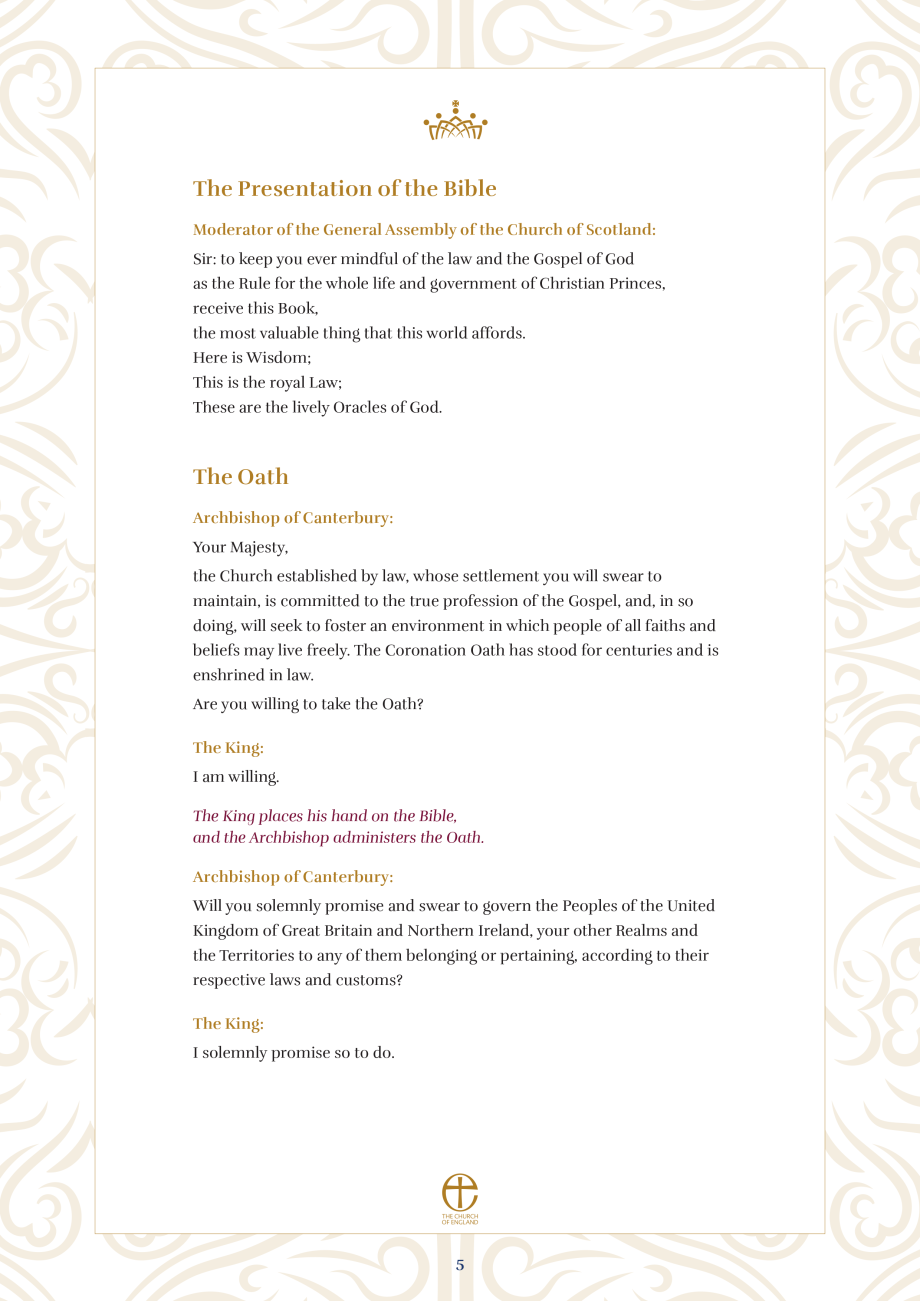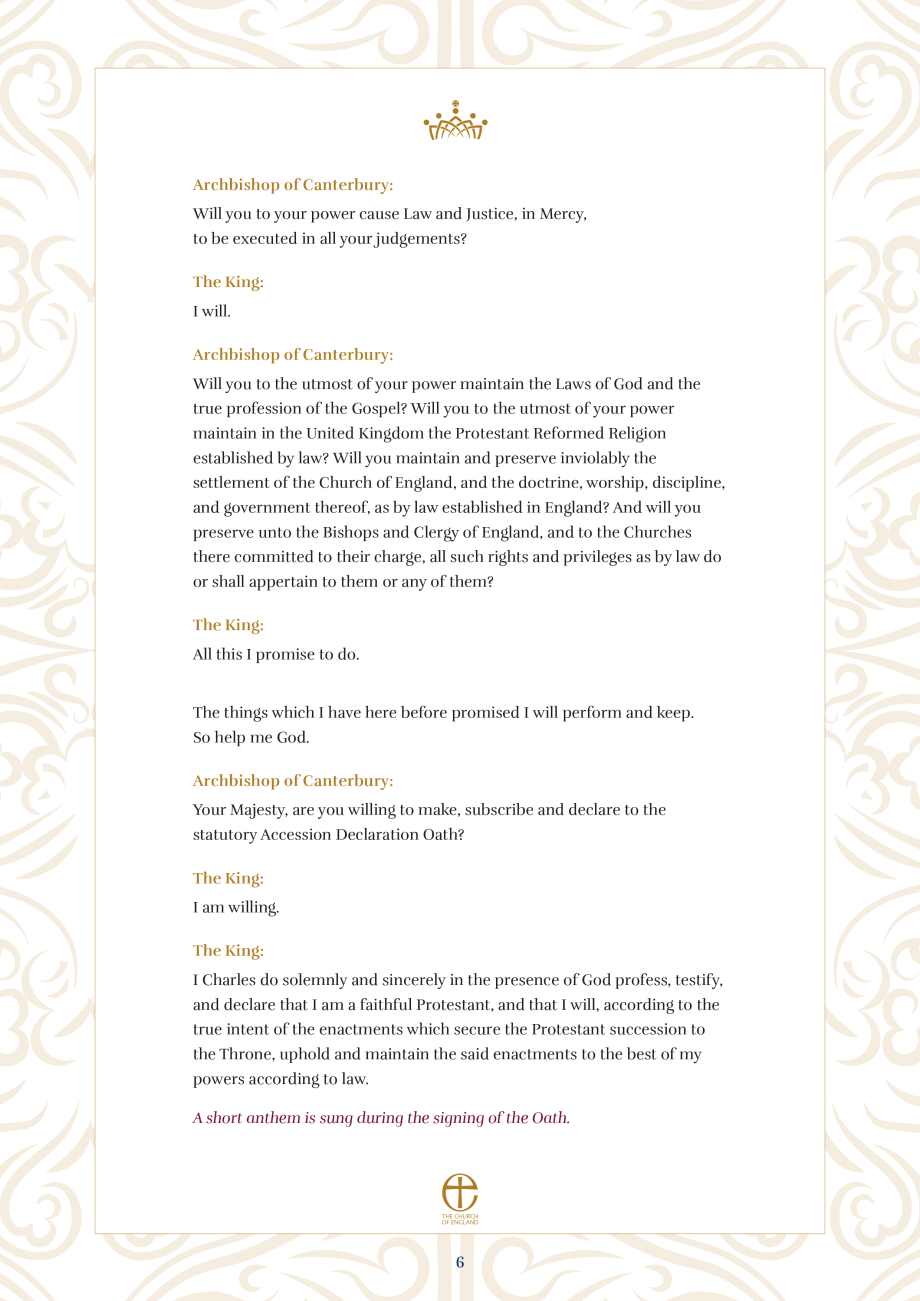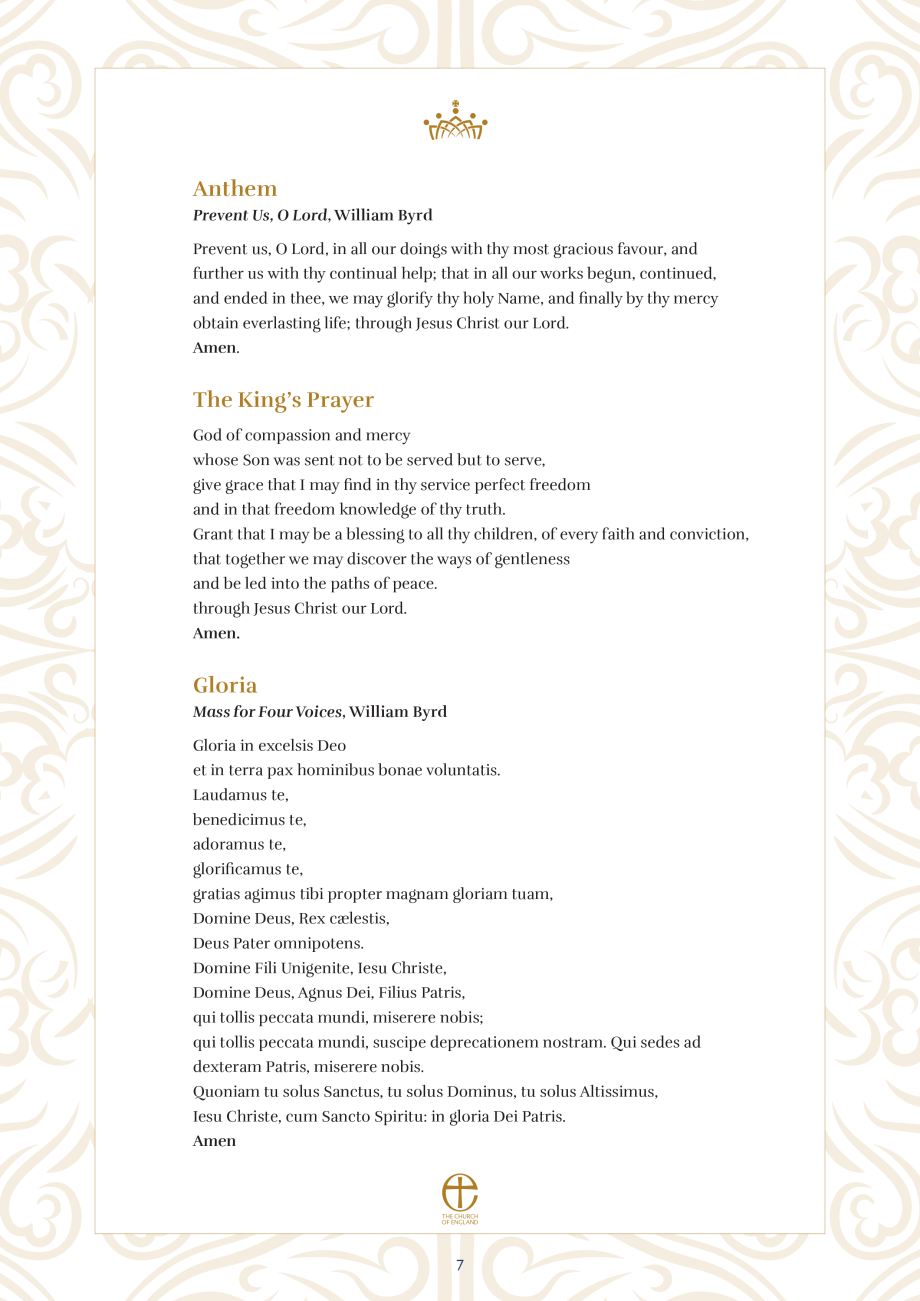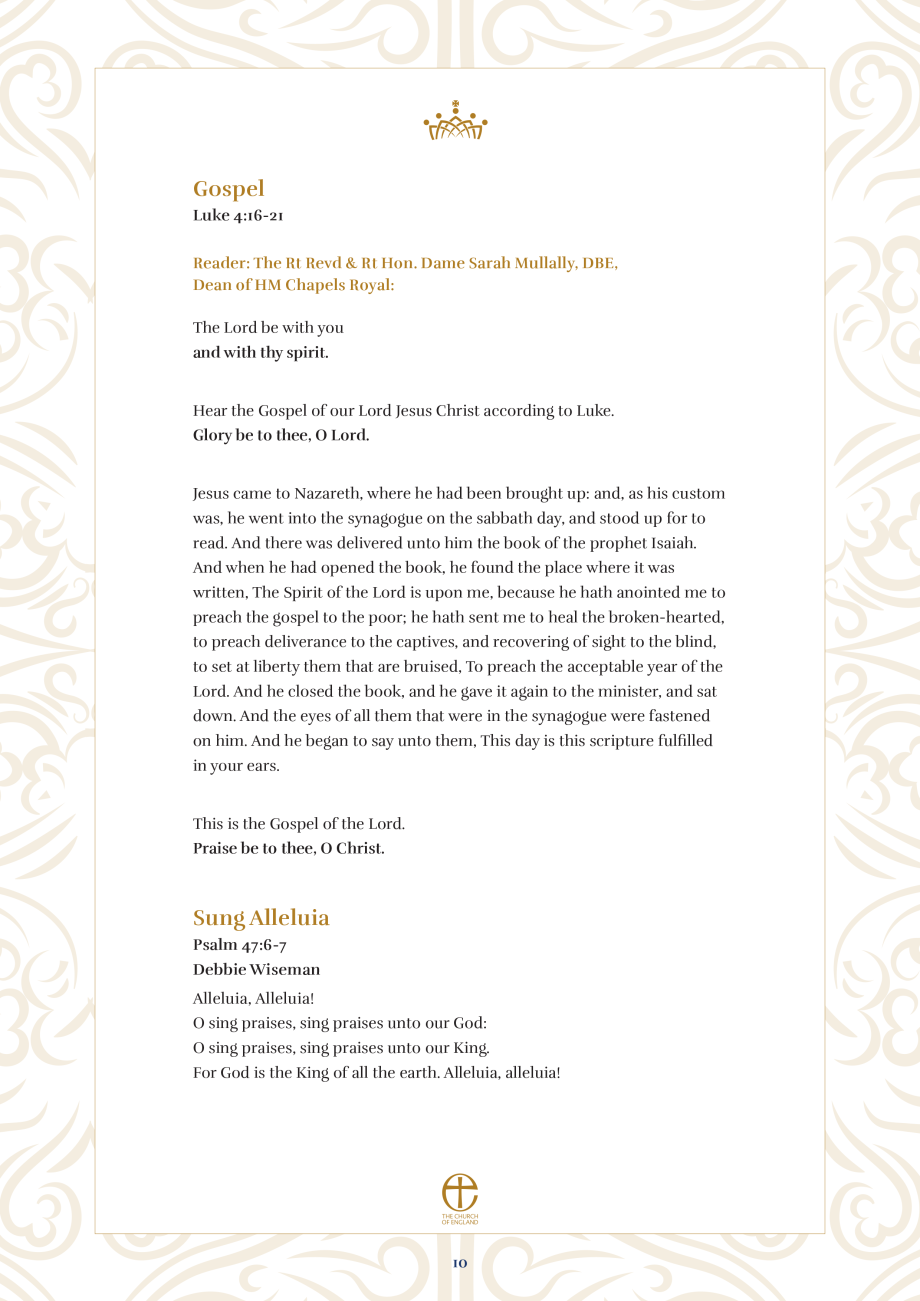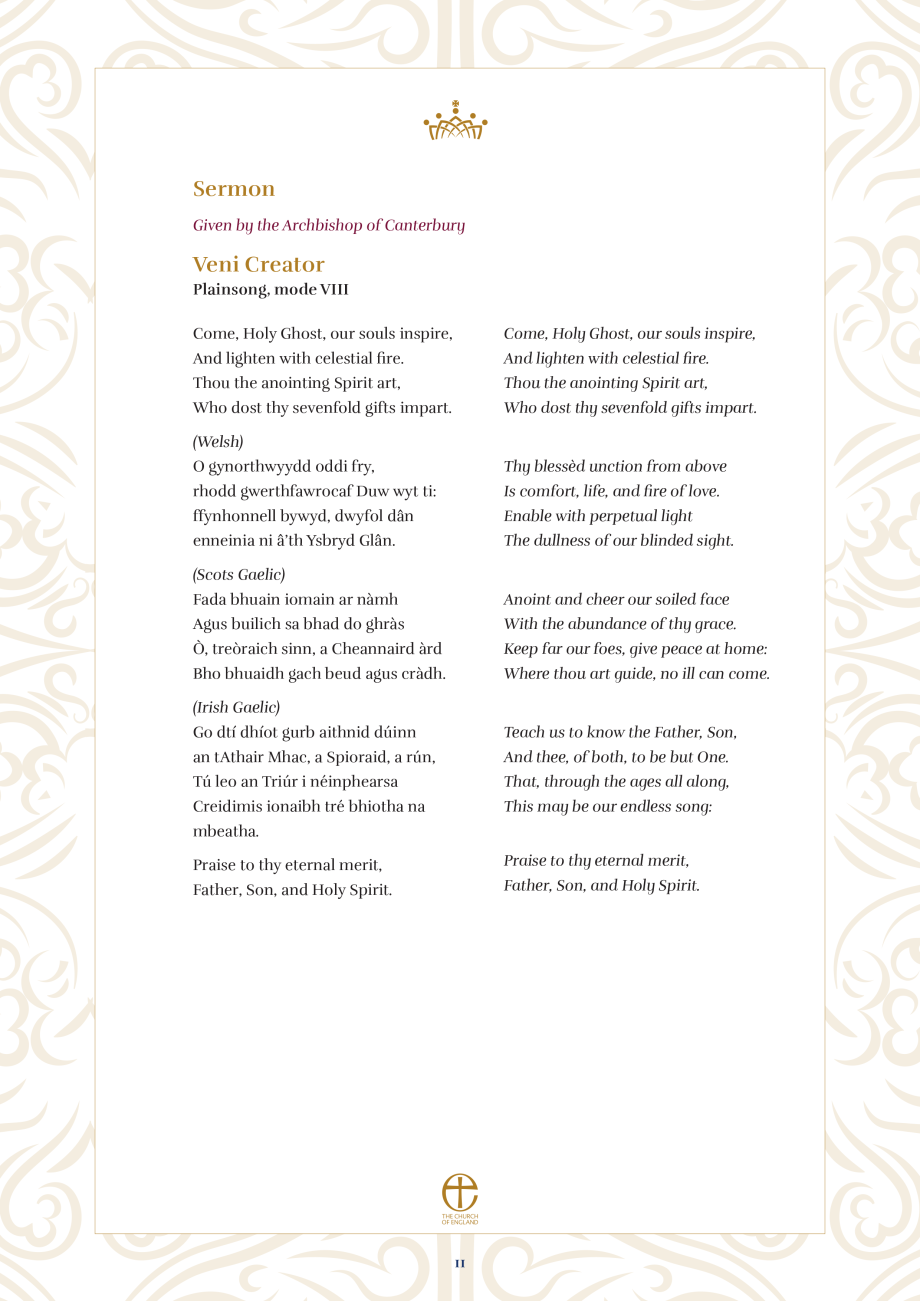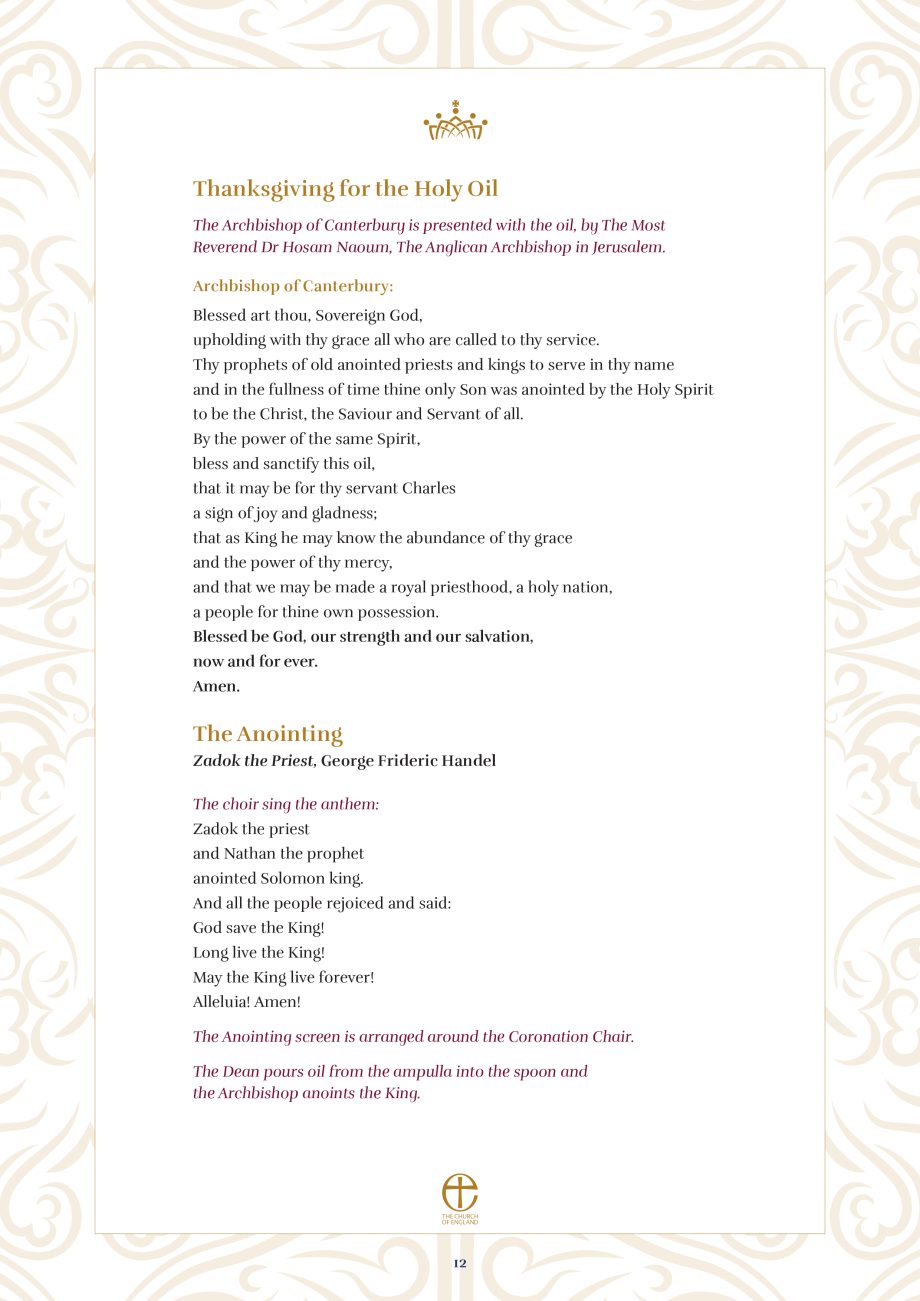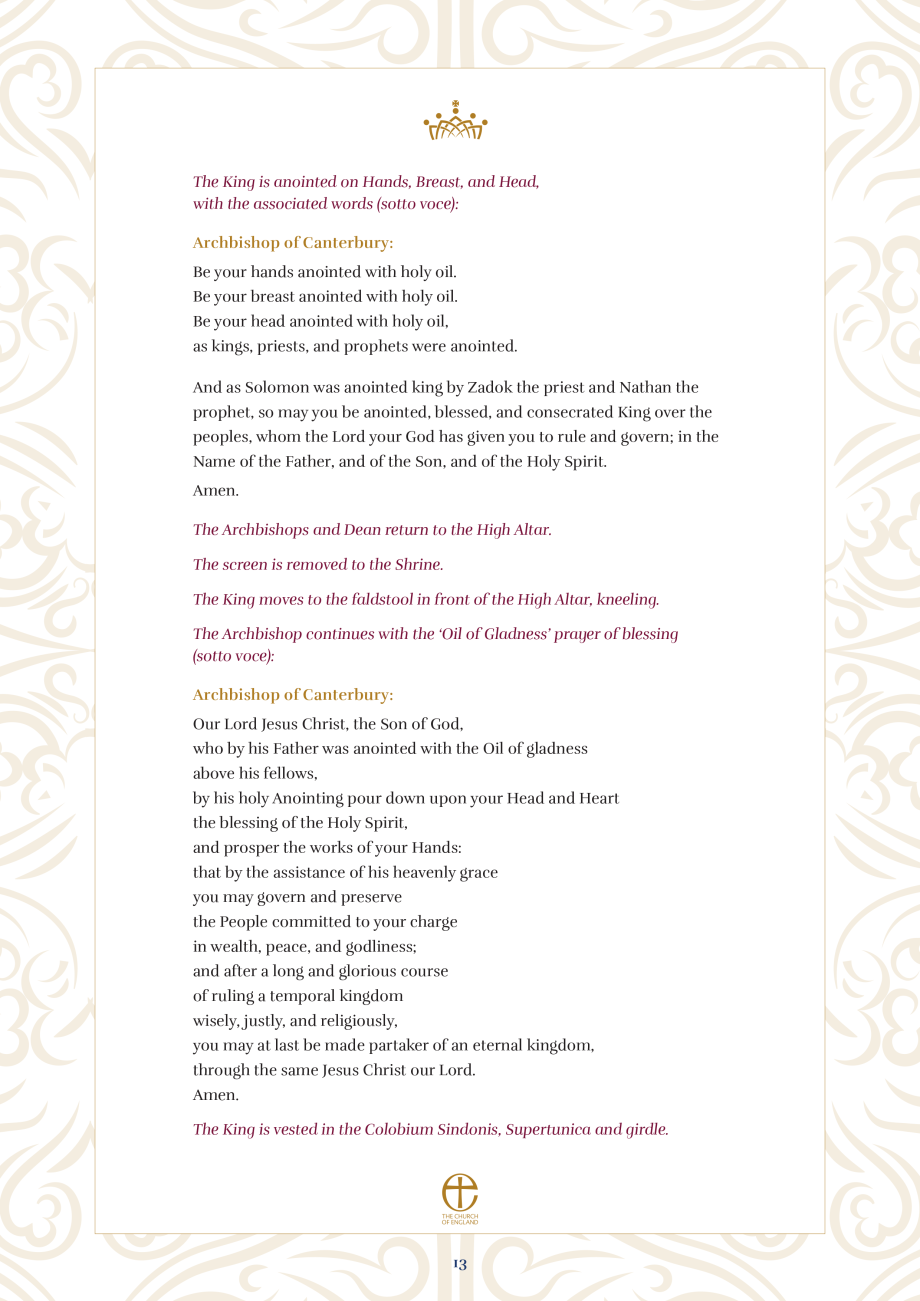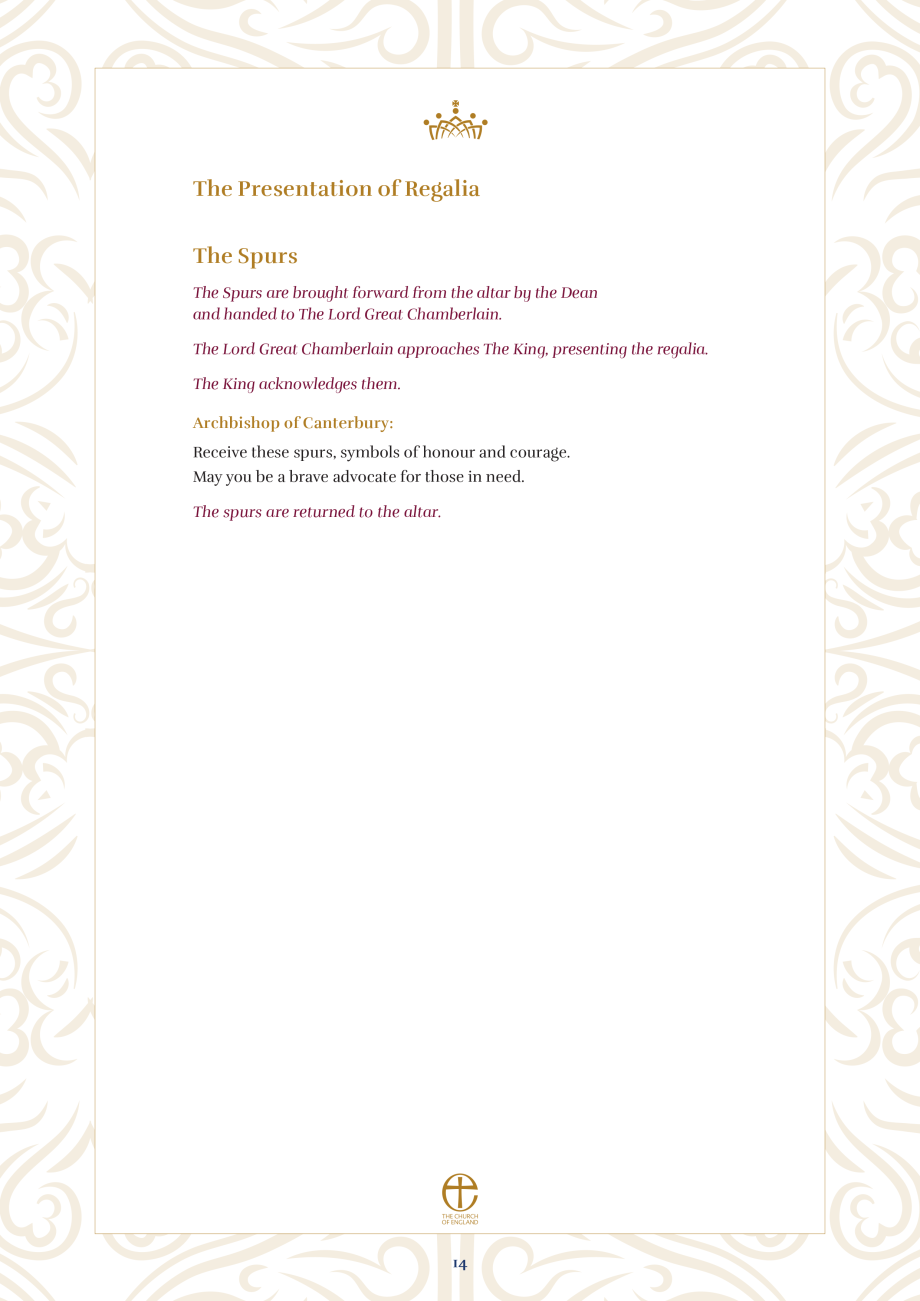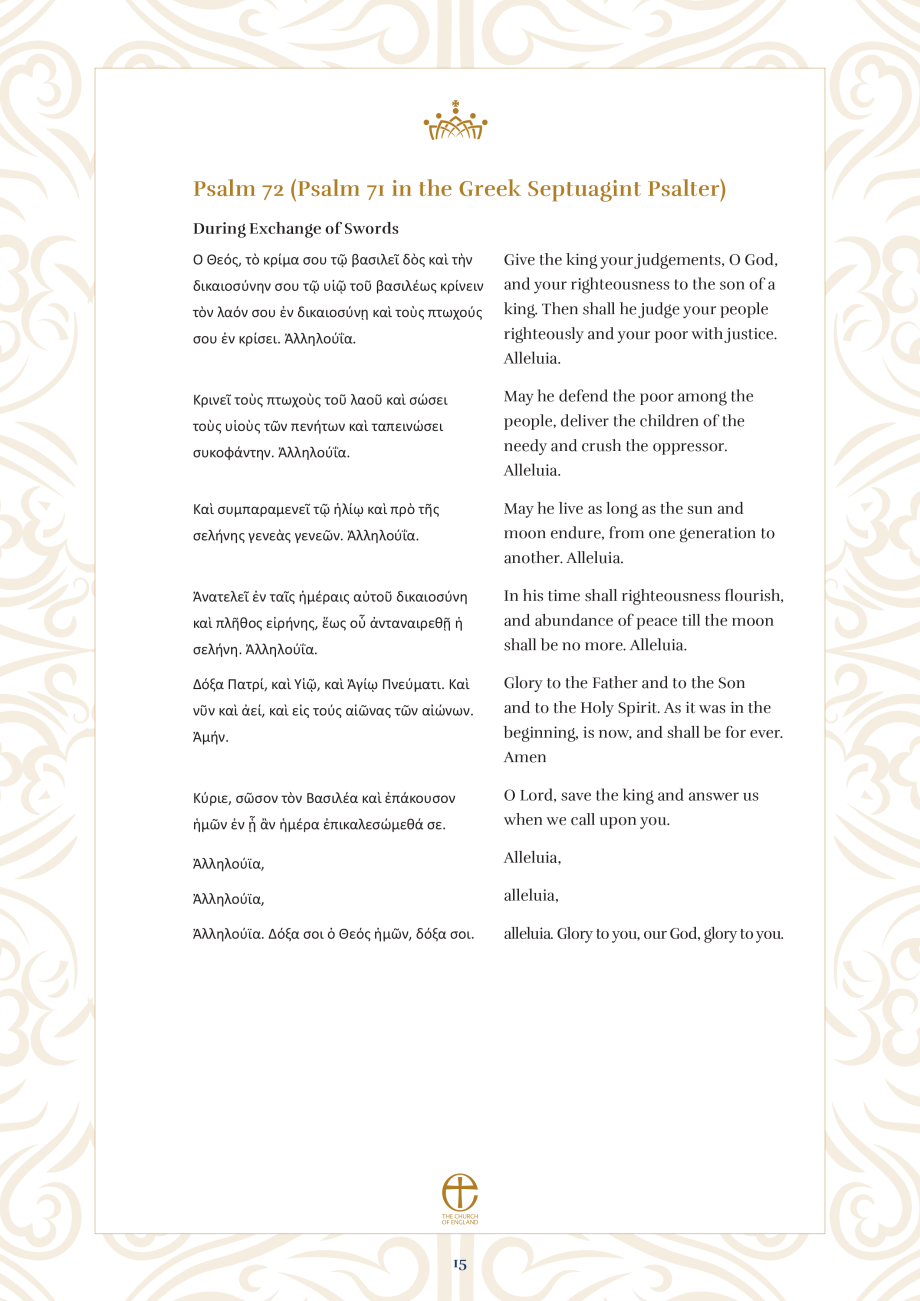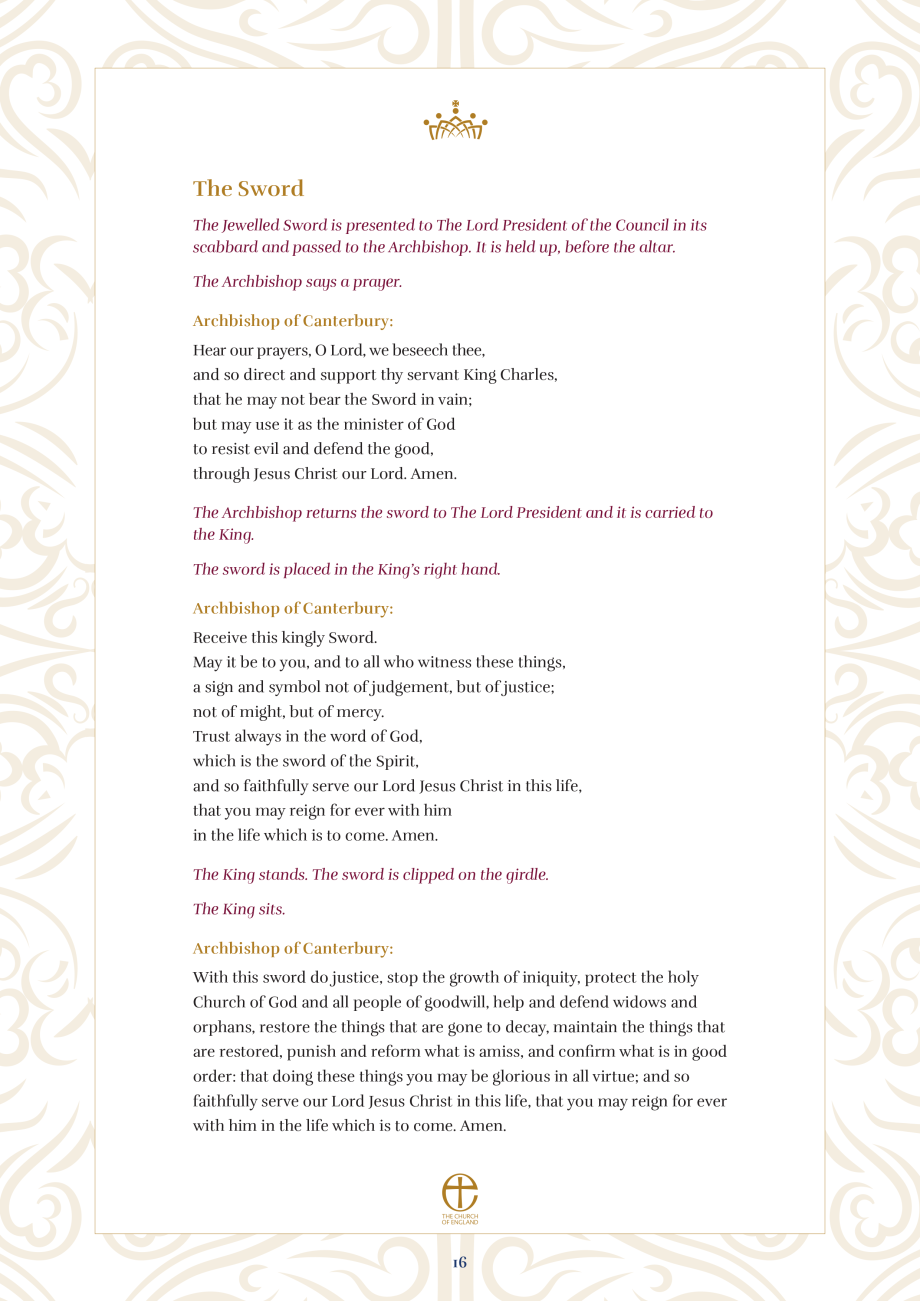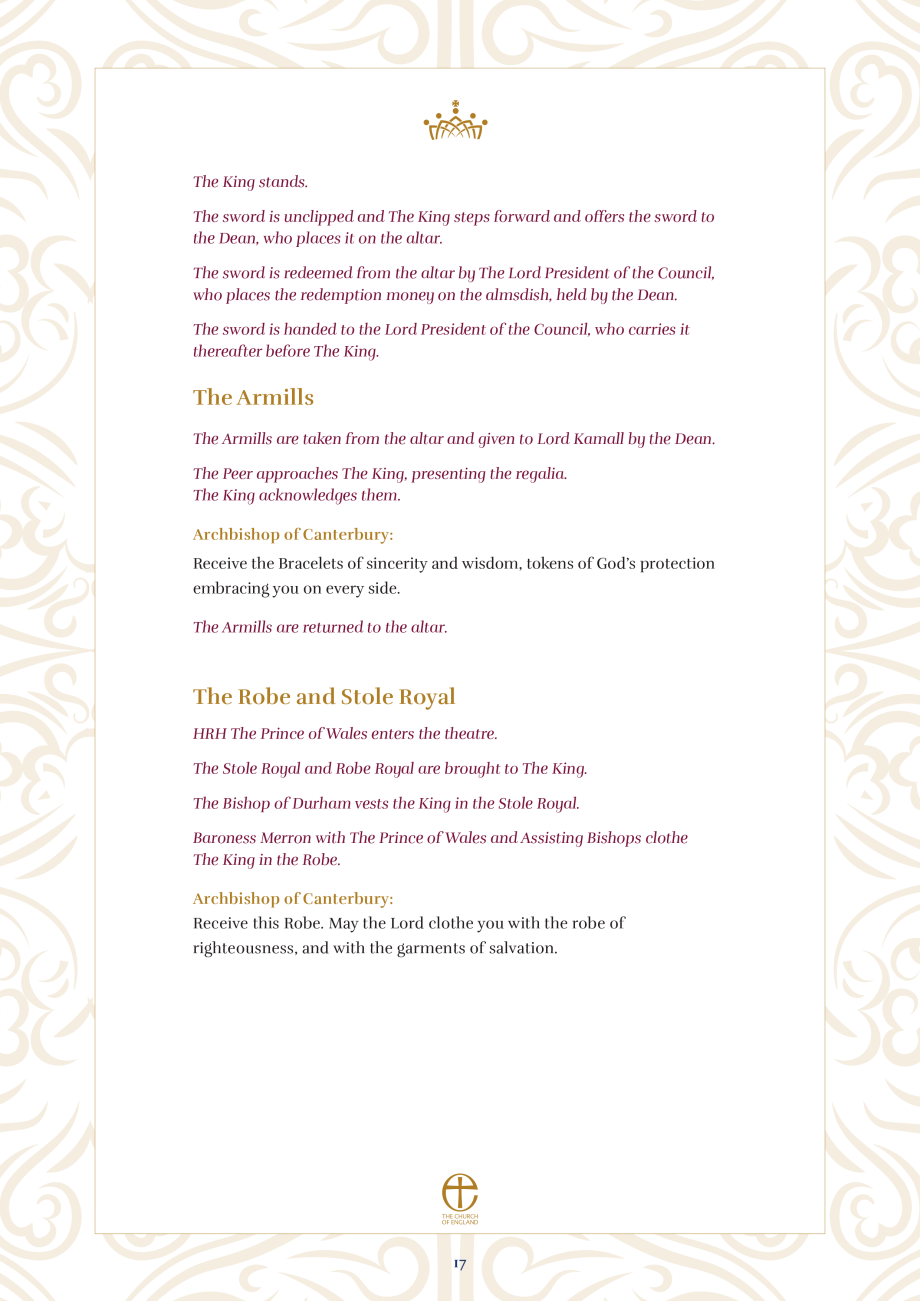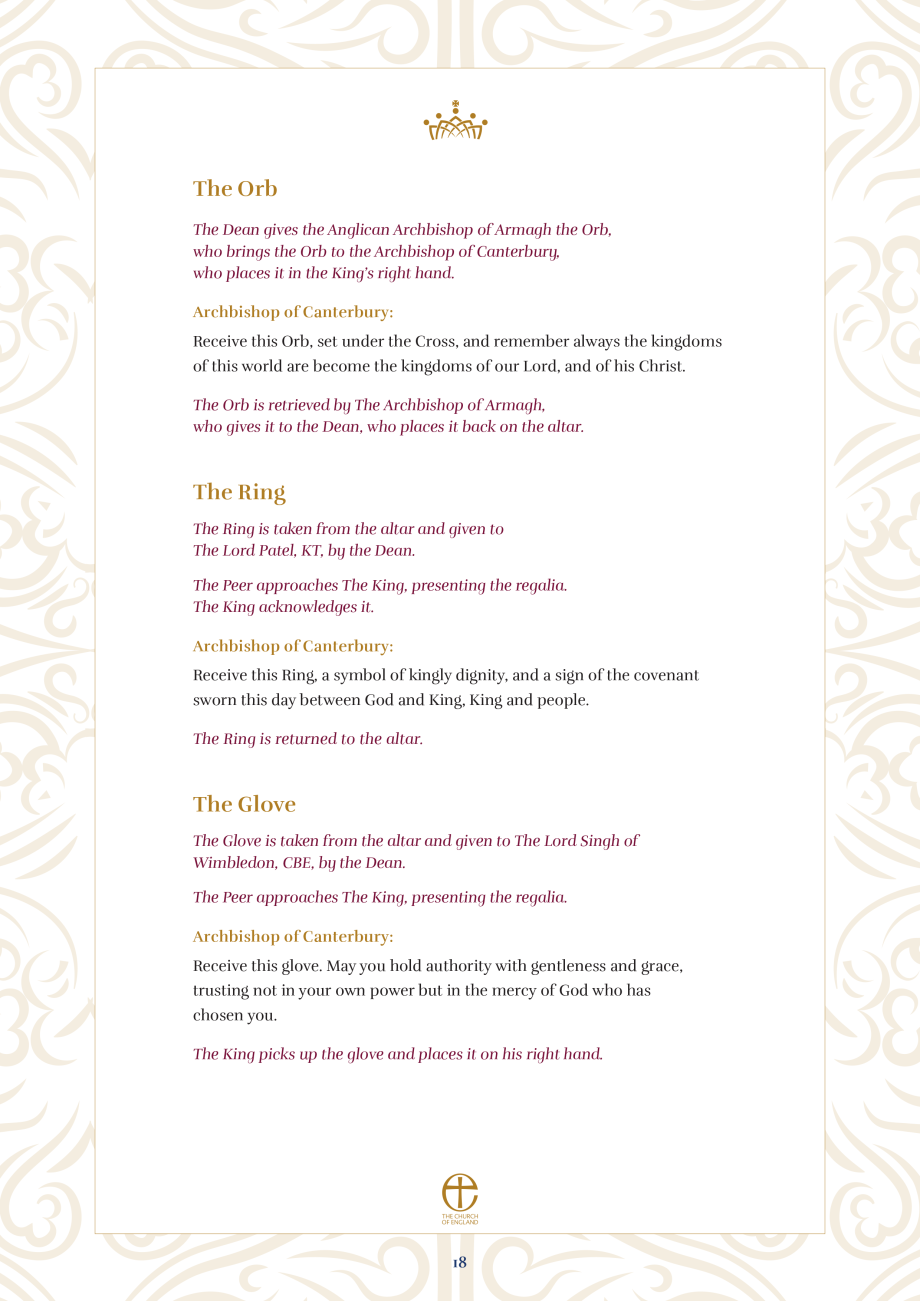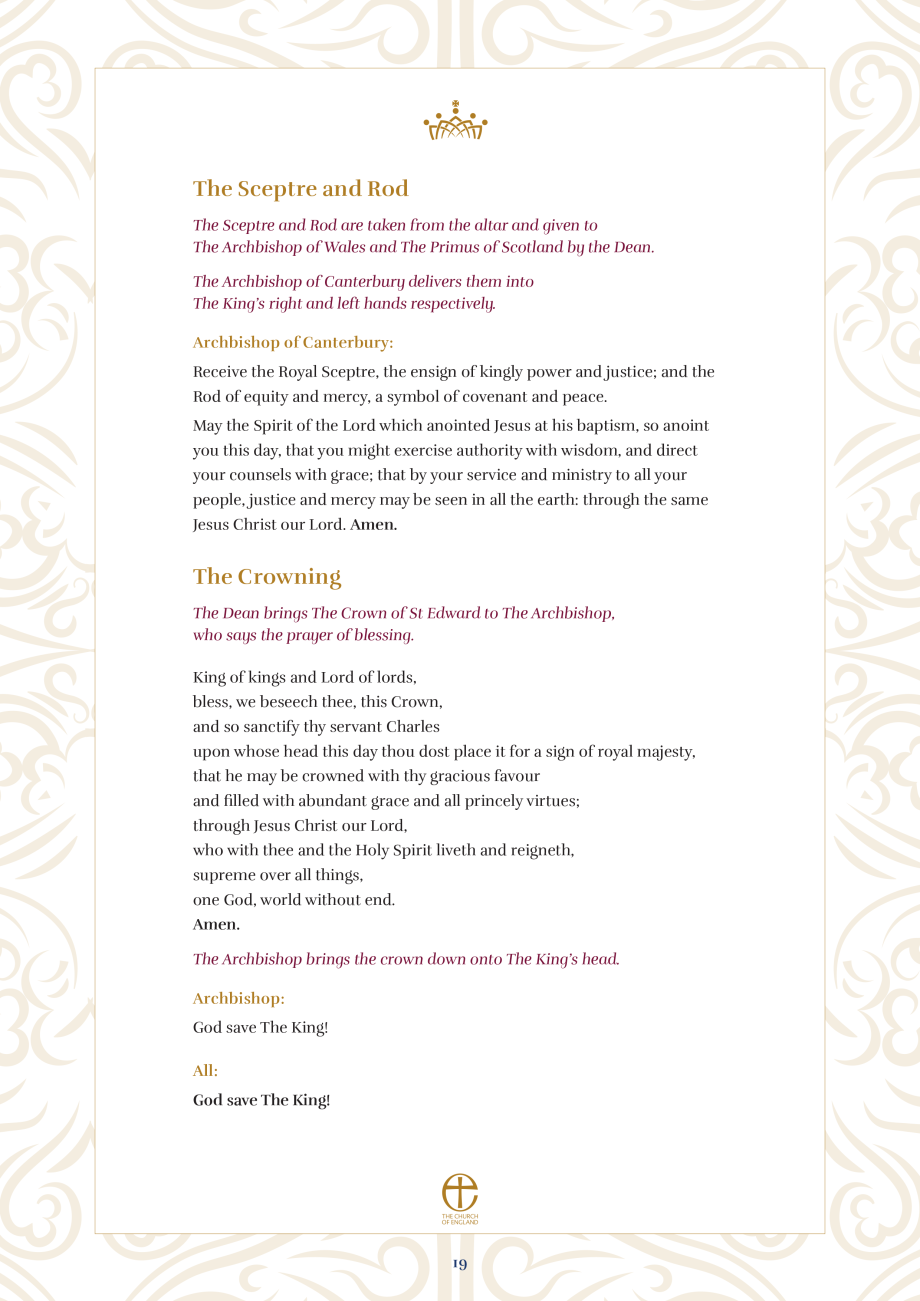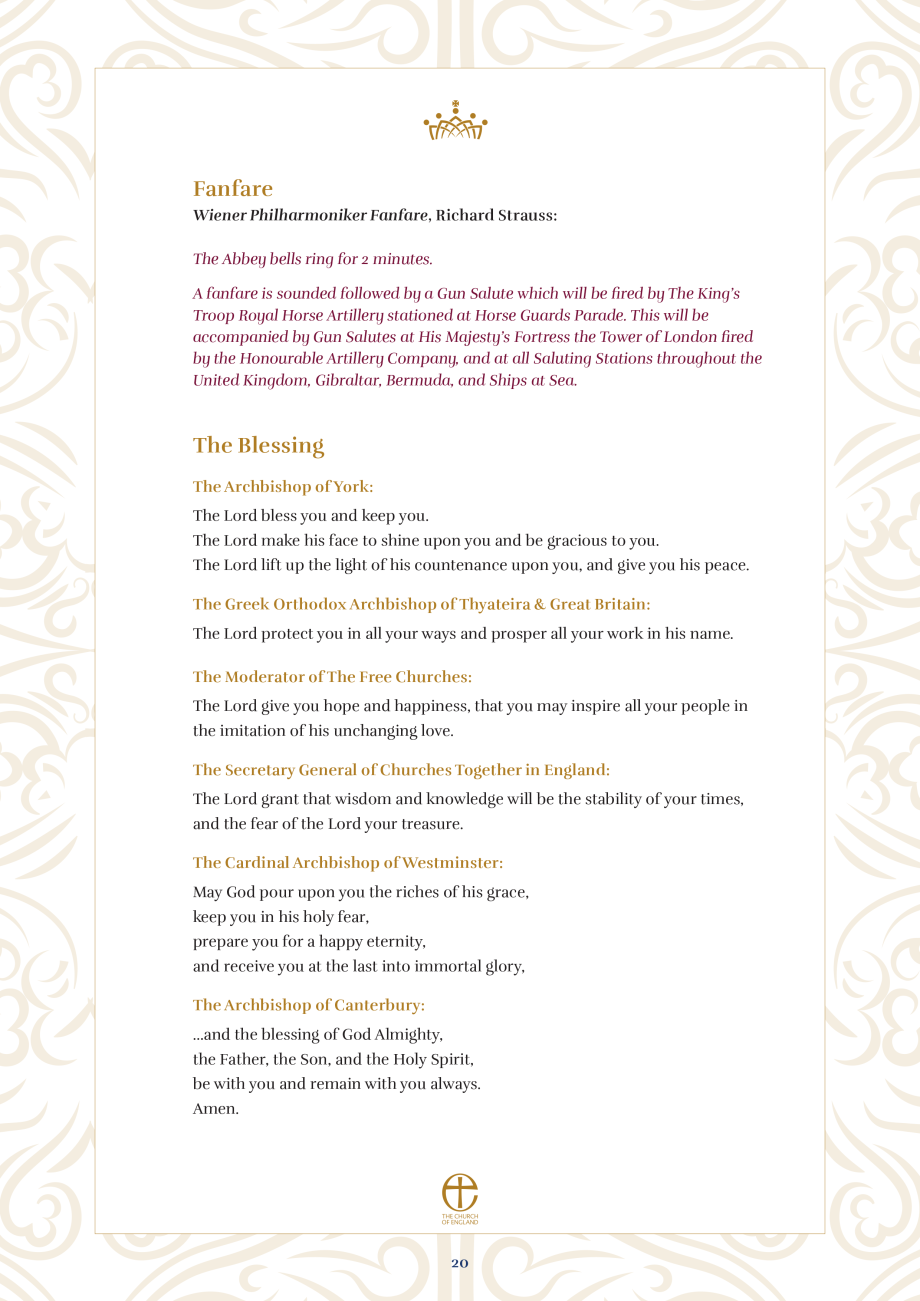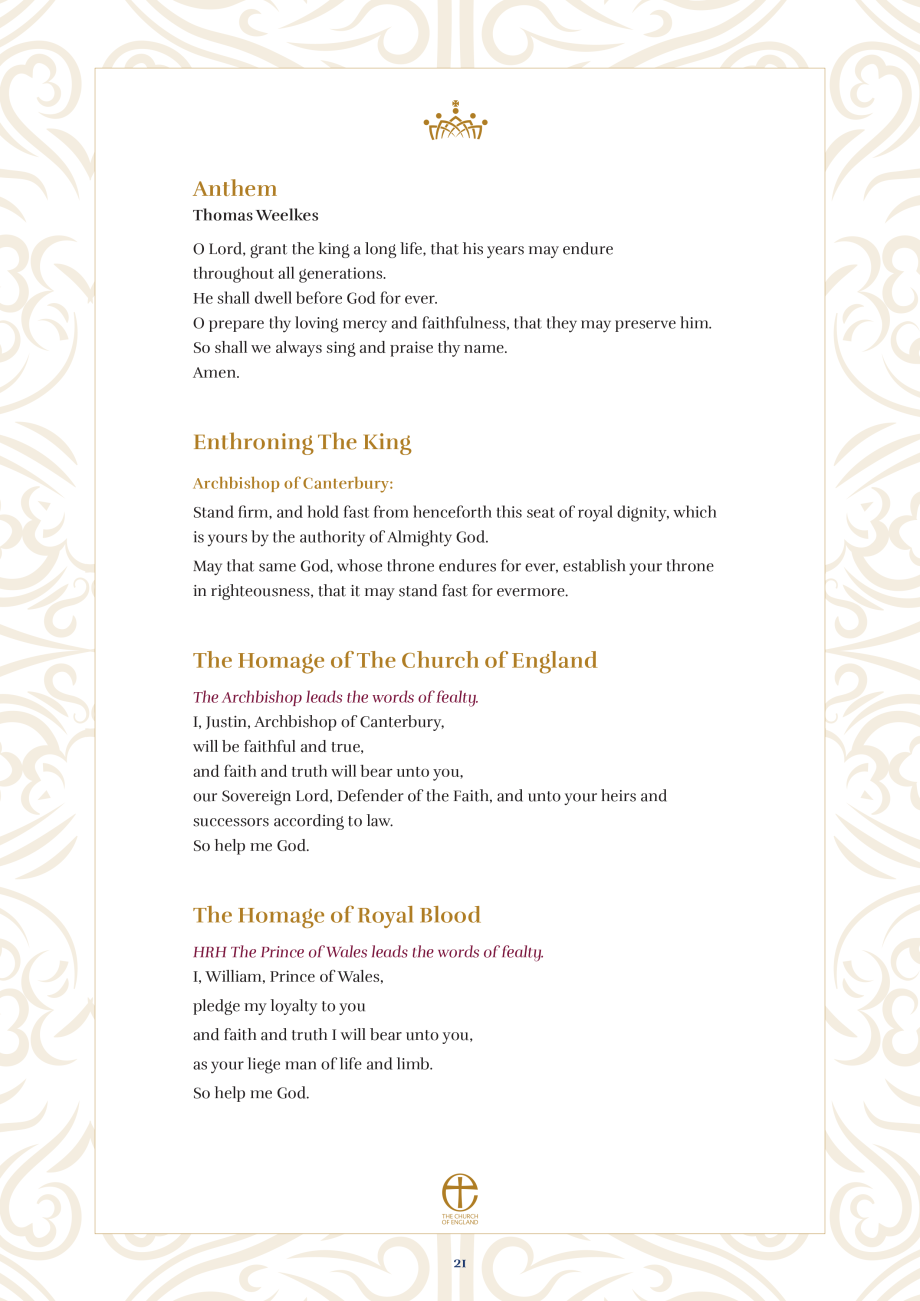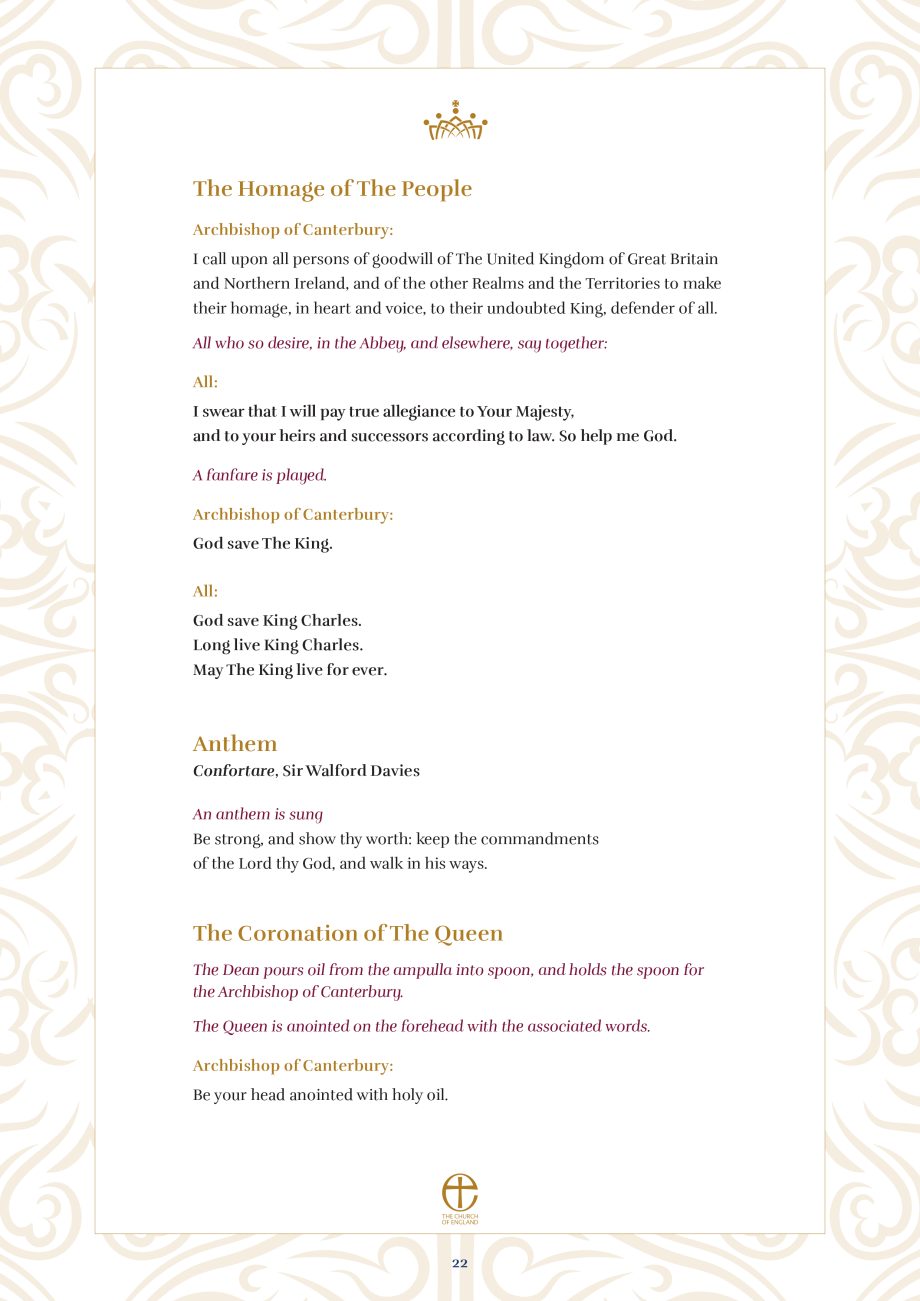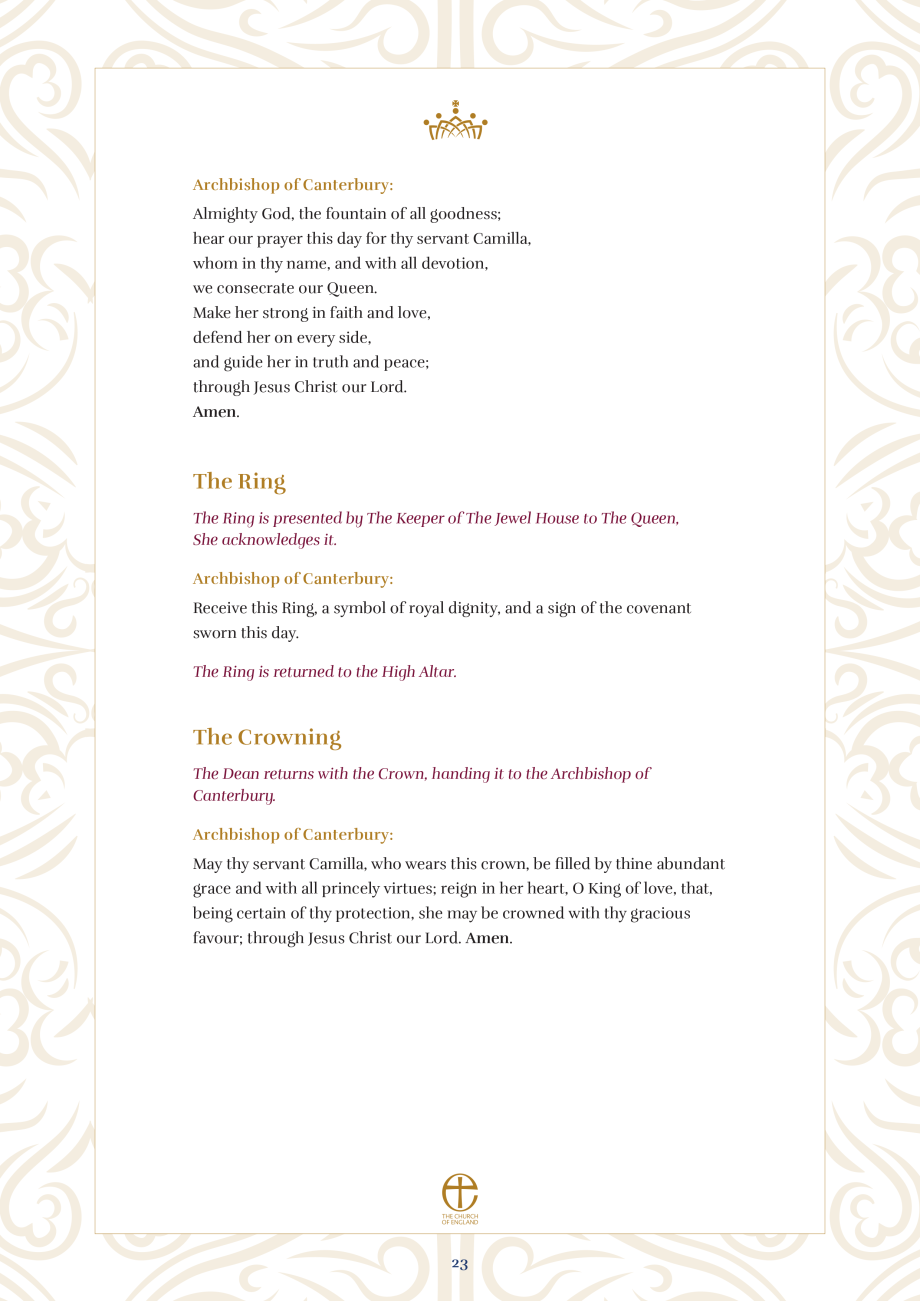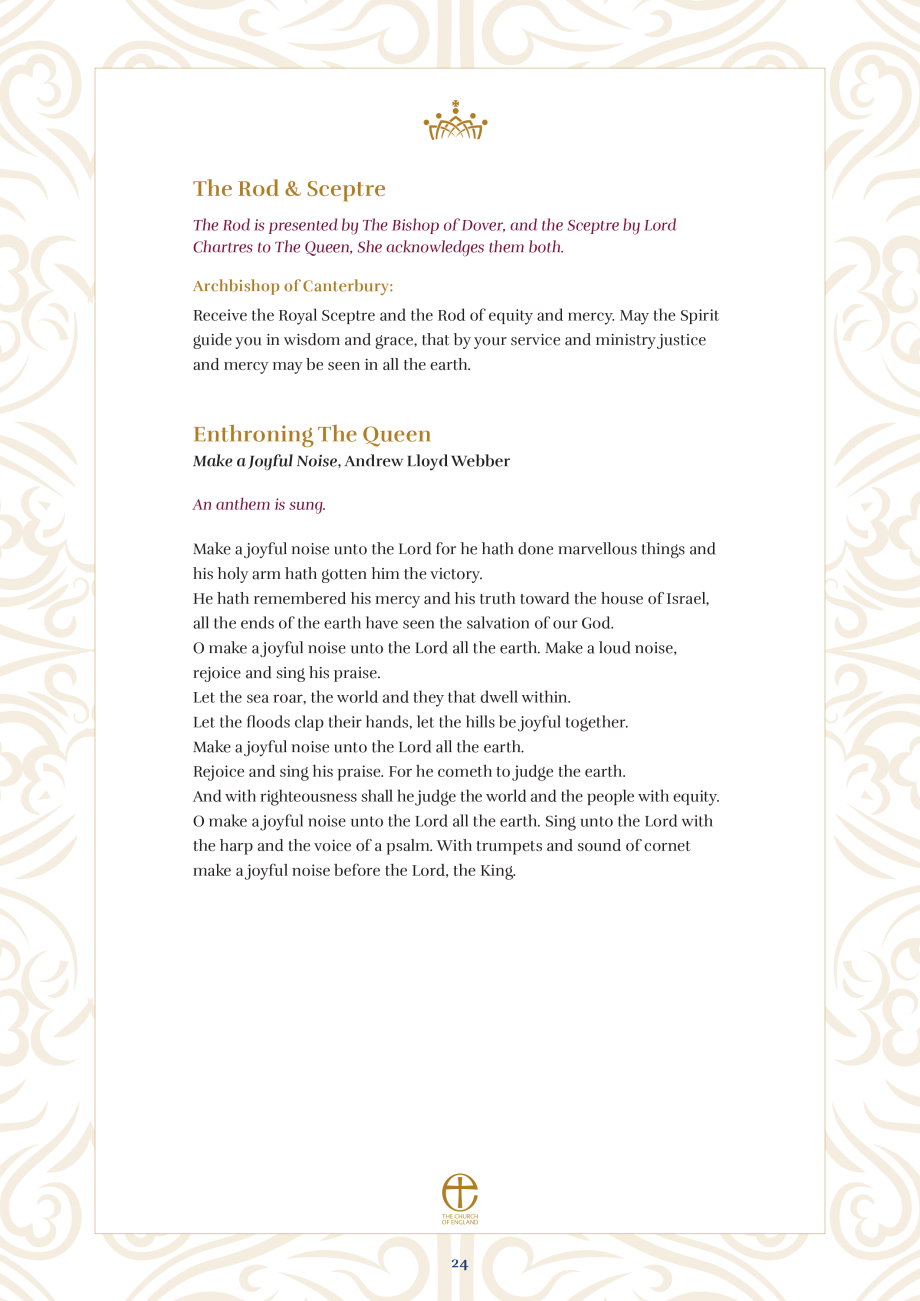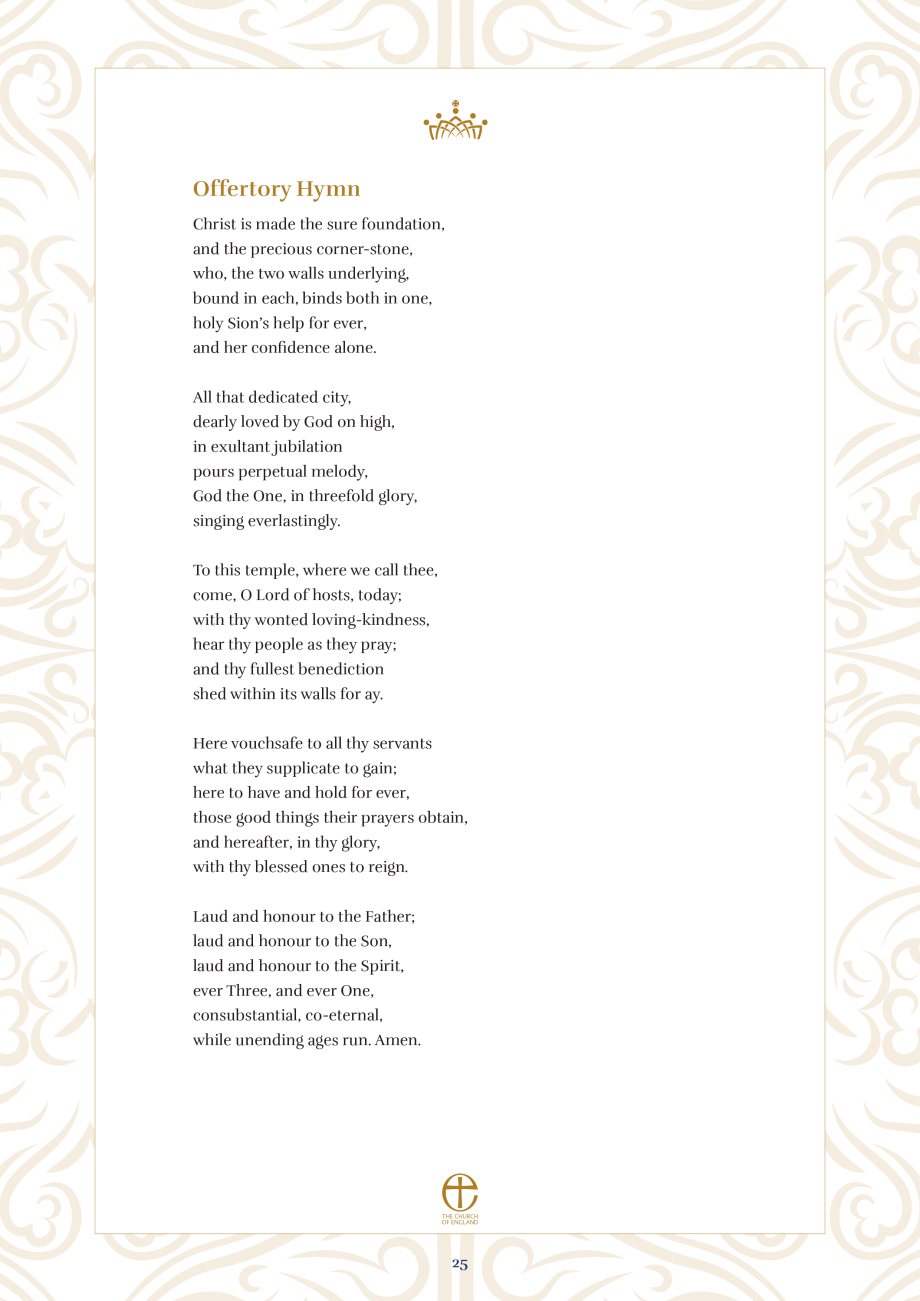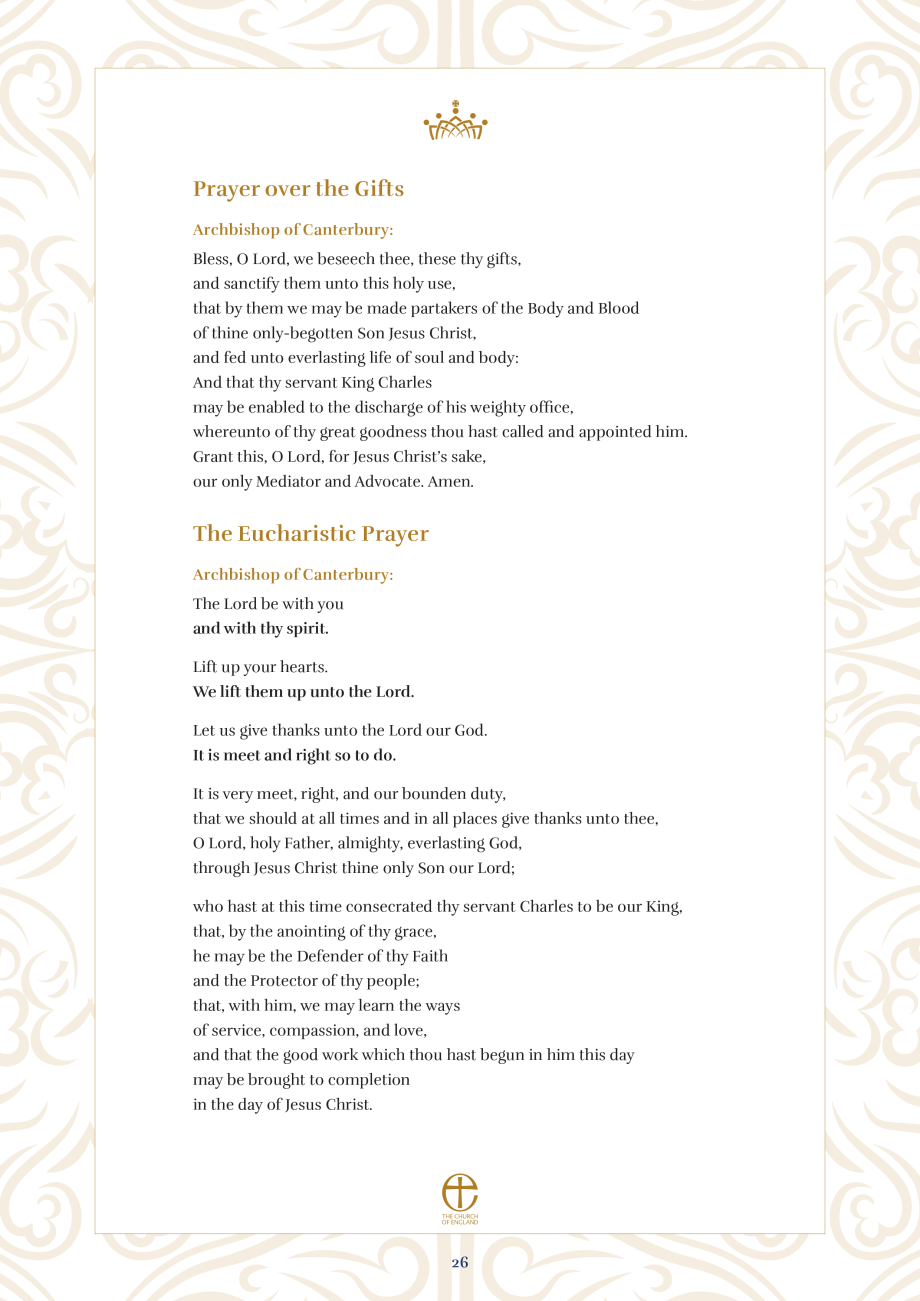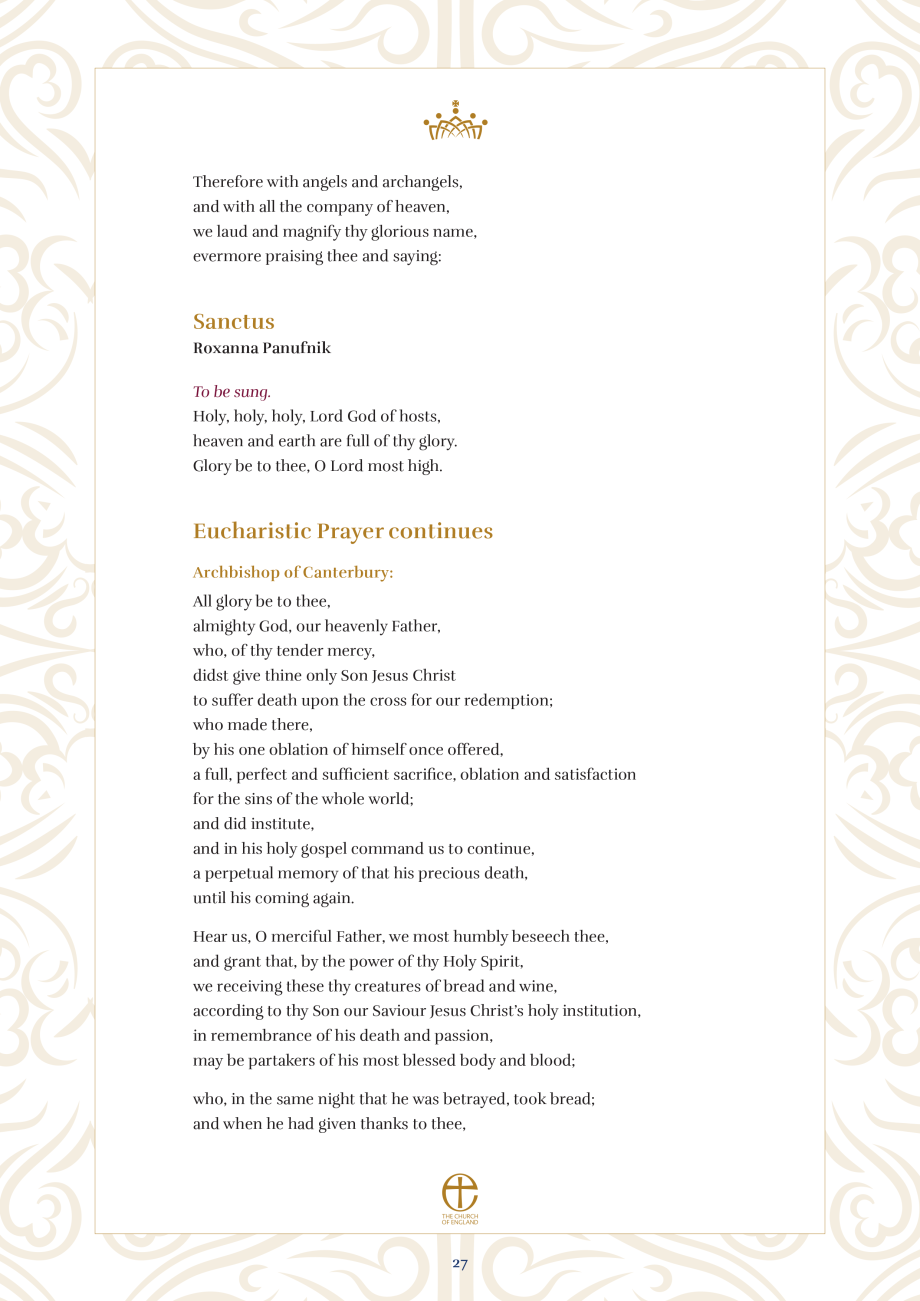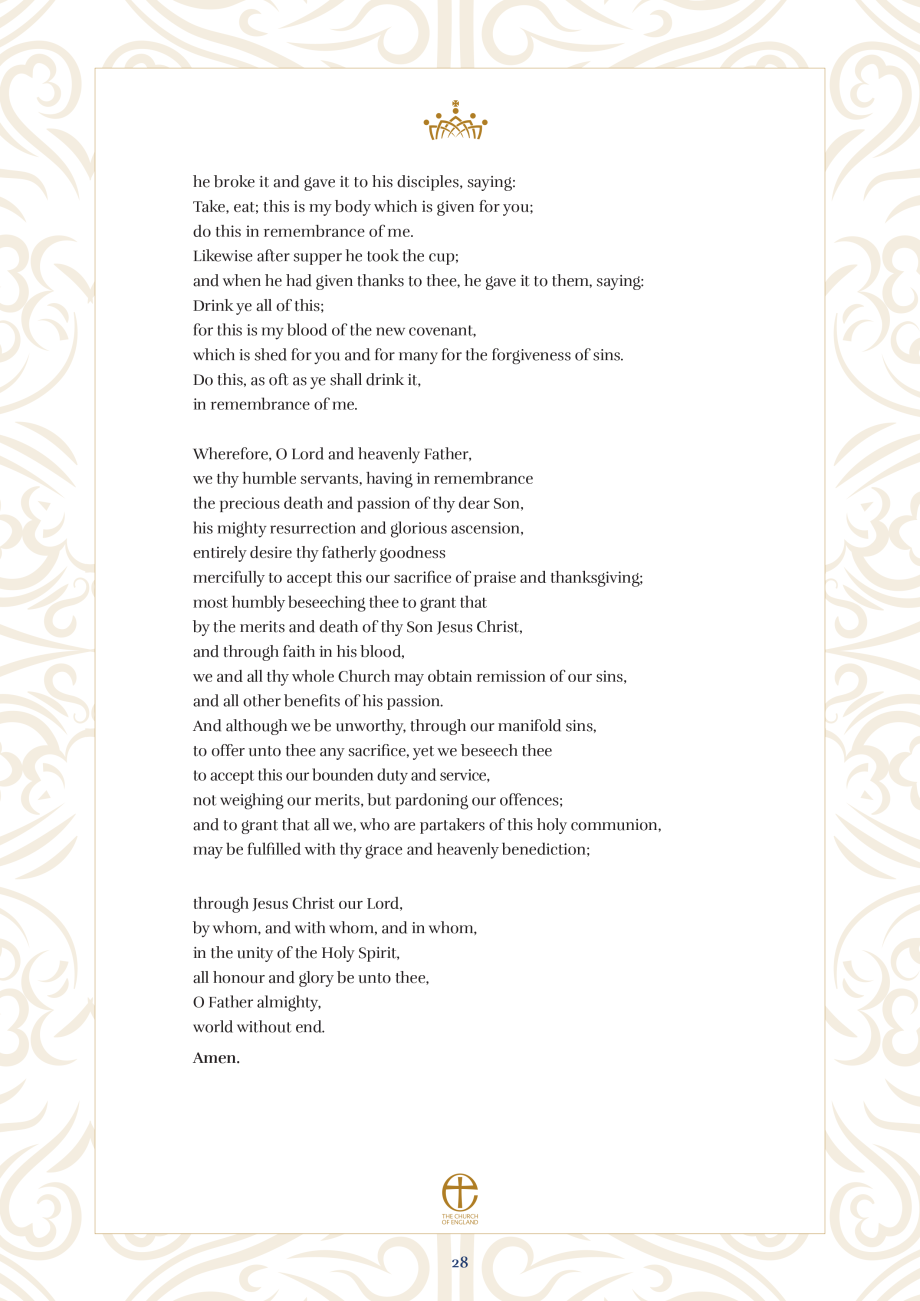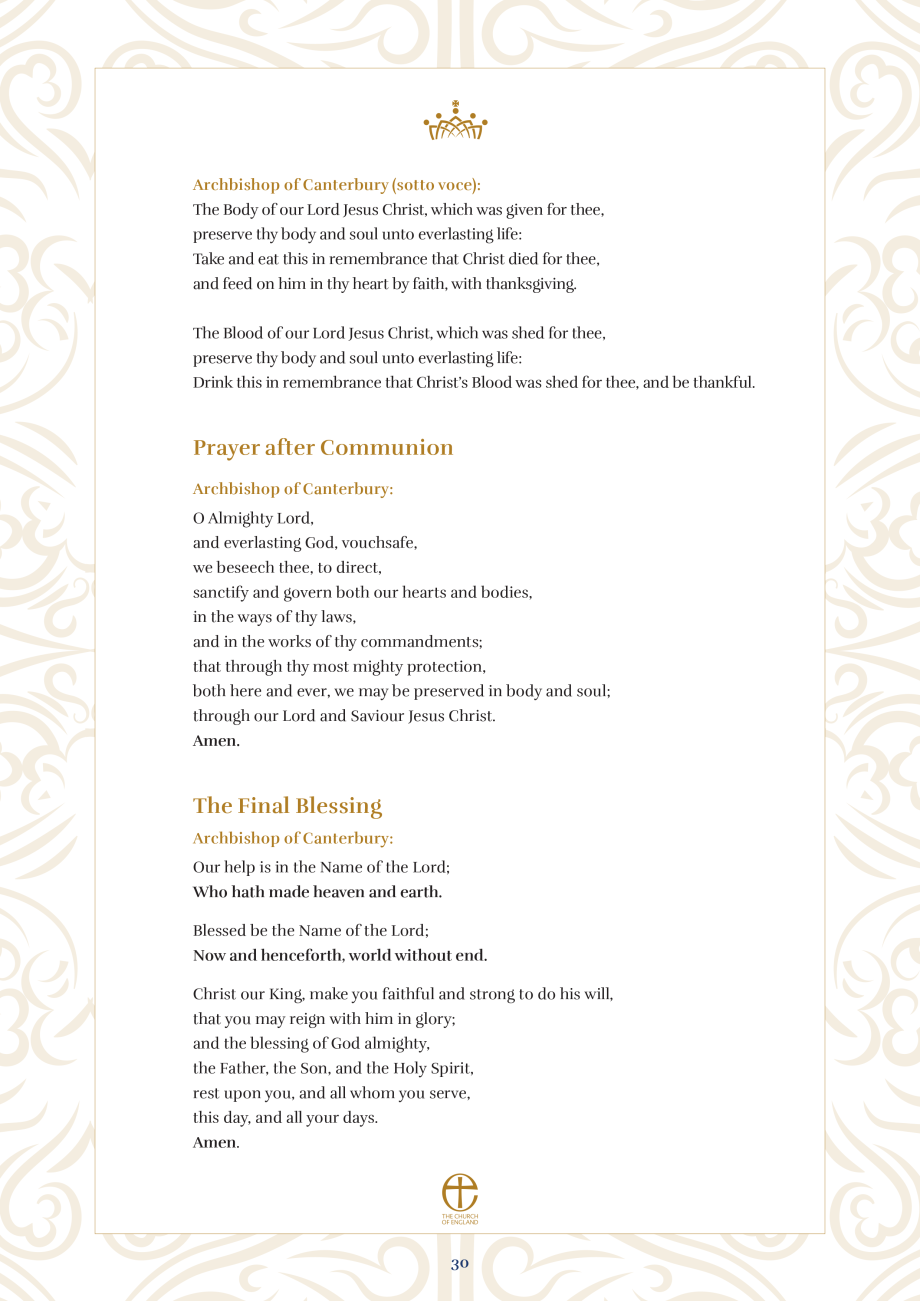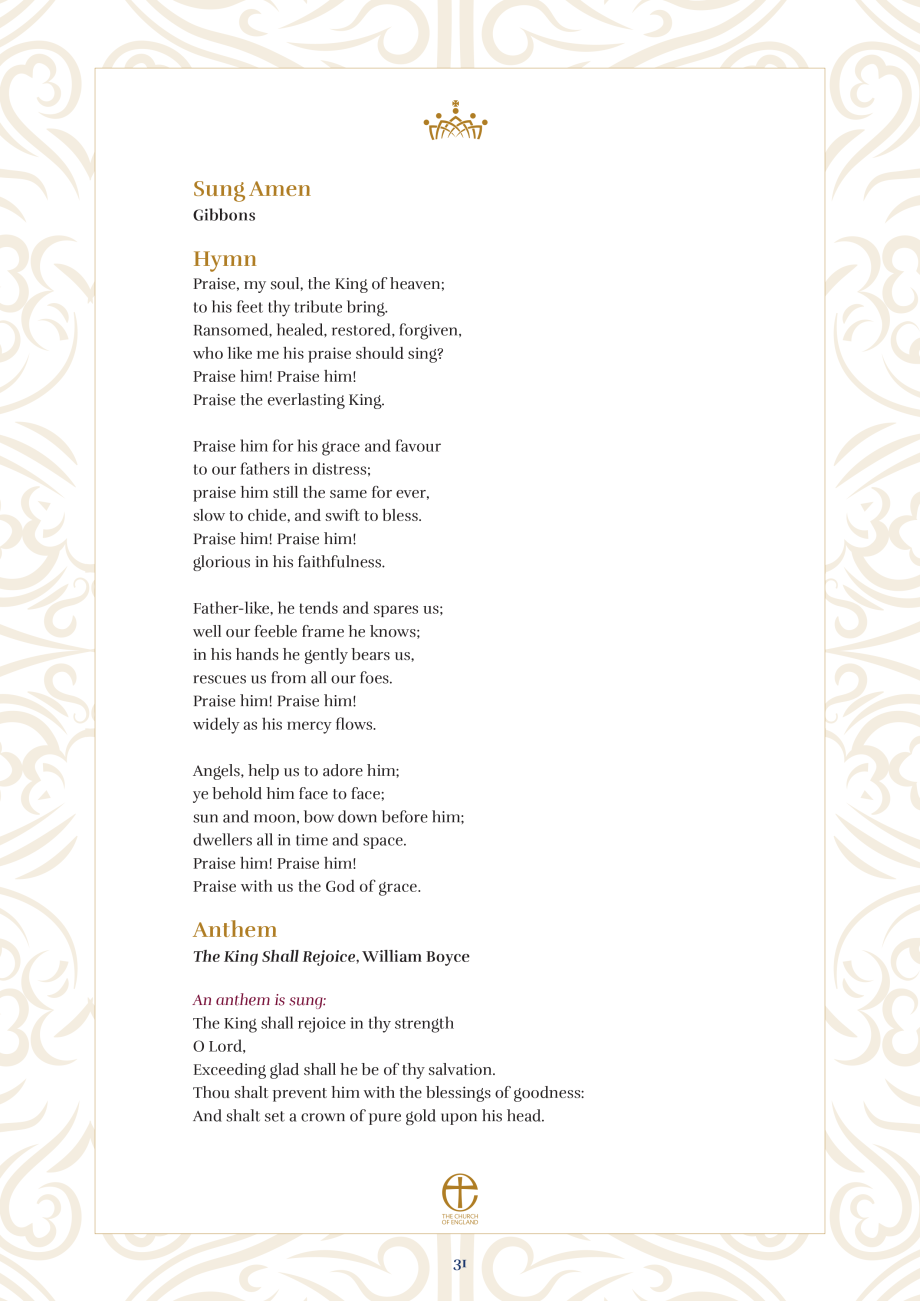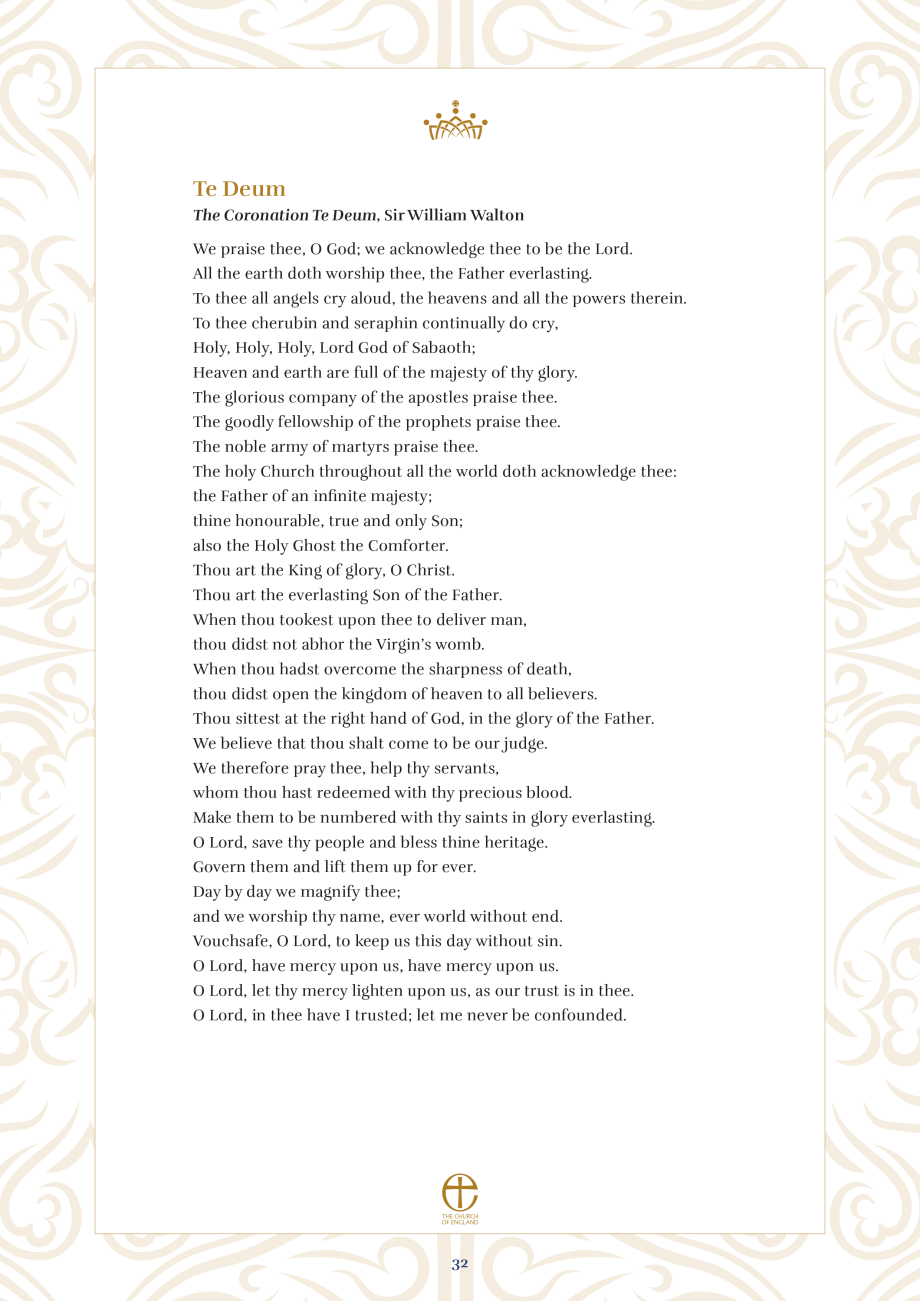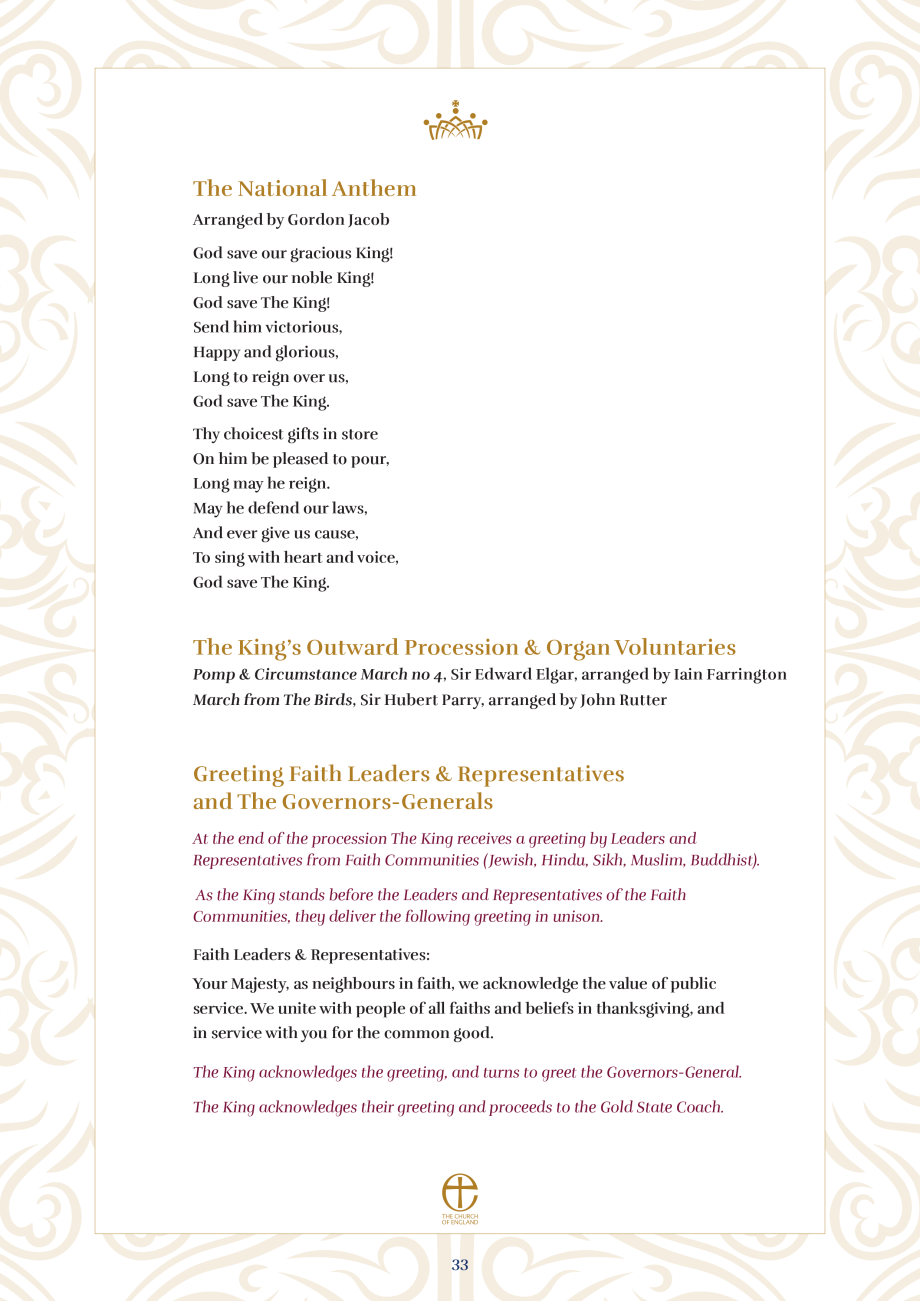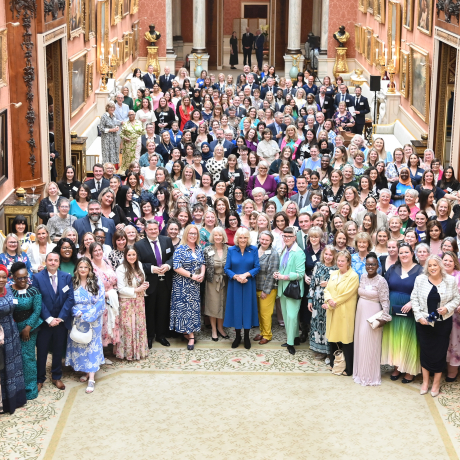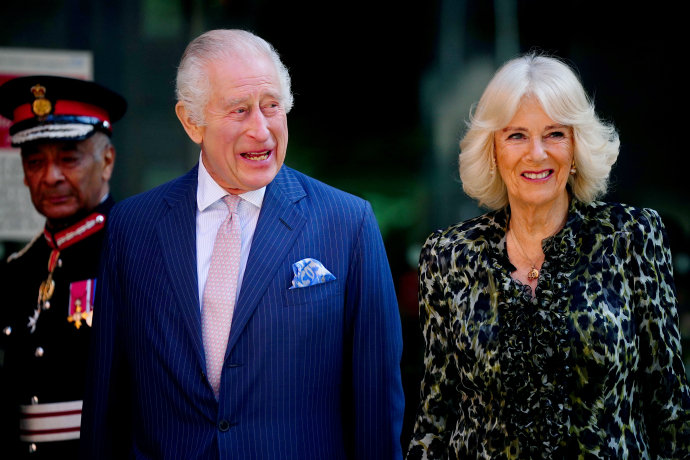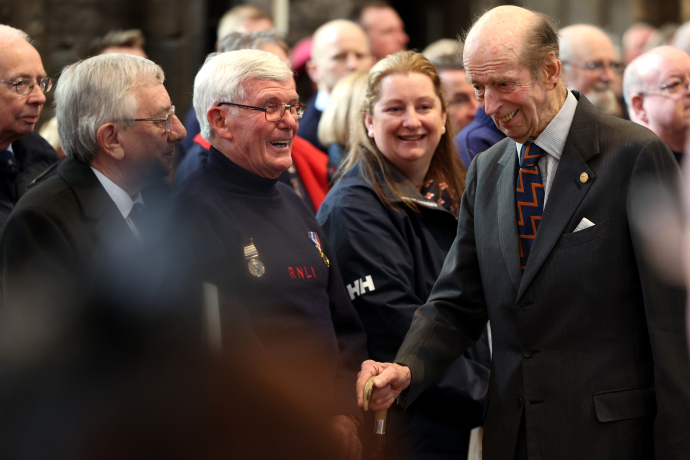Coronation Day
Published
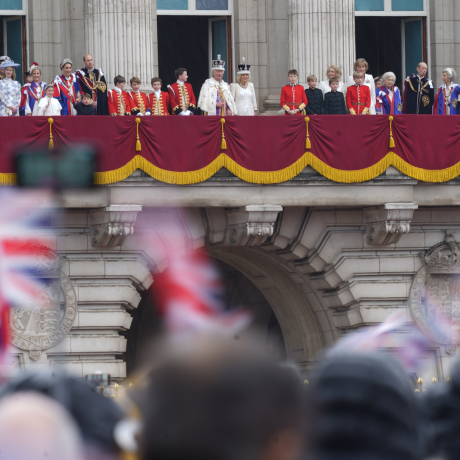
- Overview of the day
- The Procession from Buckingham Palace to Westminster Abbey
- The Coronation Service at Westminster Abbey
- The Order of Service
- Music at the Coronation Service
- Coronation Robes
- Coronation Vestments
- The Coronation Regalia
- Anointing Screen
- Coronation Oil
- Throne Chairs and Chairs of Estate
- Procession from Westminster Abbey and Buckingham Palace
- Gun Salutes
- Royal Salute
- Buckingham Palace Balcony
Overview of the day
The Coronation of Their Majesties The King and The Queen took place at Westminster Abbey on Saturday, 6th May 2023, in the first Coronation Service in almost 70 years. Their Majesties arrived at Westminster Abbey in procession from Buckingham Palace, known as ‘The King’s Procession’.
After the Service, Their Majesties returned to Buckingham Palace in a larger ceremonial procession, known as ‘The Coronation Procession’. Their Majesties were joined in the procession by other Members of the Royal Family.
Upon returning, The King and The Queen received a Royal Salute in the Garden of Buckingham Palace from the Armed Forces taking part in the Processions.
The King and The Queen, accompanied by Members of the Royal Family, then appeared on the Buckingham Palace Balcony for the Flypast and the conclusion of the day’s ceremonial events.
The Procession from Buckingham Palace to Westminster Abbey
Their Majesties The King and The Queen, escorted by The Sovereign’s Escort of the Household Cavalry, departed Buckingham Palace in the Diamond Jubilee State Coach for Westminster Abbey. The King’s Guard turned out in the Forecourt of Buckingham Palace and gave a Royal Salute as The King, The Queen and other Members of the Royal Family departed Buckingham Palace.
The King’s Procession, accompanied by The Sovereign’s Escort of the Household Cavalry, departed Buckingham Palace through the Centre Gate, and proceeded down The Mall, passing through Admiralty Arch and south of King Charles I Island, down Whitehall and along Parliament Street. The King’s Procession travelled around the east and south sides of Parliament Square to Broad Sanctuary on the way to the Sanctuary of Westminster Abbey, where the Coronation Service began.
The Procession covered 1.42 miles. Flanking the Procession were over 1,000 Armed Forces route liners from all three Services and Standard Bearers of the Royal British Legion, Uniformed Civilian Services and Community Organisations. The King’s Life Guard turned out on Whitehall at Horse Guards Front Yard and gave a Royal Salute as The King, The Queen and other Members of the Royal Family passed.
Along the processional route, military veterans, NHS workers and others occupied specially-built viewing stands in Trafalgar Square, the Mall and in front of Buckingham Palace.
Around 3,800 seats were offered in a specially-built grandstand in front of Buckingham Palace which hosted veterans, NHS and social care workers, and representatives of charitable organisations with links to the Royal Family. Additionally, 354 uniformed cadet forces were be offered the opportunity to watch the Procession at Admiralty Arch.
Carriage: Diamond Jubilee State Coach
Their Majesties travelled from Buckingham Palace in The King’s Procession to Westminster Abbey in the Diamond Jubilee State Coach. Created for Queen Elizabeth II to commemorate the 60th anniversary of Her late Majesty’s reign in 2012, the coach has only ever conveyed the Sovereign, occasionally accompanied by the consort or a visiting Head of State.
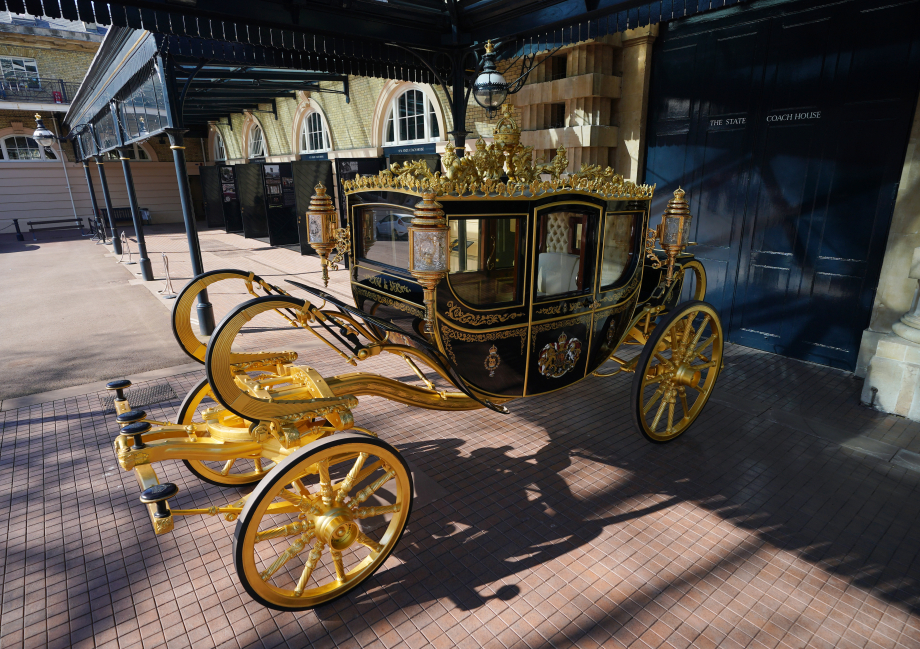
The gilded crown on the top of the Diamond Jubilee State Coach was carved from oak from HMS Victory, and the coach’s interior is inlaid with samples of woods, metals and other materials from buildings and places with specific connections to Britain and its history; Royal Residences including Buckingham Palace, Kensington Palace, Windsor Castle and the Palace of Holyroodhouse; cathedrals including St Paul’s and Westminster Abbey; and historic ships, such as the Mary Rose.
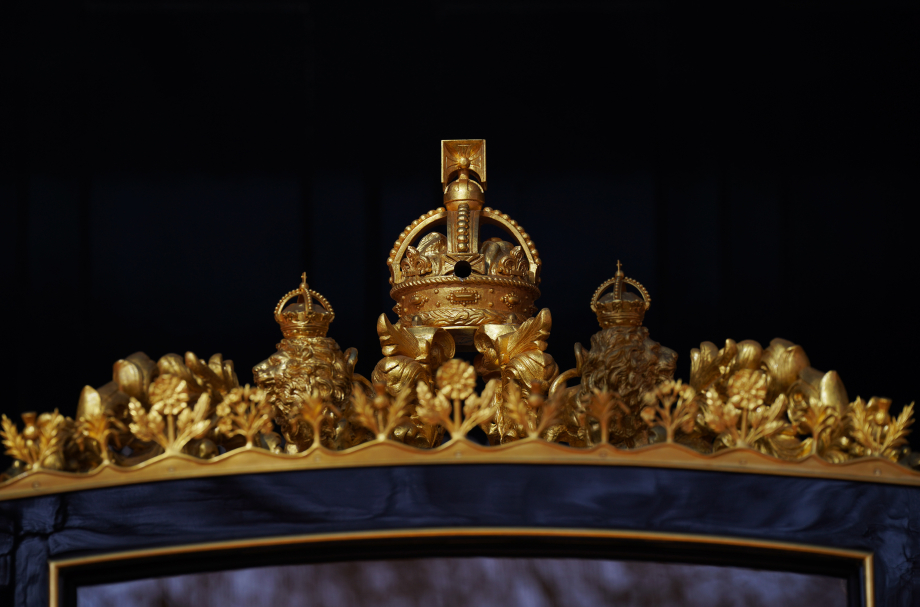
The coach is painted black with heraldic and scrolling details in gold. The paint was built up over several layers; egg-white and water, the designs outlined, then painted in 'size', a mixture of gold paint and pigment, followed by applying gold leaf which is burnished to produce the lustre.
The frieze around the top of the body features the national emblems of the rose of England, thistle of Scotland, flax of Ireland and leek of Wales. These are carved in Australian beech and gilded.
The door panels are painted with the Royal Coat of Arms, and the quarter panels with the Collar of the Order of the Garter, the highest order of chivalry in Britain.
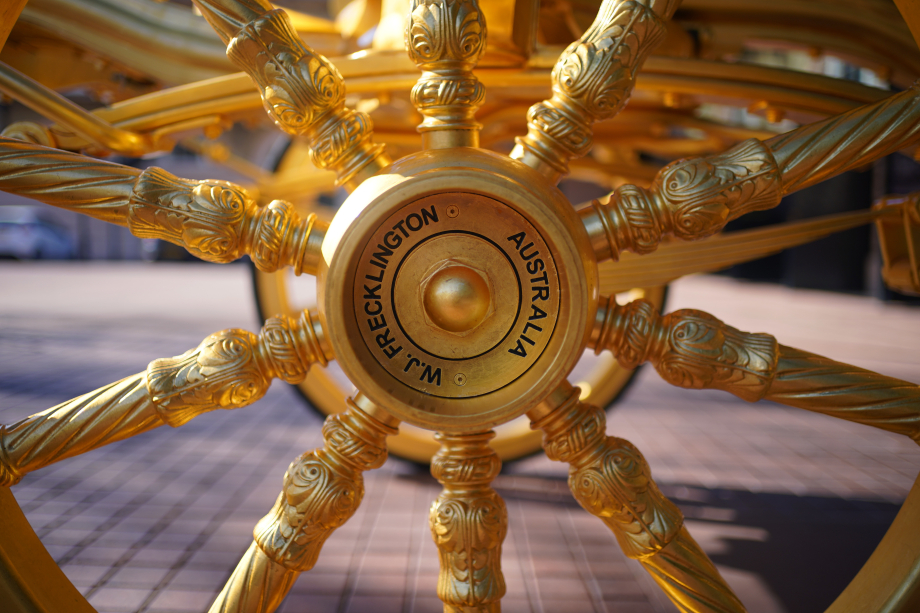
Curving up from the wheels are the traditional springs which form part of the suspension; uniquely among the carriages in the Royal Mews these are combined with six hydraulic stabilisers to prevent the coach body from swaying.
Almost all of the craftsmanship was sourced from within Australia, with the exception of the two door handles, made by a New Zealand jeweller, which are individually decorated with 24 diamonds and 130 sapphires, and the glass in the lamps, made by Edinburgh Crystal.
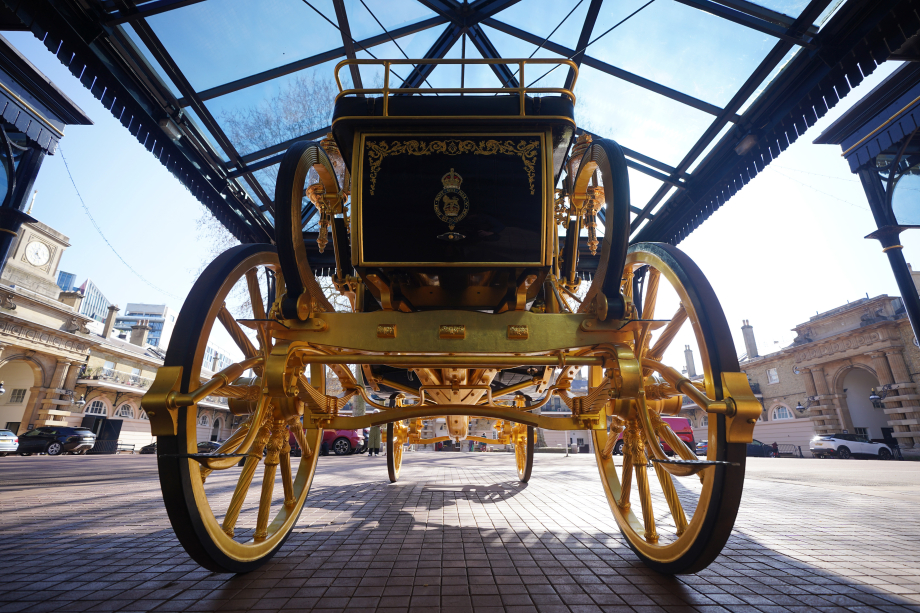
The Coronation Service at Westminster Abbey
The crowning of the Sovereign is an ancient ceremony, rich in religious significance, history and pageantry. The service is deeply sacred and traditional, while reflecting the Monarch’s role today and looking towards the future.
For the last nine centuries, the Coronation ceremony has taken place at Westminster Abbey, as the Royal church for the Palace of Westminster.
The Service was conducted by the Archbishop of Canterbury. By longstanding tradition, the Archbishop of Canterbury authorises a new Liturgy for every Coronation. Commissioned by the Most Reverend and Right Honourable Justin Welby, the new Liturgy for the Coronation of Their Majesties The King and The Queen is based on ancient texts and ceremonial elements that draw on many centuries of tradition. The Liturgy is focussed on the theme of loving service to others, which is central to Christian teaching, and to the character of contemporary Monarchy and reflects the commitment that His Majesty makes to serve God and the people, and the decades of public service of The King and The Queen.
The Coronation Liturgy was produced in close consultation with His Majesty The King, and with His Majesty’s Government in particular on the constitutional elements of the service.
The Liturgy
The Order of Service
Download the Order of Service
For almost a thousand years, Coronations have been held at Westminster Abbey, and the Order of Service draws on this long tradition, centred around the liturgical theme of “Called to Serve” and The King’s solemn vow and commitment to serve God, and the people of the nations and the realms.
The Service was conducted by the Archbishop of Canterbury, the Most Reverend and Right Honourable Justin Welby. The Choirs of Westminster Abbey and His Majesty’s Chapel Royal, St James’s Palace, with choristers from Methodist College, Belfast, and Truro Cathedral Choir, and an octet from the Monteverdi Choir, sang. The music during the Service was directed by Andrew Nethsingha, Organist and Master of the Choristers, Westminster Abbey.
Faith leaders and representatives of faith communities processed through Westminster Abbey ahead of the Service, followed by representatives of the Commonwealth Realms.
Their Majesties entered Westminster Abbey through the Great West Door, upon which the choir sang Hubert Parry’s ‘I was glad’, which was composed for the Coronation of King Edward VII. Their Majesties arrived at the Chairs of Estate in the Coronation Theatre, where The King was greeted by the longest serving chorister of His Majesty’s Chapel Royal. The history of this greeting is rooted in the ordination and consecration of members of the clergy, where the inclusion of a young person symbolises looking towards the future. The King then had a personal moment of silent prayer, as Queen Elizabeth II did in 1953.
Following this, the Archbishop of Canterbury gave a greeting from the High Altar, welcoming the congregation to the Service. The choir, joined by Sir Bryn Terfel, sang the ‘Kyrie’, which was sung in Welsh for the first time.
The Recognition followed; an ancient element of the Coronation Service, in which The King was recognised as the true Monarch. His Majesty turned to each of the four points of the compass to be recognised; to the East, by the Archbishop of Canterbury; to the South, by Lady Eilish Angiolini, a Lady of the Order of the Thistle; to the West, by Christopher Finney, a holder of the George Cross, and to the North, by Baroness Amos, a Lady of the Order of the Garter. Each recognition was marked with a fanfare.
The King was presented with the Holy Bible by the Moderator of the General Assembly of the Church of Scotland. The new Bible was commissioned for the Service by Lambeth Palace. His Majesty then took The Oath, and signed copies presented by the Lord Chamberlain, as the choir sang an Anthem by William Byrd. Having taken The Oath, The King kneeled before the High Altar and prayed aloud. The words of His Majesty’s prayer were inspired by the hymn, ‘I vow to thee, my country’, in a continuation of the theme of service. The choir then sang a ‘Gloria’, also by William Bryd, framing His Majesty’s prayer.
The Archbishop of Canterbury said the Collect, which was specially written for the Coronation Service, before the Prime Minister, the Right Honourable Rishi Sunak MP, gave the first reading from the Epistle to the Colossians. The choir sang the ‘Alleluia’, newly commissioned by Debbie Wiseman, while the St Augustine’s Gospel Book, dating back to the sixth century, was carried into the Nave. The Gospel was then be read by the Bishop of London and Dean of His Majesty’s Chapels Royal, the Rt Revd and Rt Hon Dame Sarah Mullally, marking the first active participation of female Church of England Bishops in a Coronation Service. The Ascension gospel choir sang a second Alleluia, by Debbie Wiseman, and the Archbishop of Canterbury preached the Sermon. Their Majesties then knelt at the Chairs of Estate as the choir sang the Veni, Creator Spiritus, sung in English, Welsh, Scots Gaelic and Irish.
The Anglican Archbishop in Jerusalem, who was present during the consecration of the Chrism oil earlier this year, received the Ampulla containing the oil at the High Altar, which was blessed by the Archbishop of Canterbury. Their Majesties removed their Robes of State, and The King sat in the Coronation Chair, on the Cosmati pavement. The Anointing Screen, newly made for the Service and inspired by the window of His Majesty’s Chapel Royal, was brought into position around the Chair by Guardsmen of the Household Division. The Anointing, the most solemn and sacred part of the Service, took place as the choir sang Handel’s ‘Zadok the priest’, which was composed for the Coronation of King George II in 1727 and has become synonymous with such occasions. The Archbishop of Canterbury, assisted by the Dean of Westminster and the Archbishop of York, anointed The King’s hands, chest and head. Afterwards, The King approached the High Altar and knelt, and the Archbishop of Canterbury prayed.
For The Investiture, The King was vested with the Colobium Sidonis, a white linen shift-like tunic; the Supertunica, a full-length, sleeved gold coat; and the Coronation Sword Belt. His Majesty sat in the Coronation Chair as items of Regalia were presented; first, the Spurs, carried by the Lord Great Chamberlain.
The Byzantine Chant Ensemble sang in Greek, in recognition of His Majesty’s father Prince Philip, The late Duke of Edinburgh, while the Sword of State is exchanged for the Sword of Offering by the Lord President of the Council, The Rt Hon Penny Mordaunt MP. The Sword of Offering, which symbolises the protection of good and the punishment of evil, was delivered to the Archbishop of Canterbury and was placed in The King’s right hand. The King rose, and the Sword was fastened at His Majesty’s waist using the Sword Belt. The King offered the Sword at the Altar, where it was received the Dean. The Sword was then redeemed with the offering of 100 newly minted 50ps, by the Lord President of the Council, who carried it before The King for the remainder of the Service. Traditionally, the Sword is offered to Westminster Abbey in payment for hosting a Coronation Service, and redeemed by offering a symbolic payment.
The King was presented with the Armills, traditionally referred to as ‘the bracelets of sincerity and wisdom’, by Lord Kamall, the Robe Royal, brought by Baroness Merron, and the Stole Royal, presented by His Royal Highness The Prince of Wales. His Majesty was then invested and sat in the Coronation Chair again. The Orb, symbolising the Christian world, was placed in The King’s right hand by the Archbishop of Canterbury, before being returned to the Altar and the Sovereign’s Ring was presented by Lord Patel. The Coronation Glove was presented by Lord Singh, and The King placed it on His Majesty’s right hand. The Sceptre with Cross, a symbol of power and justice, and the Sceptre with Dove, a symbol of equity and mercy, were brought from the Altar by the Primus of the Scottish Episcopal Church and the Archbishop of Wales, and placed in The King’s right and left hands, by the Archbishop of Canterbury.
For The Crowning, The Dean of Westminster delivered St Edward’s Crown to the Archbishop of Canterbury, who offered a blessing before His Majesty The King is crowned. The Archbishop led the congregation of Westminster Abbey in saying, ‘God save The King’. The bells of the Abbey rang as gun salutes were fired in celebration on Horse Guards Parade, at His Majesty’s Fortress the Tower of London, and at Saluting Stations throughout the United Kingdom, Gibraltar, Bermuda, and His Majesty’s ships at sea. In Westminster Abbey, the Wiener Philharmoniker Fanfare was played by the Coronation Brass Ensemble, as requested by The King. His Majesty was then blessed by ecumenical leaders.
The choir sang an Anthem by Thomas Weekles, followed by The Enthroning. The King, escorted by the Archbishops of Canterbury and York, and assisted by the Bishops of Bath and Wells, and Durham, was enthroned. The Great Officers of State assembled behind His Majesty’s Throne Chair.
The Homage was given by the Archbishop of Canterbury, and The Prince of Wales. The People’s Homage followed, an opportunity for those who wished to be given voice within the Service, and for those at home to have a chance to be an extension of the Westminster Abbey congregation, if they wished. A fanfare sounded, and the choir sang an Anthem arranged by John Rutter for the Coronation of King George VI.
The Homage was followed by the Coronation of The Queen. Her Majesty knelt at her Chair of Estate to be anointed on the head by The Archbishop of Canterbury. The Queen’s Ring was presented to Her Majesty by the Keeper of the Jewel House, and Her Majesty was crowned by the Archbishop with Queen Mary’s Crown. The former Bishop of London, Lord Chartres, and the Bishop of Dover, The Rt Revd Rose Hudson-Wilkin, presented Her Majesty with The Queen’s Sceptre with Cross and The Queen’s Rod with Dove. Escorted by the Archbishops of Canterbury and York, the Bishops of Hereford and Norwich, and The Queen’s Companions, Her Majesty was enthroned. A new Anthem, ‘Make a joyful noise’, composed by Andrew Lloyd Webber, was sung by the choir.
Their Majesties proceeded into the Shrine and removed St Edward’s Crown and Queen Mary’s Crown, before returning to the Chairs of Estate for Communion. The King was presented with bread and wine, which was used for the Holy Sacrament. The hymn ‘Christ is made the sure foundation’ was sung by the congregation, to the Westminster Abbey tune. Reflecting The King’s devotion to the traditional liturgy of the Church of England, the communion bread and wine was consecrated according to the Book of Common Prayer, the wording of which was also used at the Coronation of Queen Elizabeth II. The ‘Sanctus’ was sung, composed for the Service by Roxanna Panufnik.
The Archbishop of Canterbury led The Lord’s Prayer, which the congregation were welcome to say in the language of their choice, for their own act of worship. The choir then sang a newly commissioned ‘Agnus Dei’; a reflective moment in the Service, during which Their Majesties received Holy Communion. The Amen was sung by the choir, to the Orlando Gibbons tune which was also sung at the Coronation in 1953.
While the hymn, ‘Praise, my soul, the King of heaven’ is sung by the congregation, Their Majesties will enter the Shrine of St Edward the Confessor before the conclusion of the Service. The choir will sing an Anthem by William Boyce, composed for the Coronation of King George III in 1761, and the Te Deum, written for the Coronation of Queen Elizabeth II.
A fanfare will sound as The King, wearing the Imperial State Crown, followed by The Queen, wearing Queen Mary’s Crown, emerge from the Shrine and join the Coronation Procession out of Westminster Abbey as the National Anthem is sung.
After the Coronation Service, at the Great West Door, The King was greeted by five faith leaders, and Governors-General from the Realms. Their Majesties will then depart Westminster Abbey in the Gold State Coach for Buckingham Palace
Music at the Coronation Service
The music, performers and composers were drawn from across the United Kingdom and the Commonwealth. Five of the composers were women, seven were men. It was the first time music composed by women was included in the Coronation Ceremony.
Performers included Welsh bass-baritone Sir Bryn Terfel, South African Soprano, Pretty Yende and British-Jamaican Baritone Roderick Williams. A modern organ arrangement by Iain Farrington referenced familiar themes and well-known tunes commonly associated with countries from across the Commonwealth.
Twelve newly commissioned pieces of music were performed at the Coronation, showcasing musical talent from across the United Kingdom and the Commonwealth. A range of musical styles and performers blended tradition, heritage and ceremony with new musical voices, reflecting The King’s life-long love and support of music and the arts.
His Majesty personally commissioned the new music and shaped and selected the musical programme for the Service.
Andrew Nethsingha, Organist and Master of the Choristers, Westminster Abbey, oversaw all musical arrangements and directed the music during the Service.
Sir Antonio Pappano, Music Director for the Royal Opera House, conducted the Coronation Orchestra which comprised a bespoke collection of musicians drawn from orchestras of The former Prince of Wales’ Patronages including the Royal Philharmonic Orchestra.
Six orchestral commissions, five choral commissions and one organ commission were specially composed for the occasion by world-renowned British composers whose work includes classical, sacred, film, television and musical theatre. Commissioned works included a new Coronation Anthem by Andrew Lloyd Webber, a Coronation March by Patrick Doyle, a new commission for solo organ embracing musical themes from countries across the Commonwealth by Iain Farrington plus new works by Sarah Class, Nigel Hess, Paul Mealor, Tarik O'Regan, Roxanna Panufnik, Shirley J. Thompson, Judith Weir, Roderick Williams, and Debbie Wiseman.
Soloists included bass-baritone, Sir Bryn Terfel; soprano, Pretty Yende and baritone, Roderick Williams. The organ was played by Sub-Organist, Westminster Abbey, Peter Holder, and Assistant Organist, Westminster Abbey, Matthew Jorysz.
The official Royal Harpist Alis Huws performed as part of the Coronation Orchestra in recognition of The King’s long-standing and deeply held relationship and affiliation with Wales. One of the liturgical sections of the ceremony was performed in Welsh.
At the request of His Majesty, in tribute to his late father His Royal Highness The Prince Philip, Duke of Edinburgh, Greek Orthodox music also featured in the Service performed by the Byzantine Chant Ensemble.
The Service was sung by The Choir of Westminster Abbey and The Choir of His Majesty’s Chapel Royal, St James’s Palace, together with girl choristers from the Chapel Choir of Methodist College, Belfast and from Truro Cathedral Choir. The Ascension Choir, a handpicked gospel choir, also performed as part of the Service and The King’s Scholars of Westminster School proclaimed the traditional ‘Vivat’ acclamations.
Fanfares were played by The State Trumpeters of the Household Cavalry and The Fanfare Trumpeters of the Royal Air Force.
Sir John Eliot Gardiner conducted The Monteverdi Choir and English Baroque soloists in a pre-Service programme of choral music. A small group of singers from The Monteverdi Choir also joined the main choral forces for the Service.
Music by William Byrd (1543–1623), George Frideric Handel (1685–1759), Sir Edward Elgar (1857–1934), Sir Henry Walford Davies (1869–1941), Sir William Walton (1902–1983), Sir Hubert Parry (1848–1918) and Ralph Vaughan Williams (1872–1958) has historically featured in the Service over the past four centuries and was included in the programme along with the music of one of Britain’s most loved and celebrated living composers, Sir Karl Jenkins.
Coronation Robes
In accordance with tradition, Their Majesties wore two different sets of robes during the Coronation Service – the Robes of State and the Robes of Estate. Robes of State are worn on arrival at Westminster Abbey, and Robes of Estate are worn on departure, following the Coronation Service, and are traditionally more personalised in design.
His Majesty’s Robe of State (worn on arrival)
The King’s Robe of State is made of crimson velvet and was worn by King George VI at the Coronation in 1937. In preparation for the Coronation Service, the velvet was conserved by the Royal School of Needlework, with the lining and gold lace conserved by Ede and Ravenscroft.
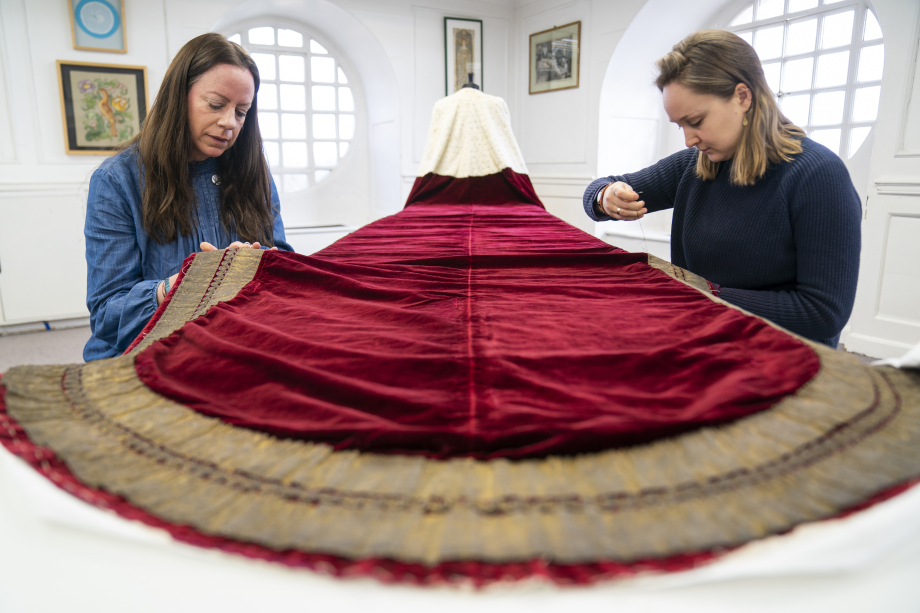
Her Majesty’s Robe of State (worn on arrival)
The Robe of State worn by The Queen was originally made for Queen Elizabeth II in 1953. The Robe is made of crimson velvet and was conserved with adjustments made by robemakers at Ede and Ravenscroft ahead of the Coronation.
His Majesty’s Robe of Estate (worn on departure)
The King’s Robe of Estate is made of purple silk velvet embroidered in gold and was worn by King George VI in 1937. Robemakers at Ede and Ravenscroft conserved and prepared the robe ahead of the Coronation.
Her Majesty’s Robe of Estate (to be worn on departure)
The Queen’s new Robe of Estate was designed and hand embroidered by the Royal School of Needlework. The Robe itself was made by Ede and Ravenscroft.
The Royal School of Needlework’s design of the train drew upon themes of nature and the environment, featuring the national emblems of the United Kingdom, as well as paying tribute to His Majesty The King.
The Robe uses a rich purple velvet, which was chosen to match His Majesty’s Robe of Estate, and was embroidered by the Royal School of Needlework using the Goldwork technique, with the design also incorporating Her Majesty’s cypher.
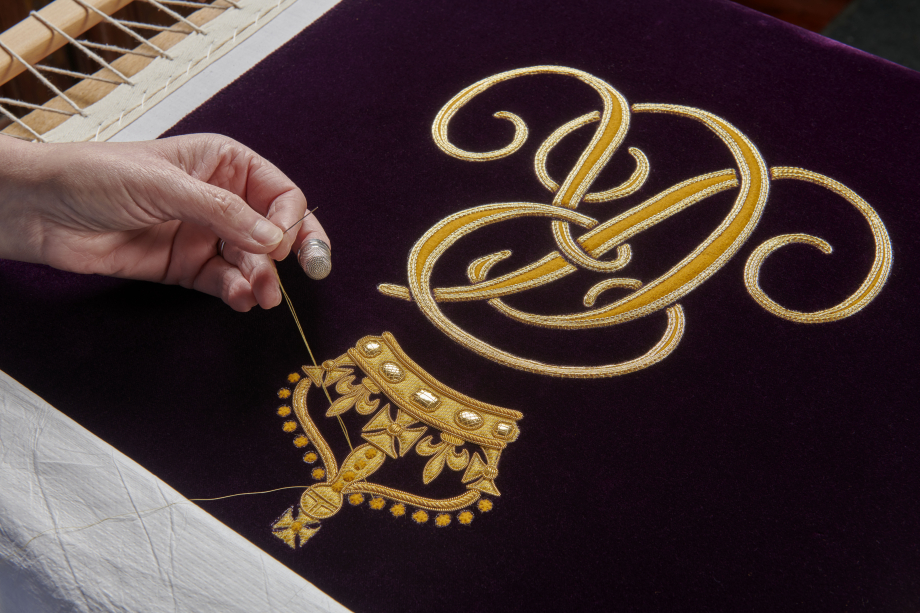
For the first time, insects including bees and a beetle feature on the robe, drawing on the themes of nature and the environment and reflecting Their Majesties’ affection for the natural world.
In addition, there are a number of plants featured in the robe, all chosen for their personal associations. These include Lily of the Valley, which featured in Her Majesty’s wedding bouquet and was a favourite flower of Queen Elizabeth II; Myrtle, which represents hope; and Delphinium, one of The King’s favourite flowers and the birth flower of July, the birth month of The Queen.
Also featured is the ‘Alchemilla Mollis’, known as Lady’s Mantle, which symbolises love and comfort, Maidenhair Fern, which symbolises purity, and cornflowers, which represent love and tenderness. The Cornflower also helps to attract and encourage wildlife such as bees and butterflies.
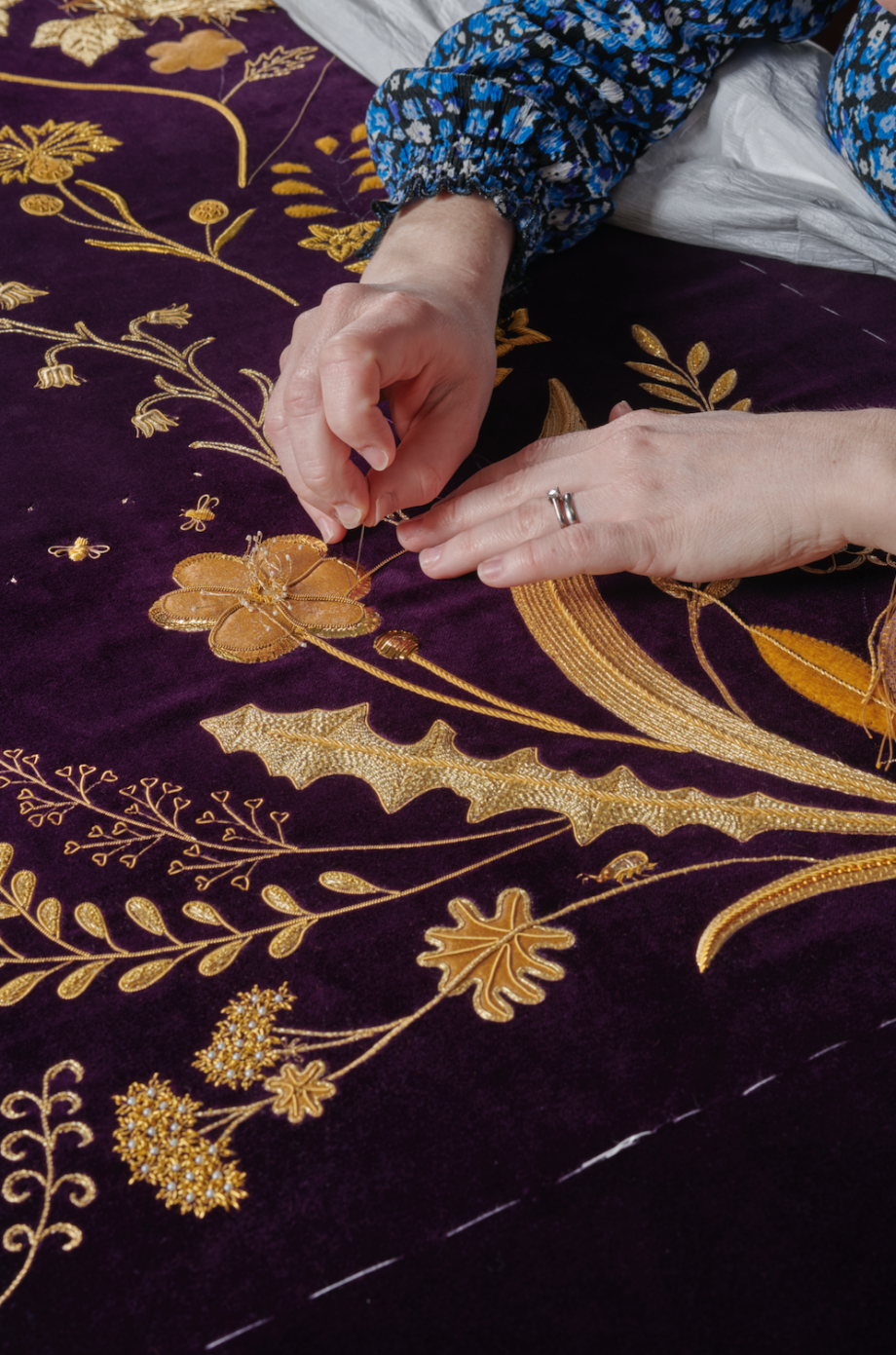
Ede and Ravenscroft
Ede and Ravenscroft, renowned for being London’s oldest tailor, has a robemaking and tailoring heritage that stretches back over 330 years, having made garments for every British coronation since that of King William and Queen Mary in 1689.
Its London craftspeople have worked on the Robes of State and the Robes of Estate for Their Majesties The King and The Queen. Where required, the historic robes and garments were expertly restored and adjusted by hand.
Ede and Ravenscroft create hand-crafted bespoke robes and garments, using traditional skills, expertise and the finest textiles. The company has made robes and tailored garments for Royal, civic, legal and academic ceremonies in over forty countries around the world to date.
The Royal School of Needlework
The Royal School of Needlework (RSN) is the international centre of excellence for the art of hand embroidery. It offers a range of courses around the world for beginners through to advanced.
The Royal School of Needlework’s Embroidery Studio is the heart of the organisation and based at Hampton Court Palace. All work is done by hand in the UK, using traditional skills. The RSN is renowned for its work for Coronations throughout history, including producing the Robes of Estate for the Consort of King George VI, Queen Elizabeth (later known as the Queen Elizabeth The Queen Mother) in 1937 and Queen Elizabeth II in 1953.
Coronation Vestments
The King reused historic items of clothing from the Royal Collection, worn by previous Monarchs at past Coronations. The ‘vestments’ were worn as His Majesty was crowned by the Archbishop of Canterbury in the Coronation Chair.
His Majesty reused vestments which featured in the Coronation Services of King George IV in 1821, King George V in 1911, King George VI in 1937 and Queen Elizabeth II in 1953, including the Colobium Sindonis, the Supertunica, the Imperial Mantle, the Coronation Sword Belt and the Coronation Glove.
Although it is customary for the Supertunica and the Imperial Mantle to be reused, His Majesty also reused the Colobium Sindonis, Coronation Sword Belt and Coronation Glove worn by his grandfather King George VI, in the interests of sustainability and efficiency.
Colobium Sindonis
The Monarch is invested with the Colobium Sindonis after the anointing. It takes the form of a white linen shift-like tunic, and a plain collar fastened with a single button, intended to represent a priests' alb. His Majesty The King will use the Colobium Sindonis worn at the Coronation of his grandfather King George VI in 1937, which was made by the robemakers Ede and Ravenscroft.
Super tunica
The Supertunica takes the form of a full-length, sleeved gold coat and is worn under the Imperial Mantle. The Sovereign is invested with the Supertunica following the anointing and it is fastened with the Coronation Sword Belt.
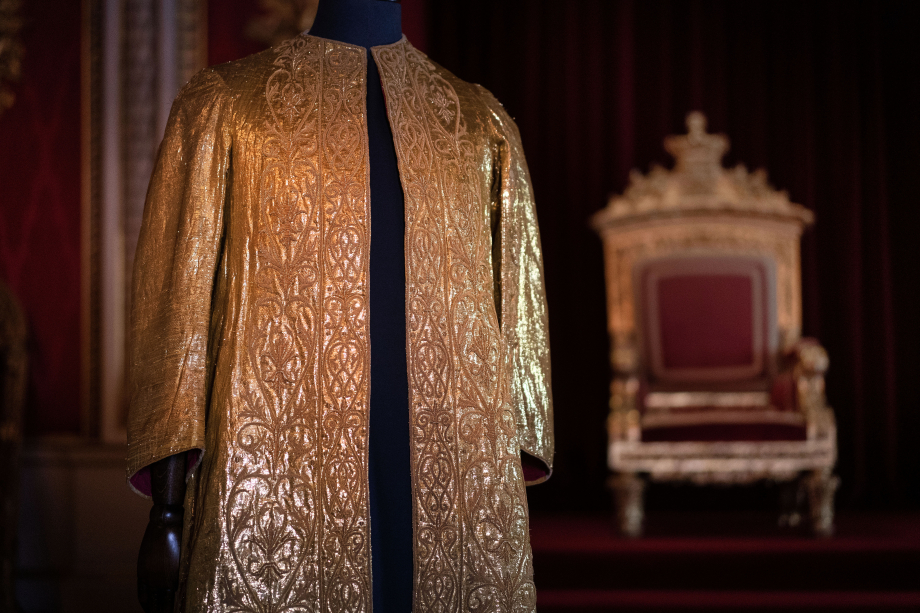
This Supertunica was made in 1911 for the Coronation of King George V by Wilkinson and Son, Robe-makers and Tailors. The Supertunica has subsequently also been worn by King George VI at his Coronation in 1937 and by Queen Elizabeth II in 1953.
Although this Supertunica dates from the twentieth century, the form of the Supertunica has changed little since medieval coronations. The design of the Supertunica is based on priestly and religious vestments.
Each side of the front of the Supertunica features an embroidered band with spiral threads, which take the shape of leafy stems using the goldwork technique. The embroidery was carried out in 1911 by the Ladies Work Society and, as part of the centuries-old tradition for the Supertunica, is based on ecclesiastical vestments from medieval times.
Stole Royal
The Stole Royal for The King was newly created and embroidered by the Royal School of Needlework, from a design created, under the direction of Garter King of Arms, by Timothy Noad, Herald Painter at the College of Arms. Inspired by the Stole worn by Queen Elizabeth II, the new design features a series of roundels set in a gold chain framework and applied to Cloth of Gold. Each roundel features an embroidered image using the Silk Shading technique, also known as ‘painting with a needle’.
Designs in the roundels include the four emblems of the United Kingdom – Rose, Thistle, Leek, and Shamrock; a Dove of peace (representing the Holy Spirit); a Tudor Crown; the Crossed Keys of St Peter (representing the keys to heaven); the four Apostles and a pattern inspired by the Cosmati pavement in Westminster Abbey, upon which the anointing takes place. At the nape of the neck, is an icon representing St Lawrence, the patron saint of the poor and patron saint of the Girdlers’ Livery Company.
The embroidered illustrations were worked in different colours, using fine twisted silk threads, and each roundel has been edged with Gold Grecian and Pearl Purl. The Stole has a crimson lining and a gold twisted fringe.
The Girdle (Sword Belt)
The Girdle, also known as the Coronation Sword Belt, is made of cloth of gold, and embroidered in gold thread with arabesques and scrolls. It is lined with dark red silk, with a gold buckle stamped with national emblems (roses, thistles and shamrocks) and a gold clip for attaching the Jewelled Sword of Offering in place.
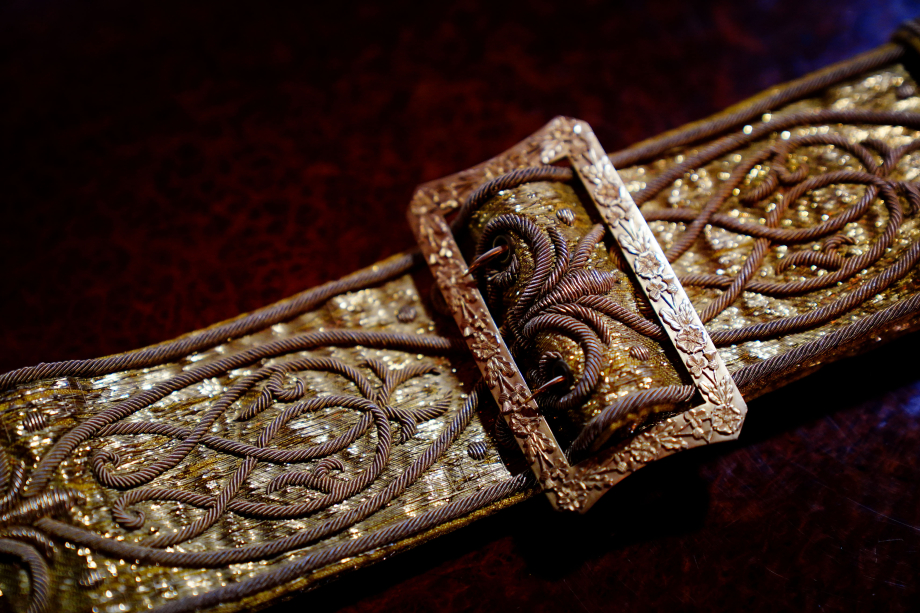
During the Coronation Service, the Sword Belt is placed around the Supertunica. The Jewelled Sword of Offering is then 'girded' or fastened at the Sovereign's waist using the Sword Belt. The Archbishop presents the Sword to the Monarch while saying that it should be used for the protection of good and the punishment of evil. The Sword is then removed and placed on the altar in the Abbey, before the Sovereign is invested with the Imperial Mantle.
Historically the Sword Belt is supplied new by the Worshipful Company of Girdlers for each Coronation. His Majesty has chosen to reuse the Sword Belt made for the Coronation of his grandfather, King George VI, in 1937.
The Sword Belt was made by Wilkinson and Son, Robe Makers and presented by the Worshipful Company of Girdlers in 1937. Ahead of the Coronation, the Royal School of Needlework undertook some minor conservation work on the Girdle, and it was re-presented to His Majesty by the Worshipful Company of Girdlers.
Imperial Mantle
The Imperial Mantle is worn over the Supertunica and is more similar in design to a robe. The Imperial Mantle being used by His Majesty The King at the Coronation was made for the Coronation of George IV in 1821, and has been worn by King George V, King George VI and Queen Elizabeth II. It is the oldest vestment being used in the Coronation Service.
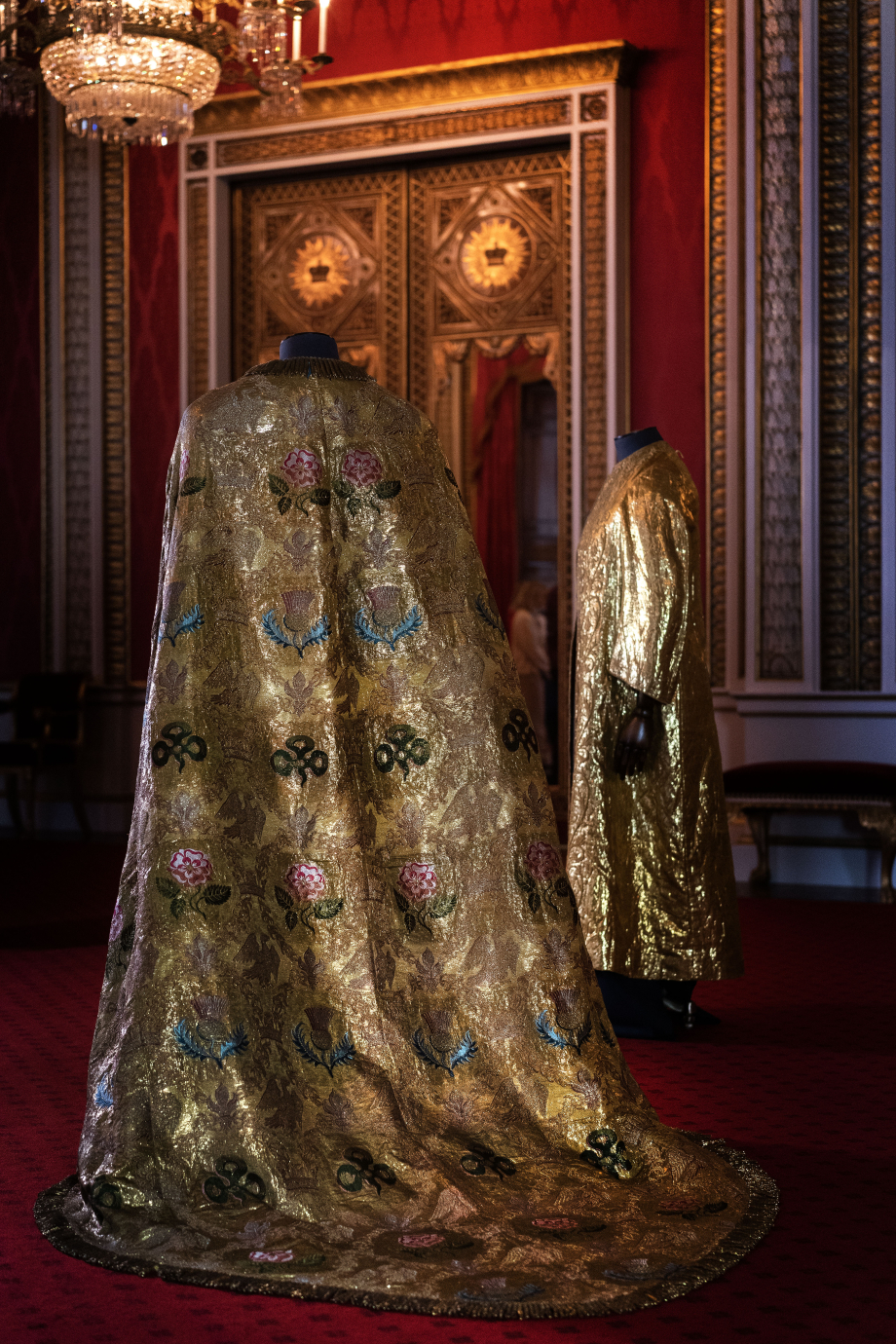
The Imperial Mantle is made of cloth of gold, gold, silver and silk thread, silk, gold bullion fringe and a gold clasp. The cloth of gold is woven with roses, thistles, shamrocks, crowns, eagles and fleurs-de-lis. The gold clasp is in the shape of an eagle, which can also be seen on the newly created Anointing Screen, and in the form of the Ampulla which will hold the Chrism oil.
The Imperial Mantle was made by the tailor John Meyer in 1821 and the Royal Goldsmiths to George IV, Rundell, Bridge and Rundell supplied the gold eagle clasp.
Coronation Gauntlet (glove)
The Coronation Glove or gauntlet is made for the Sovereign’s right hand. His Majesty The King has decided to reuse the Coronation Glove made for the Coronation of his grandfather, King George VI, in the interests of sustainability and efficiency. It was presented by the Worshipful Company of Glovers, made by Dents the glovemakers, and embroidered by Edward Stillwell and Company in 1937. This Glove was conserved by Dents with support from the Worshipful Company of Glovers and re-presented by the Company ahead of the Coronation.
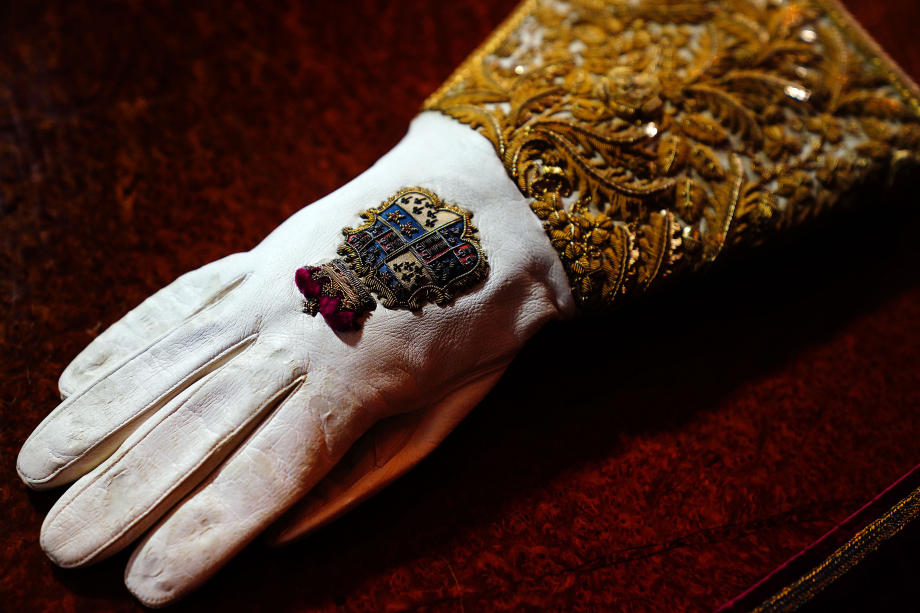
The Glove is worn to hold the Sovereign's Sceptre during the Crowning and then removed before processing to the Throne Chair. During the Coronation Service, the Coronation Glove was presented to His Majesty by Lord Indarjit Singh of Wimbledon.
The Glove is made of white leather and the wrist is embroidered with gilt metal thread, wire and spangles in the form of national emblems including the Tudor Rose, thistle, shamrock, oak leaves and acorns. The back of the hand with an embroidered ducal coronet in red velvet above the coat of arms of the family of the Dukes of Newcastle. The wrist is lined with red satin.
The Coronation Regalia
The heart of the Crown Jewels and housed in the Tower of London where they are kept on public display, the Coronation Regalia are sacred and secular objects which symbolise the service and responsibilities of the monarch. The Regalia have played a central role in coronation services for hundreds of years. As part of the Royal Collection, the Regalia are held in trust by the Monarch on behalf of the nation.
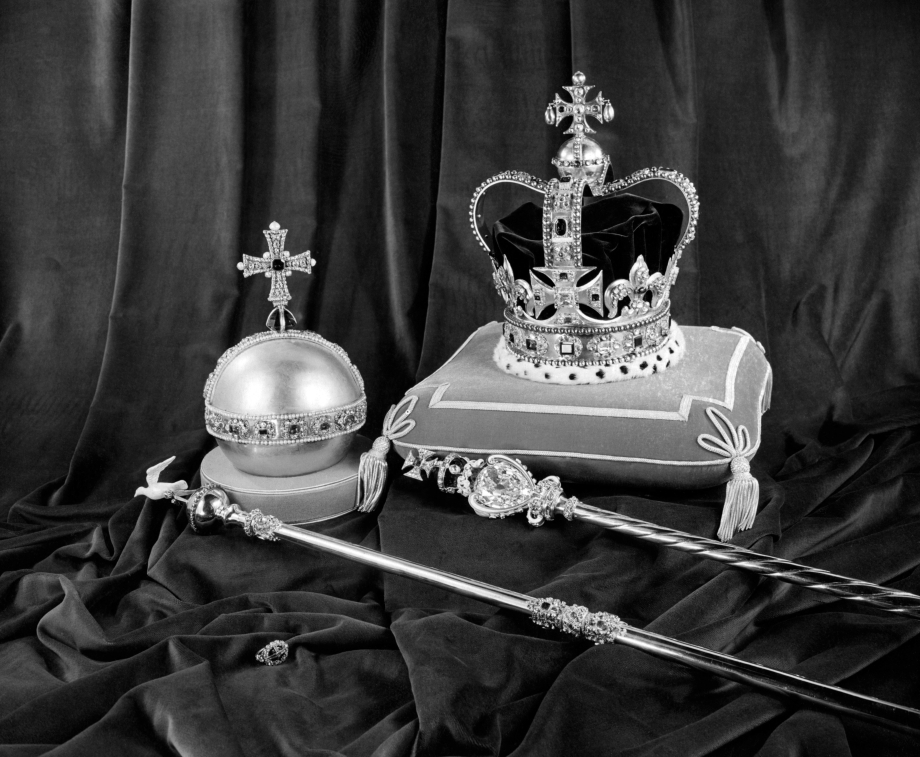
Two Maces, made of silver gilt over oak, date between 1660 and 1695 and are the ceremonial emblems of authority which are carried before the Sovereign at events such as the State Opening of Parliament. Also carried before the Sovereign on formal occasions is the Sword of State, symbolising Royal authority; a steel blade with a silver-gilt hilt, enclosed in a wooden scabbard which is covered in velvet. In 1660 and 1678, during the reign of King Charles II, two such swords were made, the elder of which has not survived. The remaining sword has been used at several Coronations and, in 1969, the Investiture of The Prince of Wales. The sword is carried with the point upwards, and the scabbard carries the coat of arms of King William III.
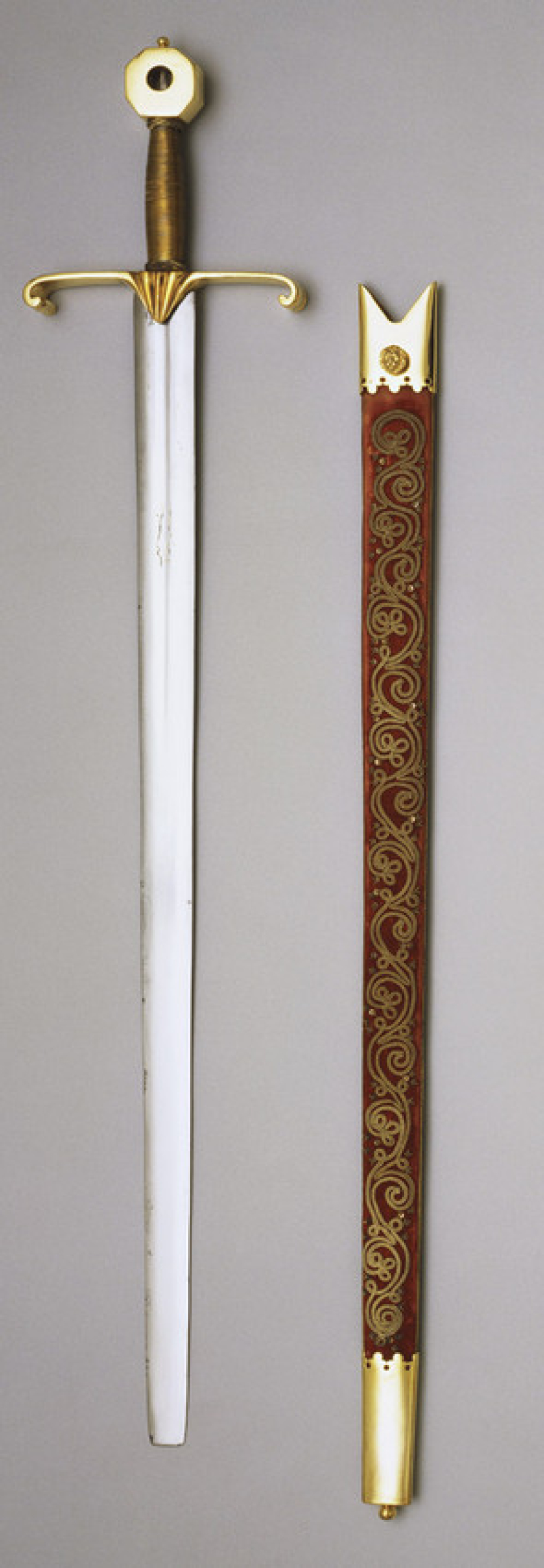
Three further swords were used during the Coronation Procession at Westminster Abbey; the Sword of Temporal Justice, signifying the Monarch’s role as Head of the Armed Forces, the Sword of Spiritual Justice, signifying the Monarch as Defender of the Faith, and the Sword of Mercy or Curtana, which has a blunted tip, symbolising the Sovereign’s mercy. The swords were first used at the Coronation of King Charles I in 1626, and the steel blades date back to the sixteenth century, with early seventeenth century gilt-iron hilts, and wire-bound grips. The three swords are carried without their scabbards, with their points up.
The golden St Edward’s Staff, with its steel spike, was created by the Crown Jeweller, Robert Vyner, in 1661. It derives from an earlier staff which was often referred to as the ‘Long Sceptre’ and carried in fifteenth and sixteenth century Coronation processions as a relic of the royal saint, Edward the Confessor.
The Chrism oil with which The King and The Queen were anointed, which was consecrated in The Church of the Holy Sepulchre in Jerusalem in March, was contained within the Ampulla, made from gold and cast in the form of an eagle with outspread wings. The oil is poured through an aperture in the beak. The Ampulla was supplied for the coronation of King Charles II in 1661 by the Crown Jeweller, Robert Vyner, and is based on an earlier, smaller vessel, which in turn was based on a fourteenth-century legend in which the Virgin Mary appeared to St Thomas à Becket and presented him with a golden eagle and a vial of oil for anointing future kings of England.

The silver-gilt Coronation Spoon is the oldest object in use at Coronations, having been first recorded in 1349 among St Edward’s Regalia in Westminster Abbey, and is the only piece of royal goldsmiths’ work to survive from the twelfth century, having possibly been supplied to King Henry II (1133–1189) or King Richard I (1157–1199). It was used to anoint King James I in 1603, and at every subsequent Coronation. In 1649, the Spoon was sold to the Yeoman of King Charles I’s Wardrobe, who returned it for King Charles II’s Coronation in 1661, when small seed pearls were added to the decoration of the handle. The Spurs were made in 1661 for King Charles II, but the use of spurs at Coronations dates back to King Richard I, the Lionheart, and his Coronation in 1189. The gold, leather and velvet Spurs symbolise knighthood, and they were altered in 1820 for King George IV.
The Sword of Offering was made in 1820, and has a steel blade, mounted in gold and set with jewels, which form a rose, a thistle, a shamrock, oak leaves, acorns, and lion’s heads. The sword is contained in a gold-covered leather scabbard. It was first used at the Coronation of King George IV.
The two Armills are bracelets made from gold, champlevé and basse-taille enamel, lined in velvet, and are thought to relate to ancient symbols of knighthood and military leadership. They have been referred to during previous Coronations as the 'bracelets of sincerity and wisdom'. The Armills date back to 1661 and have been used at every Coronation from King Charles II’s until King George VI’s in 1937. Queen Elizabeth II had new ones made for her Coronation but The King used the originals, last used for His Majesty’s Grandfather.
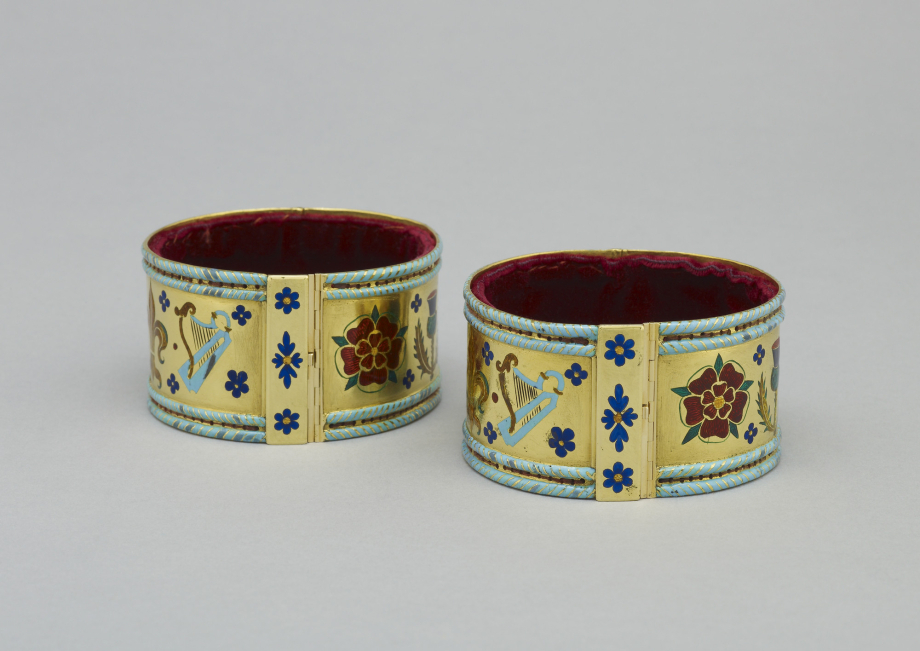
A representation of the Sovereign’s power and symbolising the Christian world, the Sovereign’s Orb was made from gold in the seventeenth century, and is divided into three sections with bands of jewels, for each of the three continents known in medieval period.
The Sovereign’s Ring is composed of a sapphire with a ruby cross set in diamonds. A symbol of kingly dignity, the ring was made for the Coronation of King William IV in 1831, and all Sovereigns from King Edward VII onwards have used it at their Coronations.
The two Sovereign’s Sceptres were used at the Coronation. The Sovereign’s Sceptre with Cross represents the sovereign's temporal power and is associated with good governance. It comprises a gold rod, surmounted by an enamelled heart-shaped structure which holds the Cullinan I diamond.
The sceptre was created for King Charles II, and the Cullinan I was added in 1901. The Sovereign’s Sceptre with Dove, traditionally known as ‘the Rod of Equity and Mercy', represents the Sovereign’s spiritual role, with the enamelled dove with outspread wings representing the Holy Ghost. It was created by the Crown Jeweller, Robert Vyner in 1661.
The St Edward’s Crown was used to crown His Majesty The King, according to tradition. The crown was made for King Charles II in 1661, as a replacement for the medieval crown which had been melted down in 1649. The original was thought to date back to the eleventh-century royal saint, Edward the Confessor – the last Anglo-Saxon king of England. The crown was commissioned from the Crown Jeweller, Robert Vyner, in 1661. Although it is not an exact replica of the medieval design, it follows the original in having four crosses-pattée and four fleurs-de-lis, and two arches. The crown is topped with an orb and a cross, symbolising the Christian world, and is made up of a solid gold frame set with rubies, amethysts, sapphires, garnet, topazes and tourmalines. The crown has a velvet cap with an ermine band. St Edward’s Crown was worn by Queen Elizabeth II at the Coronation in 1953. The crown was removed from the Tower of London to allow for modification work ahead of the Coronation.
The Queen Consort’s Ring, a ruby in a gold setting, was made for the Coronation of King William IV and Queen Adelaide in 1831, and has been used by three further Queens; Queen Alexandra, Queen Mary, and Queen Elizabeth The Queen Mother.
Mirroring the Sovereign’s Sceptre with Dove, the Queen Consort's Rod with Dove is symbolic of ‘equity and mercy’ and the dove, with its folded wings, is symbolic of the Holy Ghost.
The Queen Consort's Sceptre with Cross was originally supplied for the coronation of Mary of Modena, Queen Consort of James II, in 1685 by Robert Vyner, and is inlaid with rock crystals.
Queen Mary’s Crown was chosen by The Queen for the Coronation, marking the first instance in modern times of an existing crown being used for the Coronation of the Consort. Ahead of the Coronation, minor changes and additions to Queen Mary’s Crown were undertaken, such as the as inclusion of the Cullinan III, IV and V diamonds which were part of Queen Elizabeth II’s personal jewellery collection for many years. The design was inspired by Queen Alexandra’s Crown of 1902. Like Queen Alexandra’s Crown, it can be worn without the arches in the form of a circlet, which Queen Mary wore for the Coronation of her son, King George VI, in 1937.
The crown is composed of a silver frame, lined with gold, and set with 2,200 diamonds, mainly brilliant-cut, with some rose-cut. The crown has an openwork band, set at the front with a detachable rock crystal replica of the diamond, Cullinan IV, a large cushion-shaped stone, and a frieze of quatrefoils and rosettes, each with a large brilliant in the centre, surrounded by smaller stones, between borders composed of single rows of brilliants. Above the band are four crosses-pattée and four fleurs-de-lis. The front cross is set with a detachable rock crystal replica of the Koh-i-nûr diamond, the other three crosses are set in the centre with a large diamond each. The eight detachable half-arches each taper towards the top, and terminate in scrolls, and contain six graduated brilliants, between borders of stones. The monde is pavé-set with diamonds and surmounted by another cross with a rock crystal replica of the pear-shaped diamond Cullinan III in the centre. The crown is fitted with a purple velvet cap with an ermine band.
Queen Mary's crown was designed for the Coronation of June 1911. The design was inspired by Queen Alexandra's crown of 1902 which has similarly elegant arches. Queen Mary also wore the crown without its arches as a circlet, in particular for the Coronation of her son, King George VI at the coronation in 1937.
The Imperial State Crown, or Crown of State, is the crown the monarch exchanges for St Edward's Crown at the end of the Coronation Service. The Imperial State Crown is also used on ceremonial occasions, such as the State Opening of Parliament. The term “imperial state crown” dates back to the fifteenth century when English monarchs chose a crown design closed by arches to demonstrate that England was not subject to any other earthly power. This Imperial State Crown was made for the Coronation of King George VI in 1937, but is closely based on a crown designed for Queen Victoria in 1838 by the Crown Jewellers of the time, Rundell, Bridge and Rundell.
The Imperial State Crown is formed from an openwork gold frame, mounted with three very large stones, and set with 2868 diamonds in silver mounts, largely table-, rose- and brilliant-cut, and coloured stones in gold mounts, including 17 sapphires, 11 emeralds and 269 pearls.
At the front of the crown band is the large cushion-shaped brilliant, Cullinan II, the second largest stone cut from the Cullianan Diamond. At the back of the band is the large oval sapphire known as the 'Stuart Sapphire'. The two large stones are linked by an openwork frieze, containing eight step-cut emeralds and eight sapphires, between two rows of pearls.
Above the band are two arches (or four half-arches), each springing from a cross-pattée. The front cross is mounted with a large, irregular cabochon red spinel, known as the 'Black Prince's Ruby'. In its history the stone was pierced for use as a pendant, and the upper hole later plugged with a small cabochon ruby in a gold slip mount. The remaining three crosses are each mounted with a step-cut emerald mounted as a lozenge. The crosses alternate with four fleurs-de-lis, each with a mixed-cut ruby in the centre. Both crosses and fleurs-de-lis are further mounted with diamonds. The crosses and fleurs-de-lis are linked by swags of diamonds, supported on sapphires.
The arches are cast as oak leaves, set with diamonds, each having paired pearl acorns in diamond cups projecting from the sides. At the intersection of the arches are suspended four large pear-shaped pearls in rose-diamond caps, known as 'Queen Elizabeth's Earrings'. The arches are surmounted by a monde of fretted silver, pavé-set with brilliants, with a cross-pattée above, set in the centre with an octagonal rose-cut sapphire known as 'St Edward's Sapphire'.
The crown is fitted with a purple velvet cap and ermine band. Small plates on the reverse of the 'Black Prince's Ruby' and the 'Stuart Sapphire' are engraved to commemorate the history of the crown.
Anointing Screen
The Anointing Screen has been designed and produced for use at the most sacred moment of the Coronation, the anointing of His Majesty The King. The screen combines traditional and contemporary sustainable embroidery practices to produce a design which speaks to His Majesty’s deep affection for the Commonwealth. The screen was gifted for the occasion by the City of London Corporation and City Livery Companies.
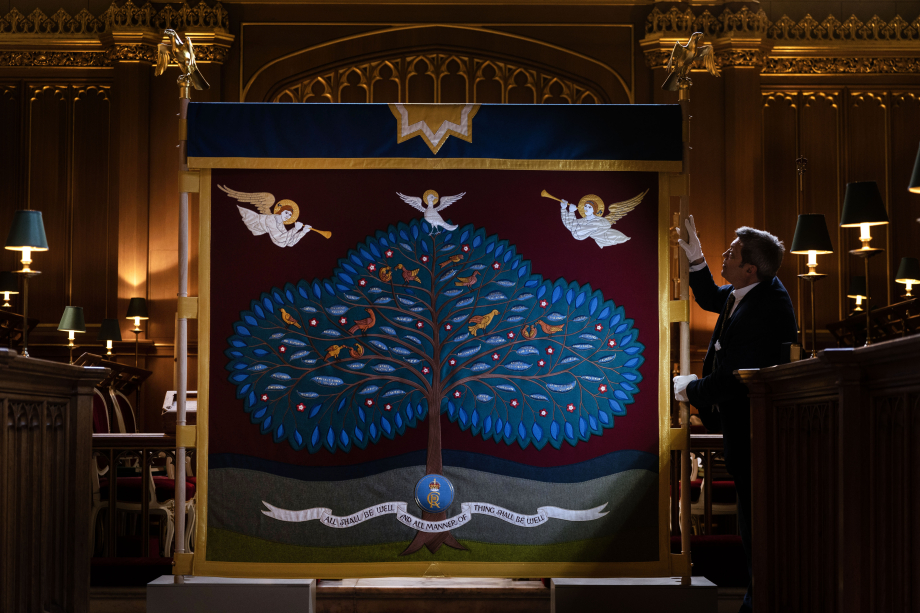
The anointing takes place before the investiture and crowning of His Majesty. The Dean of Westminster pours holy oil from the Ampulla into the Coronation Spoon, and the Archbishop of Canterbury anoints the Sovereign on the hands, chest and head. It has historically been regarded as a moment between the Sovereign and God, with a screen or canopy in place given the sanctity of the anointing.
The Anointing Screen was designed by iconographer Aidan Hart and brought to life through both hand and digital embroidery, managed by the Royal School of Needlework. The central design takes the form of a tree which includes 56 representing the 56 member countries of the Commonwealth. The King’s cypher is positioned at the base of the tree, representing the Sovereign as servant of their people. The design has been selected personally by The King and is inspired by the stained-glass Sanctuary Window in the Chapel Royal at St James’s Palace, which was gifted by the Livery Companies to mark the Golden Jubilee of Queen Elizabeth II in 2002.
The Anointing Screen is supported by a wooden pole framework, designed and created by Nick Gutfreund of the Worshipful Company of Carpenters. The oak wooden poles are made from a windblown tree from the Windsor Estate, which was originally planted by The Duke of Northumberland in 1765. The wooden poles have been limed and waxed, combining traditional craft skills with a contemporary finish.
At the top of the wooden poles are mounted two eagles, cast in bronze and gilded in gold leaf, giving the screens a total height of 2.6 metres and width of 2.2 metres. The form of an eagle has longstanding associations with Coronations. Eagles have appeared on previous Coronation Canopies, including the canopy used by Queen Elizabeth II in 1953. Equally, the Ampulla, which carries the Chrism oil used for anointing, is cast in the shape of an eagle.
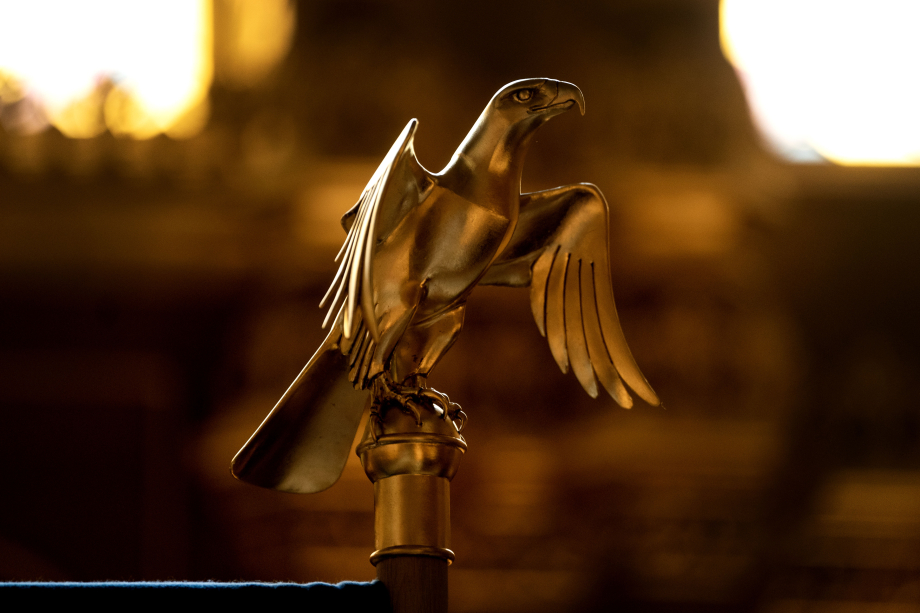
The screen is three-sided, with the open side to face the High Altar in Westminster Abbey. The two sides of the screen feature a much simpler design with maroon fabric and a gold, blue and red cross inspired by the colours and patterning of the Cosmati Pavement at Westminster Abbey where the anointing will take place. The crosses were also embroidered by the Royal School of Needlework’s studio team.
The Anointing Screen was held by service personnel from Regiments of the Household Division holding the Freedom of the City of London. The three sides of the screen were borne by a Trooper and Guardsman from each of The Life Guards, Grenadier Guards, Coldstream Guards, Scots Guards, Irish Guards, and Welsh Guards.
The screen was gifted for the Coronation by the City of London Corporation and participating Livery Companies, the City’s ancient and modern trade guilds. His Majesty The King is a keen advocate and supporter of the preservation of heritage craft skills, and the Anointing Screen project was a collaboration of these specialists in traditional crafts, from those early in their careers to artisans with many years of experience.
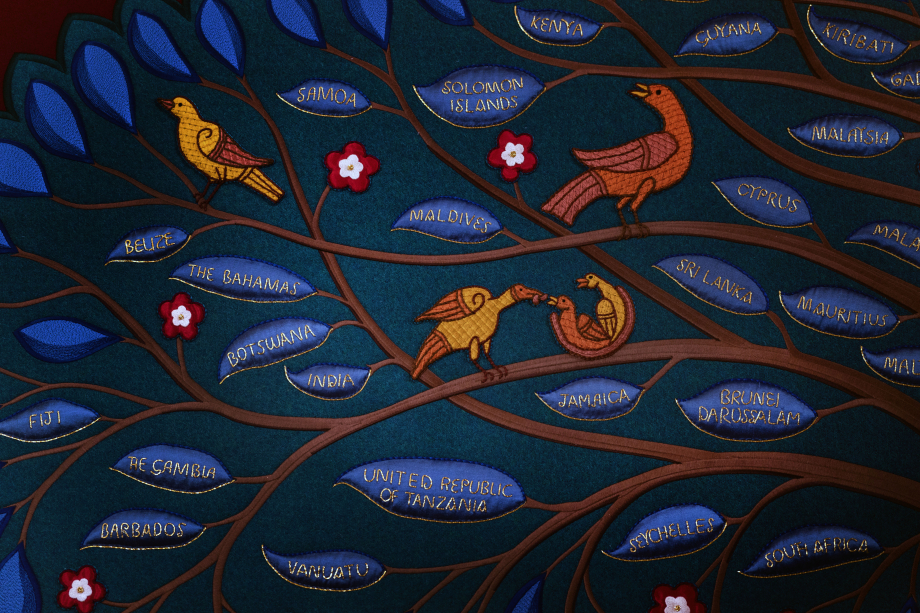
The individual leaves were embroidered by staff and students from the Royal School of Needlework, as well as members of the Worshipful Company of Broderers, Drapers and Weavers.
As well as heritage craft, contemporary skills and techniques have formed part of this unique collaboration. The outline of the tree has been created using digital machine embroidery by Digitek Embroidery. This machine embroidery was completed with sustainable thread, Madeira Sensa, made from 100% lyocell fibres.
The threads used by the Royal School of Needlework are from their famous ‘Wall of Wool’ and existing supplies that have been collated over the years through past projects and donations. The materials used to create the Anointing Screen have also been sourced sustainably from across the UK and other Commonwealth nations. The cloth is made of wool from Australia and New Zealand, woven and finished in UK mills.
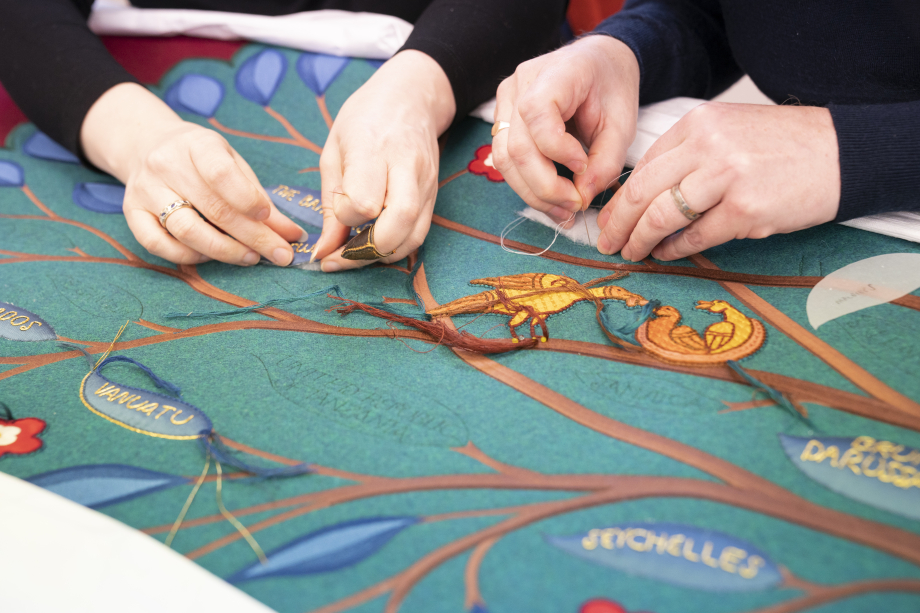
The script used for the names of each Commonwealth country has been designed as modern and classical, inspired by both the Roman Trojan column letters and the work of Welsh calligrapher David Jones.
Also forming part of the Commonwealth tree are The King’s Cypher, decorative roses, angels and a scroll, which features the quote from Julian of Norwich (c. 1343–1416): ‘All shall be well and all manner of thing shall be well’. This design has again been inspired by the Sanctuary Window in the Chapel Royal, St James’s Palace, created for Queen Elizabeth II’s Golden Jubilee in 2002. At the top of the screen is the sun, representing God, and birds including the dove of peace, which were all hand embroidered by the Royal School of Needlework.
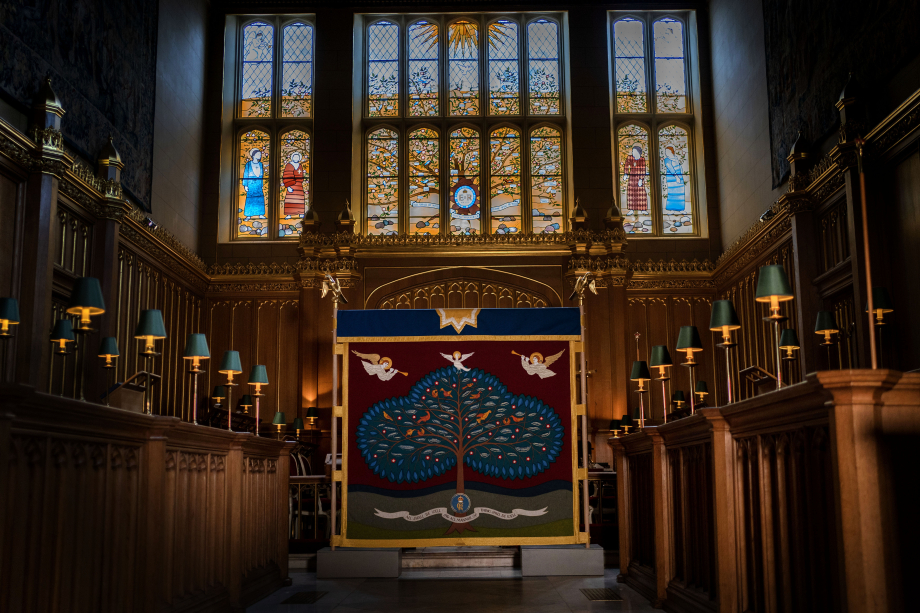
A service of dedication and blessing of the Anointing Screen took place in advance of the Coronation at the Chapel Royal, St James’s Palace, where it was officially received and blessed by the Sub-Dean and Domestic Chaplain to The King, Paul Wright, on behalf of The Royal Household.
Coronation Oil
The Chrism oil, consecrated at a ceremony in The Church of the Holy Sepulchre in Jerusalem, was consecrated by the Patriarch of Jerusalem, His Beatitude Patriarch Theophilos III, and the Anglican Archbishop in Jerusalem, The Most Reverend Hosam Naoum.
The oil was created using olives harvested from two groves on the Mount of Olives, at the Monastery of Mary Magdalene and the Monastery of the Ascension. The Monastery of Mary Magdalene is the burial place of His Majesty’s grandmother, Princess Alice of Greece. The olives were pressed just outside Bethlehem.
The oil has been perfumed with essential oils – sesame, rose, jasmine, cinnamon, neroli, benzoin and amber – as well as orange blossom.
Olive oil comes from the Mount of Olives which demonstrates the deep historic link between the Coronation, the Old Testament and the Holy Land. From the anointing of King Saul through to the present day, Monarchs have been anointed with oil from this sacred place. The formula has been used for hundreds of years and was also used at the Coronation of Queen Elizabeth II. The Chrism oil was used to anoint His Majesty The King while the choir sang Handel’s ‘Zadok the Priest’ during this most sacred moment of the coronation. It was also used for the anointing of Her Majesty The Queen.
Throne Chairs and Chairs of Estate
By tradition, ceremonial chairs and thrones are used for the different stages of the Coronation Service. In addition to St Edward’s Chair (Coronation Chair), which is used for the moment of crowning, The King and The Queen were seated in Chairs of Estate and Throne Chairs at different points during the service.
In the interests of sustainability, Their Majesties chose to use Chairs of Estate and Throne Chairs from the Royal Collection made for previous Coronations. These were been conserved, restored and adapted as required.
The Chairs of Estate were used for the early elements of the Service.
Their Majesties were thereafter enthroned in the Chairs of State (or Throne Chairs).
The King was Crowned in the Coronation Chair (St Edward’s Chair) and The Queen was crowned in Her Majesty’s Chair of Estate.
Chairs of Estate
Her Majesty Queen Elizabeth II used her Chair of Estate during the 1953 service, while the companion Chair of Estate for Prince Philip, The Duke of Edinburgh, was not used at the Service itself but was delivered to Buckingham Palace, where both chairs have been on display in the Throne Room for many years.
The Chairs of Estate are made from carved and gilded beechwood in the seventeenth century style which was used for earlier Chairs of Estate. The cyphers of Queen Elizabeth II and Prince Philip are featured in the carving of the giltwood stretcher joining the front legs, together with the national emblems of a rose, thistle, and shamrock.
The Chairs of Estate were used during the early parts of the Service and for the Coronation of Her Majesty The Queen.
In preparation for the Coronation, Gilding and Furniture Conservators from the Royal Collection Trust cleaned, restored and consolidated the giltwood frames. New silk damask was woven by the Humphries Weaving Company, Suffolk to the same pattern with which they were originally upholstered. This was to allow for the cyphers of The King and The Queen to replace those of Queen Elizabeth II and Prince Philip, which were removed and will be kept in the Royal Collection.
The new cyphers for the Chairs of Estate were hand embroidered by the Royal School of Needlework, and created with cloth of gold, woven with a metal thread. The cloth of gold was then embellished with gold metallic threads. Upon completion, the cyphers were applied onto the silk damask using the appliquè technique. The upholstery was completed by The Royal Household’s upholsterers, including the re-use of the original braid and trimmings.
Throne Chairs
Their Majesties sat in the Throne Chairs for the Enthroning and the Homage. These chairs were made for the Coronation of King George VI and Queen Elizabeth (later known as The Queen Mother) in 1937.
Made by White, Allom and Company, in a seventeenth century style which in turn was based on X-framed Tudor stools. The Chairs were upholstered in crimson velvet and applied with the Royal Arms of King George VI and Queen Elizabeth.
In preparation for the Coronation, the Throne Chairs were conserved by the Royal Collection Trust’s Furniture Conservators. The crimson silk velvet was replaced with new velvet and trimmings and the chairs reupholstered by the firm of AT Cronin Workshop Ltd.
New silk braid and trellis fringe, replicating the original trimmings of the Throne Chairs has been woven by Heritage Trimmings Ltd of Derby. The silk was produced by The Humphries Weaving Company, Suffolk, and the silk for the fringe has been specially dyed by Gainsborough Silks, Suffolk. The Royal School of Needlework conserved the original embroidered coat of arms on His Majesty’s chair before transferring it onto the new velvet.
In addition, the new coat of arms of The Queen has been hand embroidered on Her Majesty’s Throne Chair using the silk shading technique, which has been applied to the new velvet.
St Edward’s Chair (Coronation Chair) Made over 700 years ago, from Baltic oak and first used at the Coronation of King Edward II. His Majesty was crowned King on St Edward’s Chair.
Procession from Westminster Abbey and Buckingham Palace
The Coronation Procession, was much larger in scale, taking the same route in reverse. The Coronation Procession included Armed Forces from across the Commonwealth and the British Overseas Territories, and all Services of the Armed Forces of the United Kingdom, alongside The Sovereign’s Bodyguard and Royal Watermen.
Featuring nearly 4,000 personnel, this major military ceremonial operation was the largest of its kind since the 1953 Coronation of Her Majesty Queen Elizabeth II.
The Coronation Procession represented the diversity and traditions of the UK and Commonwealth Armed Forces. A full-spectrum display of unique and historic uniforms whose designs are in some cases hundreds of years old, flags from across the Commonwealth and 20 different bands – all marching in exact rhythm – demonstrated the very best of the Armed Forces. They guided Their Majesties back to Buckingham Palace, before conducting The Royal Salute.
The Royal British Legion provided a Guard of Honour of 100 Standard Bearers to line the procession route in Parliament Square. The charity’s participation is in line with its support at previous significant royal events. The Standard Bearers represented the RBL and seven other associated Armed Forces charities; The Royal Naval Association, Royal Marines Association, Army Benevolent Fund, Air Forces Association, Royal Commonwealth and Ex Services League, Merchant Navy Association and SSAFA, the Armed Forces Charity.
The route was:
- Broad Sanctuary
- Parliament Square (South and East sides)
- Parliament Street
- Whitehall
- Trafalgar Square (south side)
- Admiralty Arch
- The Mall
- Queen’s Gardens (south side)
- Buckingham Palace Centre Gate
The route was lined by the Armed Forces, Standard Bearers of the Royal British Legion, Uniformed Civilian Services and Youth Organisations.
Standards, Guidons and Colours of the Army, along with the Truncheon of the Brigade of Gurkhas were stationed on the route at the south side of the Queen Victoria Memorial.
A tri-Service Guard of Honour found by the Royal Navy, the Foot Guards and the Royal Air Force, all with Colours and accompanied by a Band of the Royal Marines, were positioned in Queen’s Gardens facing the Forecourt Centre Gate. This was to give a Royal Salute as The King, The Queen, and other Members of the Royal Family passed.
The King’s Life Guard turned out on Whitehall at Horse Guards Front Yard. This was to give a Royal Salute as The King, The Queen and other Members of the Royal Family pass.
The King and The Queen travelled in the Gold State Coach.
The following flanked the Gold State Coach:
- 4 Royal Watermen.
- 4 King’s Body Guard of the Yeomen of the Guard.
The following walked in the Procession:
- The King’s Body Guard of the Honourable Corps of Gentlemen at Arms: 1 Officer, an Officer bearing the Standard with 2 escorts, 12 Gentlemen, 1 Officer.
- The King’s Body Guard for Scotland, the Royal Company of Archers: 1 Officer, an Officer bearing the Colour with 2 escorts, 12 Archers, 1 Officer.
- The King’s Body Guard of the Yeomen of the Guard: 1 Officer, an Officer bearing the Colour with 2 escorts, 12 Yeomen, Deputy Sergeant Major.
- The King’s Bargemaster and 12 Royal Watermen.
- Yeomen Warders of the Tower of London: 1 Officer, Chief Yeoman Warder bearing the Mace with 2 escorts, 12 Yeomen Warders, Yeoman Gaoler.
Carriage: The Gold State Coach
Their Majesties travelled in the Gold State Coach. The coach, last seen during the Pageant of the Platinum Jubilee of Queen Elizabeth II in June 2022, was commissioned in 1760 and was first used by King George III to travel to the State Opening of Parliament in 1762. The coach has been used at every Coronation since that of William IV in 1831. The coach was drawn by eight Windsor Greys and, due to its weight of four tonnes, will travel at walking pace.
The coach has been used at every Coronation since that of William IV in 1831.
The coach, last seen during the Pageant of the Platinum Jubilee of Queen Elizabeth II in June 2022, was commissioned in 1760 and was first used by King George III, to travel to the State Opening of Parliament in 1762. The coach only ever conveys the sovereign, sometimes with their consort. When the Sovereign is being conveyed in the coach, it would therefore only ever be escorted by a Sovereign’s Escort of the Household Cavalry.
The coach was drawn by eight Windsor Greys and, due to its weight of four tonnes, travelled at walking pace. Driven by postilions in full state livery; a postilion was mounted on the left hand (near side) of each pair of horses. Grooms in full State livery walked close to the carriage. Slightly further away from the carriage body, and carrying long polearm called a partisan, walked the Yeomen of The King’s Body Guard of the Yeomen of the Guard (not what is today called a Beefeater, who are a different body within the same corps).
Made of giltwood – a thin layer of gold leaf over wood – the Gold State Coach is the third oldest coach surviving in the UK. It is 3.6 metres tall (significantly higher than normal coaches of this age, so the Monarch can be seen and over seven metres long.
Last fully regilded in 1977 for Queen Elizabeth II’s Silver Jubilee, although in places it bears evidence of between seven and ten layers of gilding and retouching over the past 261 years. When not in use, on public display whenever the Royal Mews is open, and will return to display shortly after the Coronation.
Horses:
The coach was drawn by eight Windsor Greys:
Icon and Shadow; Milford Haven and Newark; Echo and Knightsbridge; Meg and Tyrone.
Members of the Royal Family travelling in the Coronation Procession
The following Members of the Royal Family travelled by Carriage:
• The Prince and Princess of Wales, Prince George of Wales, Princess Charlotte of Wales and Prince Louis of Wales
• The Duke and Duchess of Edinburgh, The Lady Louise Mountbatten Windsor and Earl of Wessex.
• The Duke and Duchess of Gloucester with Vice Admiral Sir Tim Laurence.
• The Princess Royal, as Colonel of the Blues and Royals (Royal Horse Guards and 1st Dragoons), will be Gold Stick-in-Waiting, riding in the Procession.
Gun Salutes
In all four corners of the UK, including at firing stations in Edinburgh, Cardiff and Belfast, Gun Salutes sounded at the moment of The King’s Coronation to celebrate the historic moment.
Featuring more than 400 personnel, across 13 locations and deployed Royal Navy ships, 21 rounds fired in tribute to The King with the exception of The Tower of London and Horse Guards Parade, where a 62 round salute and a six-gun salvo fired respectively.
Royal Salute
Upon returning to Buckingham Palace following the Coronation Service, Their Majesties received a Royal Salute in the Palace Garden from the United Kingdom and Commonwealth Armed Forces who were on parade.
Buckingham Palace Balcony
Following the Royal Salute, The King and The Queen Consort were joined by Members of the Royal Family on the Buckingham Palace balcony to view the military Flypast and conclude the day’s ceremonial events.
The balcony of Buckingham Palace is one of the most famous in the world. The first recorded royal balcony appearance took place in 1851, when Queen Victoria stepped onto it during celebrations for the opening of the Great Exhibition. Since then, Royal Balcony appearances have marked many occasions from Queen Elizabeth II’s annual official birthday celebrations to watch the RAF Flypast at the end of Trooping the Colour, Royal Weddings, Jubilees, as well as special events of national significance such as the 75th anniversary of the Battle of Britain.
Flypast
Military personnel conducted a Coronation Flypast over The Mall in Central London.
The Royal Air Force Aerobatic Team – the Red Arrows – featured amongst the aerial procession.
Related content
A speech delivered by The Queen at a Reception to recognise those who support survivors of sexual assault and to relaunch of the Washbags Project
Thank you for sharing your stories, thank you for your kindness, thank you for not remaining strangers to those enduring the darkest of times, and, most of all, thank you for...
The Queen's speech at a reception to recognise those who support survivors of sexual assault
Your stories and your experiences are vital tools as we seek to bring about change: to forge a world in which people, whoever and wherever they are, do not live in fear of...
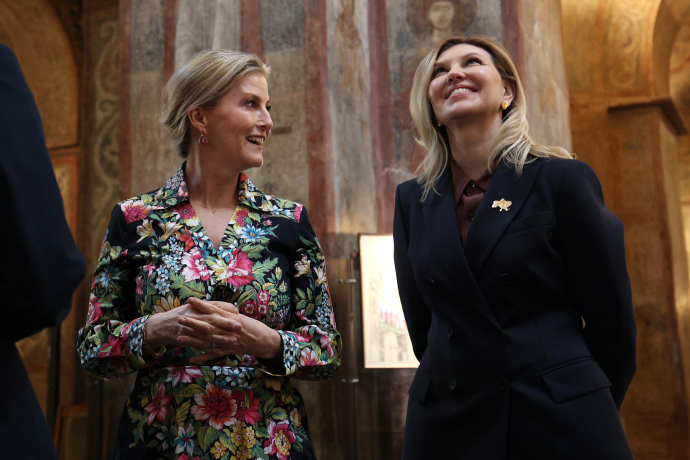
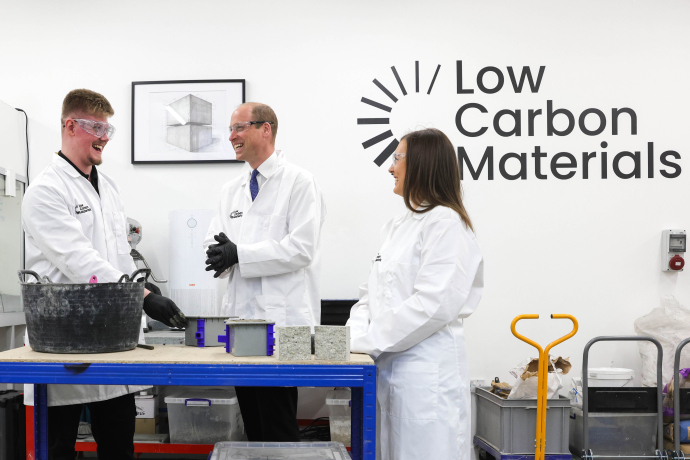
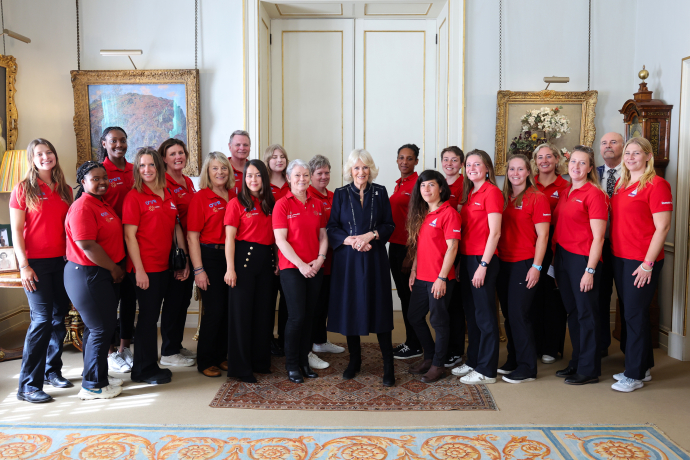
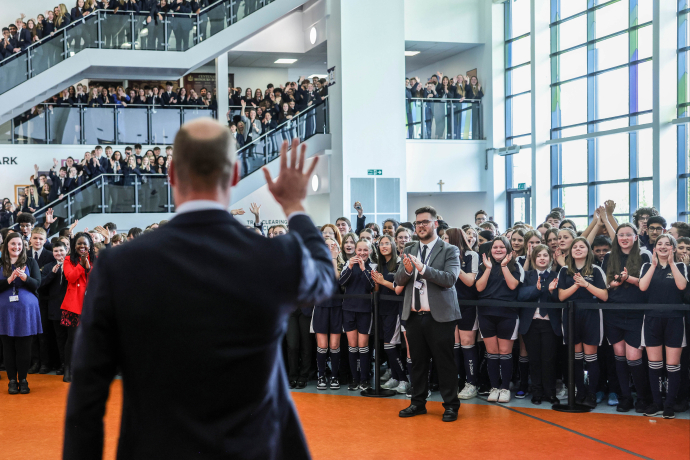
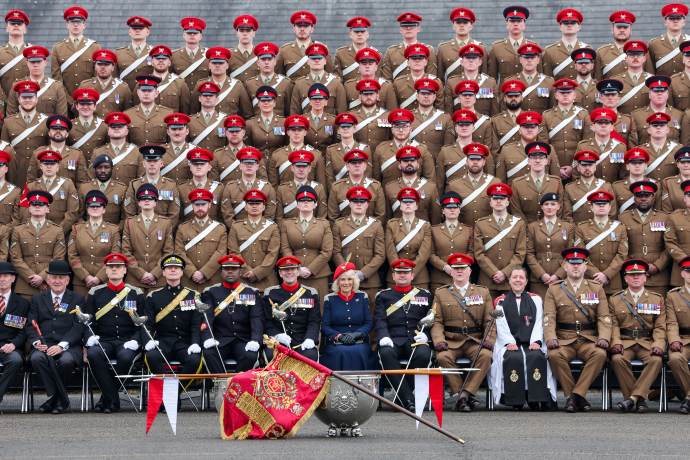
A speech by Her Majesty The Queen on her first visit to The Royal Lancers (Queen Elizabeths’ Own), having been appointed as Colonel-in-Chief
My father described the Regiment as a “highly efficient entity, highly skilled, and full of personalities”, I have no doubt that your upcoming deployments will be...
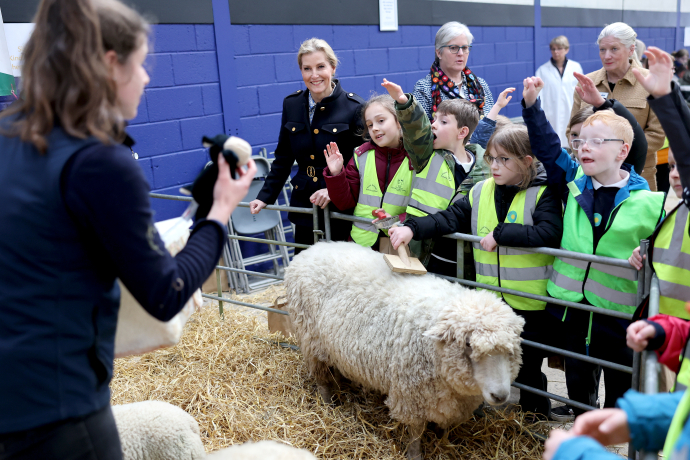
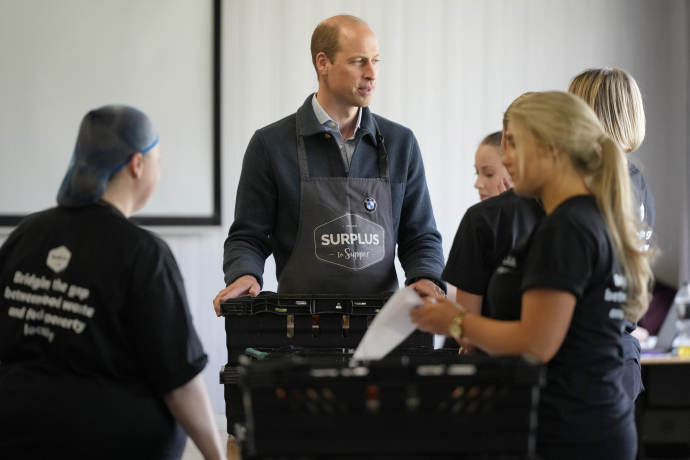
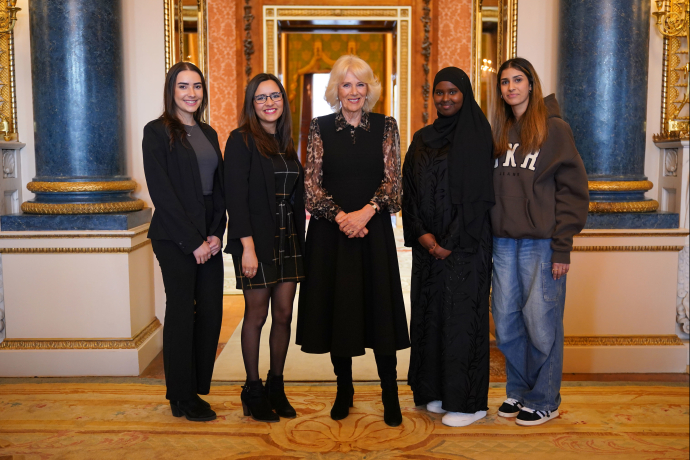
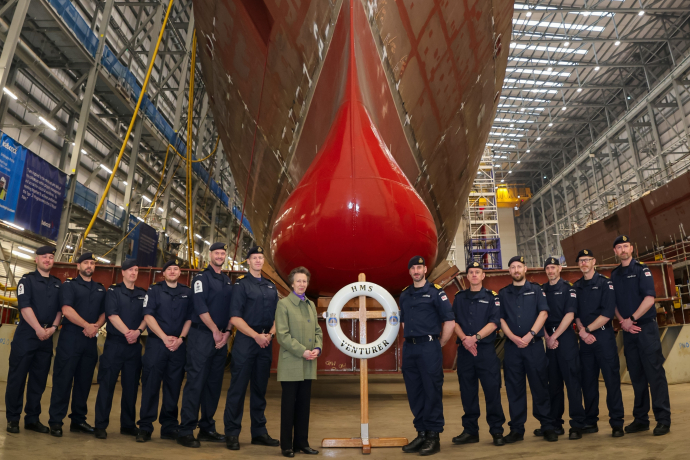
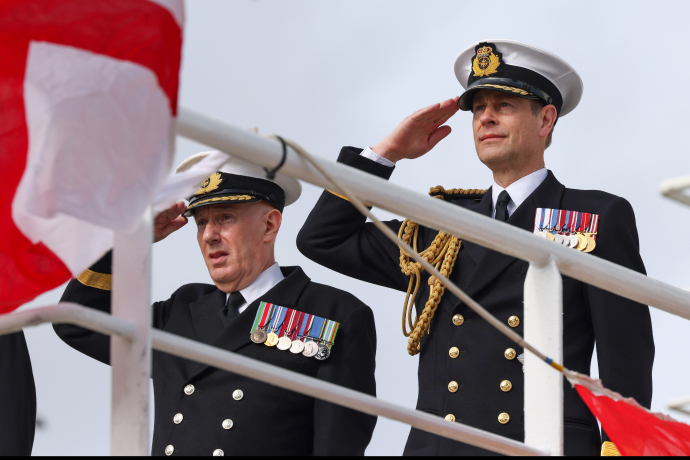
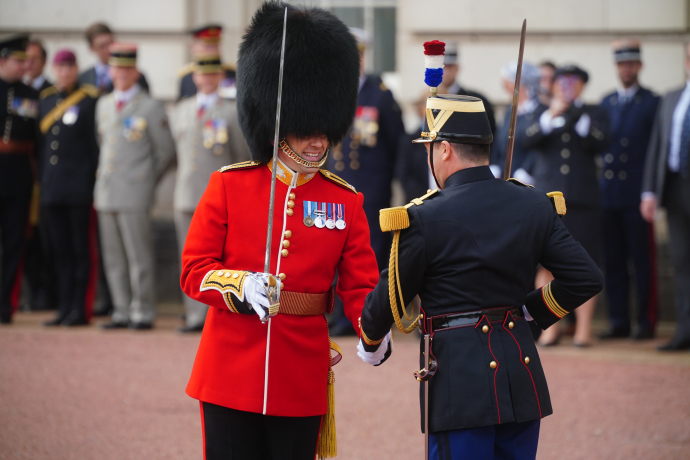
A message from The King on the 75th Anniversary on the Founding of N.A.T.O.
Message from The King for the 2024 Royal Maundy Service
It is my special prayer today that Our Lord’s example of serving one another might continue to inspire us and to strengthen all our communities.
The Queen's speech at a reception to mark the results of The Queen’s Reading Room study
We share a very special bond, ladies and gentlemen – our love of books. Thank you for helping to spread the word.
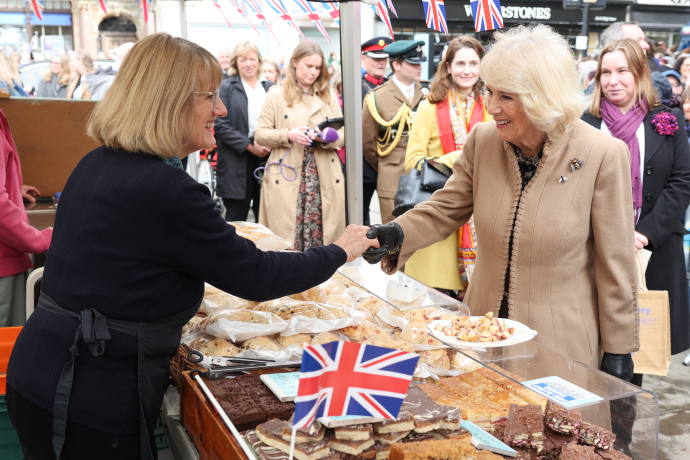
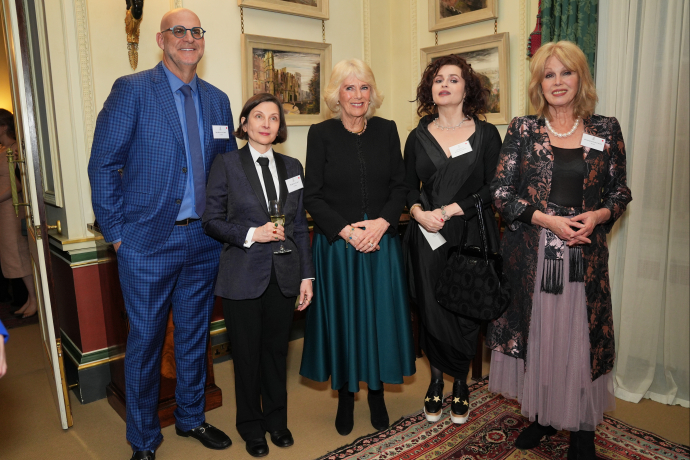
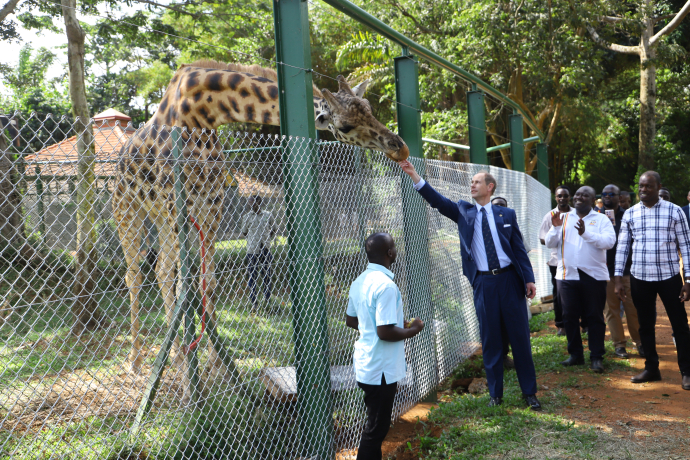
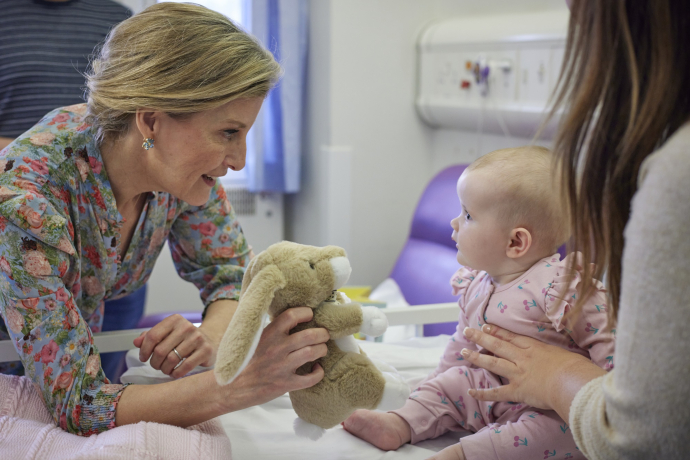
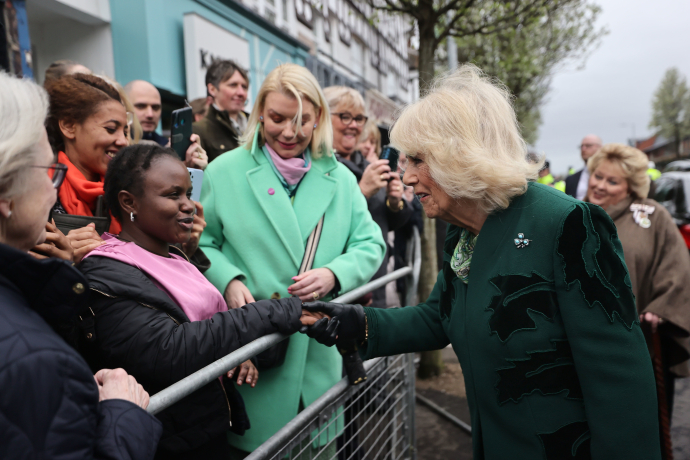
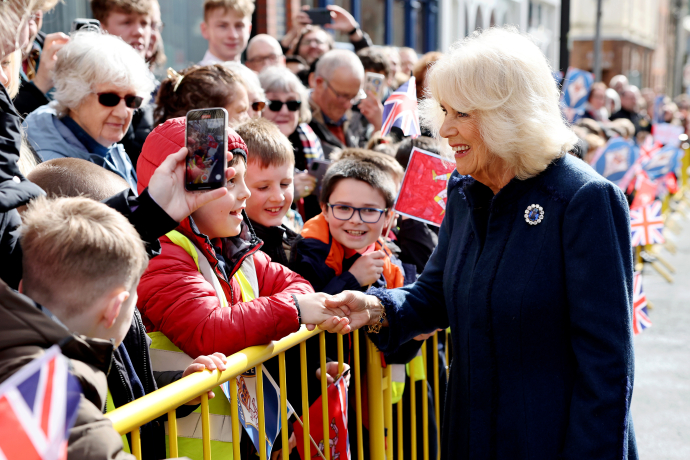
Message from The King to mark the 70th anniversary of the end of the Korean War
It is our duty to remember what was once called “the Forgotten War”.
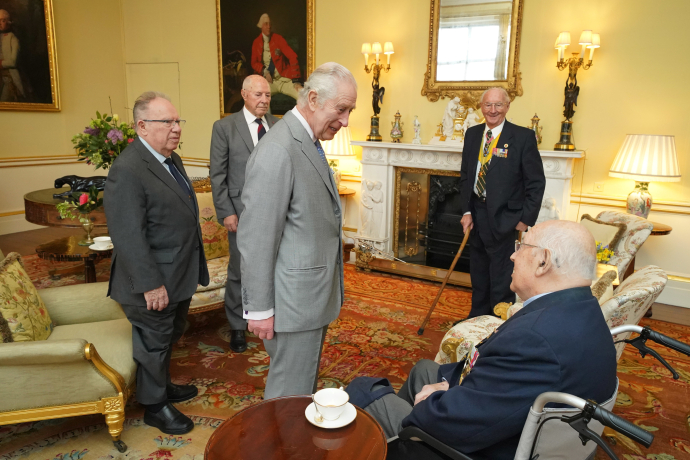
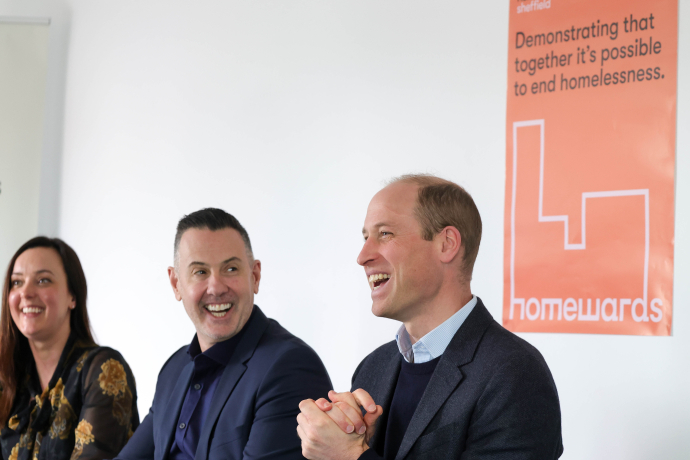
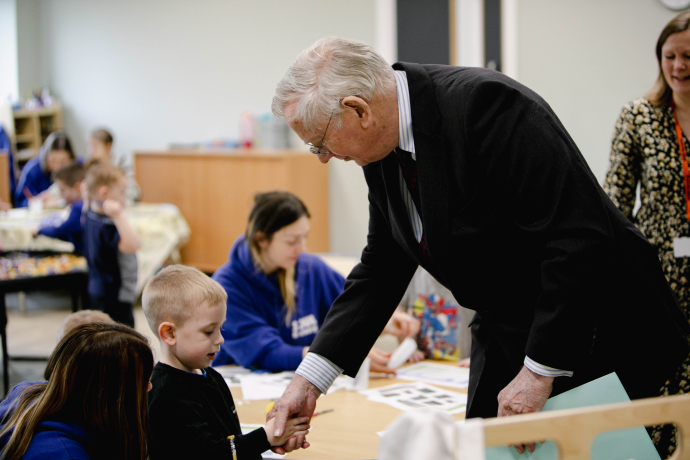
The Duke and Duchess of Sussex
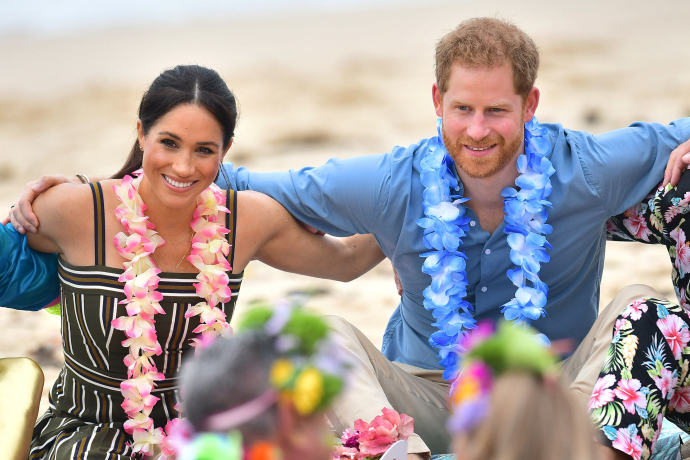
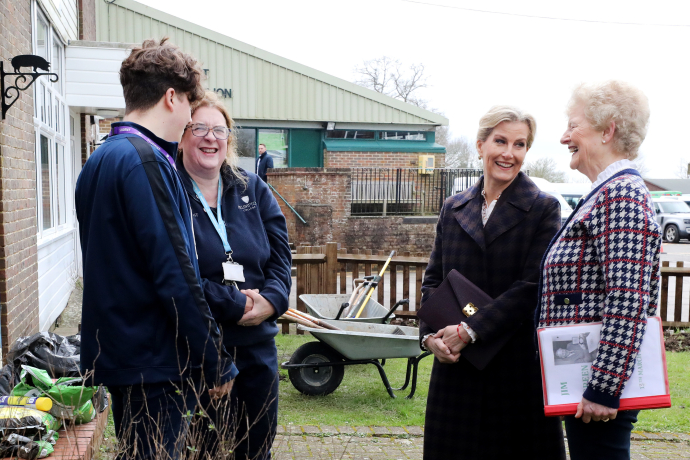
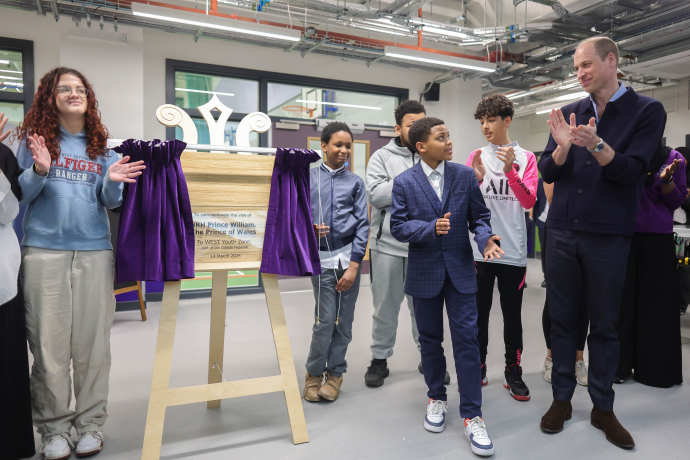
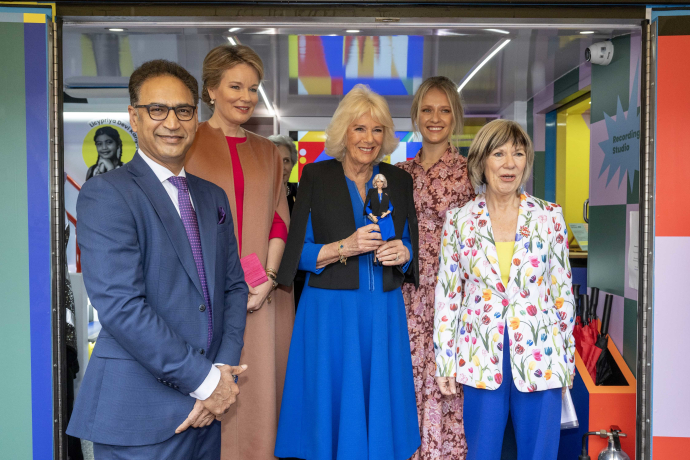
A speech by Her Majesty The Queen at a reception to celebrate International Women’s Day and to mark the end of the WOW Girls Festival Bus tour
Let your lives be the stones that will shatter glass ceilings everywhere and inspire generations to come.
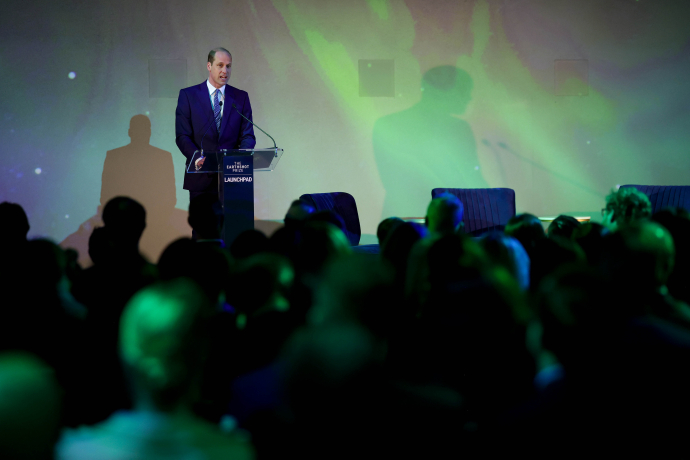
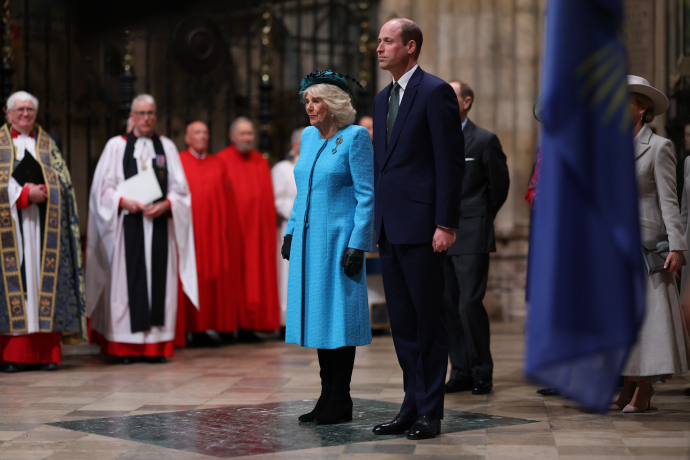
The King's Commonwealth Day Message 2024
The Commonwealth family is strongest when we are connected, through friendship.
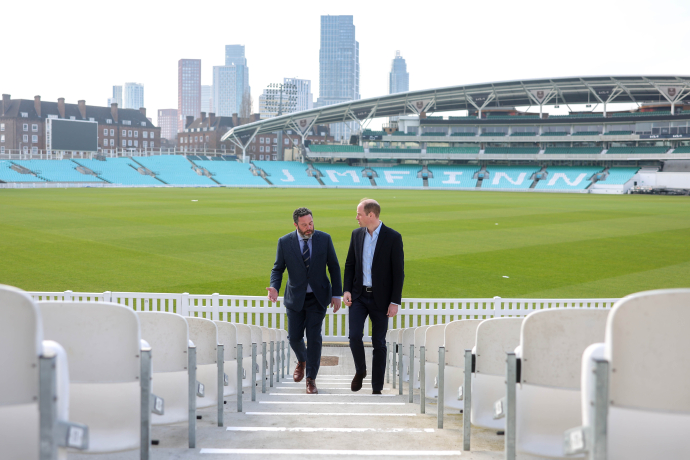
A speech by The Duchess of Edinburgh at the Community Sport and Recreation Awards, at Headingley Stadium, Leeds, ahead of The Duke of Edinburgh’s 60th birthday.
He is the best of fathers, the most loving of husbands and still is my best friend.
A speech by Her Majesty The Queen at the Grand Final of BBC's 500 Words, Buckingham Palace
Between you, you have created more than a million stories of thought-provoking adventure for future generations to study and enjoy. Thank you to everybody who has taken part...
